

Be back soon!
This website is under maintenance. Check back tomorrow!
*If you’re the owner of this website and have questions, reach out to Bluehost. We’re happy to help.
- Enter Costa Rica
- Attractions
- National Parks and Refuges
- Cocos Island
Cocos Island National Park
Cocos Island National Park: Nestled in the vast expanse of the Pacific Ocean, some 330 miles (523 km) off the coast of Costa Rica, Cocos Island National Park, also known as Isla de Coco, emerges as an unrivaled gem. This pristine sanctuary, just 5 degrees north of the equator, holds a unique status, perched a few hundred miles north of the illustrious Galapagos Islands. Established in 1978, the park is a resolute guardian of unparalleled ecological diversity, safeguarding the habitats vital to marine wildlife, particularly pelagic species, including awe-inspiring sharks. Its exceptional significance led to UNESCO's World Heritage Site designation in 1997. Governed by the Costa Rican government, this natural haven expanded its protective embrace in 2011 with the establishment of the Seamounts Marine Management Area, a sprawling sanctuary five times the size of the existing park. Cocos Island, a beacon for scuba diving enthusiasts , has earned its place among the world's premier dive destinations, boasting over 20 mesmerizing dive sites encircling its shores.
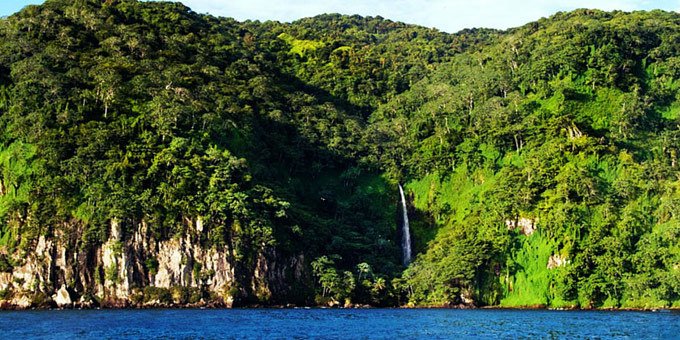
Free Vacation Planning
Cocos island national park: costa rica's subaquatic sanctuary of wonders.
Beneath the Surface: Delve into the depths of the Pacific and uncover the wonders of Cocos Island's underwater realm, a haven where rays, dolphins, and even majestic whales grace your aquatic odyssey. As you explore the warm, azure waters surrounding the island, prepare to be enchanted by a marine ballet of unparalleled splendor. Encompassing Majesty: Cocos Island National Park sprawls across a staggering 199,700 hectares (493,469 acres), a realm that encompasses both the island itself and the protected oceanic expanses that envelop it. This enchanting island spans 2,383 hectares (5,888 acres) and boasts an elevation spectrum ranging from sea level to the majestic summit of Cerro Iglesias, soaring 634 meters above the ocean's surface. The island's interior is a verdant tapestry of mountainous tropical rainforests, adorned with lush ferns, vibrant bromeliads, thriving mosses, and whimsical fungi. Within this landscape, meandering rivers, cascading waterfalls, picturesque valleys, and dramatic cliffs converge in harmonious unity. Marine Marvels: Surrounding this terrestrial Eden lies a marine ecosystem of unparalleled richness, replete with vibrant coral reefs, volcanic tunnels, hidden caves, and the mysteries of the deep. Here, the ocean's symphony is performed by a breathtaking ensemble of diverse species. Yet, with its formidable ocean currents and precipitous drop-offs, Cocos Island's underwater paradise is a realm best explored by experienced divers. Accessible solely via live-aboard boat tours, Cocos Island welcomes those with park ranger permission to explore its captivating shores, though collecting of flora, fauna, or minerals, as well as camping, remains strictly prohibited. Subaqueous Encounters: Underwater enthusiasts will be spellbound by the marine wonders of Cocos Island. Dive into a realm where encounters with white-tip reef sharks and majestic whale sharks are part of the daily spectacle. Over 400 species of coral, an abundance of crustaceans and mollusks, and a mesmerizing array of 300 fish species, including the regal yellowfin tuna and the gentle giant manta ray, coalesce in this mesmerizing aquatic tapestry. Furthermore, the underwater stage sees the grand arrival of humpback whales, pilot whales , playful bottlenose dolphins, and the graceful sea lions. Not to be outdone, hawksbill, green, and olive ridley turtles grace these waters with their presence. Winged Voyagers: Cocos Island's allure extends beyond its aquatic domain, as it beckons avian adventurers with the captivating presence of migratory seabirds. Brown Boobies, Red-footed Boobies, Great Frigatebirds, White Terns, and Brown Noddies elegantly grace the skies. On terra firma, seven species of land birds, including the endemic Cocos Cuckoo, Flycatcher, and Finch—cousins to Darwin's famed finches of the Galapagos—add to the island's ornithological wonder. While two endemic lizard species, an anole and gecko, inhabit the island, amphibians remain elusive. Nonetheless, over 400 species of insects complete this vibrant ecosystem. Cocos Island's wildlife, having evolved in splendid isolation, has given rise to unique endemic species found nowhere else on Earth. A Legacy of Legends: Cocos Island harbors a treasure trove of legends and mysteries, rooted in its captivating history. As the backdrop for documented pirate activity, the island is said to conceal hidden pirate treasure, luring countless adventurers in search of these fabled riches. While small caches have been unearthed, Cocos Island continues to captivate with its enigmatic allure. It is widely believed that Robert Louis Stevenson's "Treasure Island," the desert island in "Robinson Crusoe," and the fictional Isla Nublar in "Jurassic Park" all found inspiration in the mystique of Cocos Island. However, the island faces a pressing challenge in the form of invasive species, such as pigs, goats, and rats, introduced by 18th-century whale hunters. These creatures continue to threaten native species, underscoring the ongoing battle to preserve this ecological jewel.
Cocos Island Facts
Region : Pacific island Closest town : None Size in hectares : 199,700 (493,469 acres) Year established : 1978 Elevation in meters : 0 – 634 (0 – 2,080 feet) Private managed : no Government managed : yes Rangers station : yes Overnight facilities : no Public restrooms : no Entrance fee : $50 Days : daily Hours : 08:00 - 15:30 Hiking trails : no Boat tours : yes Average temperature range in Fahrenheit : 70 - 90 Average yearly precipitation in millimeters : 7,000 Habitat : coral reef, rainforest, beach
From the port of Puntarenas, it is a 32-36 hour boat ride to Cocos Island. Live-aboard boat tours often incude transport to Puntarenas from your hotel in San Jose.
Weather and packing
The climate of Cocos Island is humid and tropical. Temperatures remain the same nearly year round with average day time highs in the upper 80s to low 90s and night time lows in the 70s. Average annual rainfall is 700cm/ 275 inches. Precipitation is high throughout the year, although lower from January through March and slightly lower during late September and October . Depending on your diving preference, calmer seas and better visibility are found between January and May . However the rainier months of June through December are a better time to dive with hammerhead sharks. Annual visitation to Cocos Island is about 1100 people, mainly between March and May.
Visitors should pack a bathing suit, towel, shorts, tee shirts, appropriate shoes, rain gear, sun block, and insect repellent.
Fun Fact: Due to the abundance of documented Pirate activity in the area, Cocos Island is believed by many to be a place to find pirate treasure.
Latitude: N 5° 31' 40.65" Longitude: W 87° 3' 26.71"
Unsure of what to do? Let us make you a free custom trip plan!
Find out why we love diving Socorro in May & June
Socorro is always stunning, raw and primal but spring is special

Cocos – Island of the Sharks
August – Mid-September
10 Days / 9 Nights 11 Days / 10 Nights
US$5,095 pp. dbl occ.
Destination Overview
Cocos Island Costa Rica – Island of the Sharks
Cocos—just the name elicits a knowing smile from experienced divers. Known as the ‘Island of the Sharks,’ it’s not just about the famous schooling hammerheads where the sharks come to you, but a tiny tropical rainforest oasis in the eastern Pacific. Here, you’ll encounter loads of white-tip reef sharks, marble rays, tiger sharks, and the ever-fascinating lobster and octopus. Of course, there are schools of juvenile horse-eyed jacks and hundreds of creole fish gathering together.
Cocos is pure magic for experienced divers, and going ashore adds an adventure of its own. Here’s an insider tip: don’t miss the suspension bridge constructed from repurposed fishing gear seized from illegal fishers. As a bonus, the 2024 expedition coincides with the peak season for humpback whales, offering a good chance of in-water sightings.
Peak Season Diving
Rainy season is the peak season for diving in Costa Rica. Best vis. Best animals. Best diving! We encourage you to visit between mid-May to November.
Don’t be fooled by the term “rainy season,” as it doesn’t hinder your adventure. Typically, the days are filled with sunshine until the afternoon, when clouds roll in and rain showers pour for an hour or two, often accompanied by a fantastic lightning display. Afterward, the skies clear up again for the night.
Sample Itinerary
¡Bienvenidos a Costa Rican! Upon arrival at SJO (San Jose International Airport), we recommend either taking the short connecting flight on Sensa Airlines direct to Golfito. Alternatively, for more of an adventure, consider renting a car for the 6-hour drive and adventure driving down to Golfito. We highly recommend arriving in Golfito at least several days early to take advantage of pre-trip extensions. Located a few kilometres north of Golfito is the magnificent Piedras Blancas National Park, which, like so many other parks in Costa Rica, is almost bursting at the seams with an astonishing array of wildlife. Our concierge team will happily assist with hotel and resort recommendations.
Day 1: We will confirm the marina where the ship is located several months before your departure date. Boarding is at the marina at 7 pm, and the ship will sail at 8 pm. Knowing that most of our guests have to check out of their hotel or resort around noon, you are welcome to drop your gear off any time this afternoon. However, please note that our crew will be working super hard to get your ship ready for you and will not be able to accommodate early boarding. We plan to sail at 8 pm for the 30-33 hour crossing to Cocos.
Day 2: Your ship is a heavy steel stabilized oceangoing ship, ensuring you the best ride possible. We encourage you to relax, and it’s usually a good idea to take some anti-seasickness medicine just in case. It’s far better to feel 100% and enjoy the crossing than to risk feeling under the weather without medication… There will be ample time for briefings, setting up dive and camera gear, and, of course, cocktail hour at 7 pm with all our other guests!
Days 3 – 9 (11 days / 10 night trips get an extra day at Cocos!): \ Anchored in the lee of Cocos Island!! Enjoy some of the best diving in the world on the pinnacles surrounding cocos. The choice of dive sites is at the discretion of the park rangers and influenced by Mother Ocean, with a lot of input from your captain and dive guides. Typically, there will be an opportunity for 2 dives in the morning and 1 in the afternoon, with water temps ranging from 78 – 82°F (27 – 28°C). Plus, there’s the opportunity to go ashore several times, whale watch with the humpbacks, relax, and have a great time!!
Day 10: Last day at sea: We will be making our way back to Golfito, packing gear up, visiting with new friends, and planning your next adventure!
Day 11: Final day: Early arrival in port around 5 am for those who want to catch the early flight on Sensa Airlines to connect with the same departure home from SJO. For everyone else, disembarking is at 8:30 am after a leisurely breakfast onboard.
Frequently Asked Questions
Cocos island of the sharks – faqs.
What dive experience is needed? 50 logged dives and advanced open water is the bare minimum experience required to safely dive around Cocos Island. More experience is better and all divers should have good buoyancy skills. The diving can be challenging. There could be strong current on some dives. Some of the dive sites are in open water and exposed to the swell. The difference between Cocos and a destination such as Socorro is that there is no navy base or airstrip on the island which means that airplane medevac is not possible. If you have a medical issue, the boat will have to return to port or at least be met part way by fast boat. For all these reasons, these trips are best suited for good experienced divers. Don’t worry if you don’t feel that you are quite ready yet for Cocos!! Come and visit us in Baja, Sea of Cortez and Socorro and we will get you all tuned and tweaked up for this great adventure!!!
Do I need to dive with a dive guide? Yes. At Cocos, current and visibility can change dramatically within several hours. If you were to surface unexpectedly mid-dive, there is the possibility of drifting away and needing to use your Nautilus LifeLine to get rescued. In addition to those challenges, local tiger sharks can show erratic behaviour around your safety stop at 15 feet and it’s very important for our dive guides to keep a watchful eye on them. For all of these reasons, Cocos is a dive destination in which guests have to stay with our dive guides. Our dive guides are highly experienced and excellent and they will do their best to give you all the freedom and headspace you might be looking for in your diving, and of course, we are very focussed on giving shooters what they need (sorry, bad pun). Ultimately, your captain and dive guides are the final authority on whether a guest can do a specific dive or not.
What are your safety protocols? Safety, excellence in guest experience and happy staff and crew are the cornerstones of our business. Nothing is more important than your safety. At Nautilus, we are proud to be the only dive operation in the world with ISM certification and external annual audit of an SMS (Safety Management System). This is the same certification as the largest cruise ships on the oceans. We operate within written processes, procedures and checklists that our captains and crew are trained into both initially and annually. Every dive starts with a briefing on a white board. We require that all divers carry LifeLines marine rescue GPS, SMBs and dive alerts. We will loan you one of ours if you are missing any of this safety equipment. We carry AEDs and extensive medical kits with a contract medical officer available shoreside via our sophisticated satellite communication system. NOTE: because of the remoteness of Cocos Island, we highly recommend a medical checkup before leaving on this trip.
How many dives can I expect? Your dive schedule may vary according to weather, other dive boats and where the action is. You can generally expect 2 dives in the morning and 1 in the afternoon. Entry into the park is restricted and tightly controlled for diving allowing for not more than 65 divers in the park at any one time. An 11 day, 10 night trip provides for 7 dive days.
Is there nitrox onboard? Yes, and it’s highly recommended for all divers. The cost is US$ 120 per trip.
Water temperature? 78- 82 °F (27 – 28 °C).
Are the boats camera friendly? YES, VERY! Ask about rental cameras and photo pro services.
What airport do I fly into? SJO.
How do I get to the ship? TBA
What time can I board the ship? TBA
What time do we disembark? TBA
What dive gear do I need to bring? We provide aluminum 80 cu. ft tanks and weightbelts. Larger steel rental cylinders are available. 5 mm wetsuit recommended to avoid losing body core temp during multiple days of repetitive diving. It’s always better to layer down rather than be cold with no options. We have rentals onboard by prior arrangement for almost anything you need. Please make any rental requests as early as possible.
What to Expect
What’s the weather like and what clothes should I bring? Well, it’s the rainy season in the tropics!! We recommend casual and cool attire onboard (t-shirt and shorts). It can be drizzly in the afternoons and we recommend bringing a windbreaker and a fleece vest or sweater just in case. Make sure you bring good shoes if you are interested in going ashore for a hike. It’s spectacular onshore. Just wait until you see the waterfalls!
Is there internet and WhatsApp onboard? Yes. Internet and WhatsApp connection are available for $120 per trip. Please keep in mind that a satellite tracking system at sea only gives limited speed internet access. You won’t be able to stream Netflix!!
What’s the crossing like? It’s an open ocean crossing to Cocos Island Costa Rica. It can be smooth or it might be rough or more likely, something in-between. The Explorer is our flagship that has steamed through everything, from the current-swept chilly waters of Alaska to adventuring down to Clipperton Atoll, just north of the equator. We highly recommend the scopolamine “patch” and a glass of red wine to relax and have a snooze on the crossing. During the trip, we anchor in the calm anchorage behind Cocos.
Is there a fuel surcharge? Of course not! We figure that dive boat companies that with fuel, surcharges year-in, year-out are just taking an extra fee onto the trip.
What’s an appropriate crew tip? US$ 400 – $500.
Get Inspired!
Get Inspired
Watch our costa rica videos.
Nautilus News
Search nautilus website:.

Cocos Island National Park
This national park was declared a World Heritage Site by UNESCO in 1997 for its unmatched natural beauty and rich biodiversity. The island is located between parallels 530' and 534' and meridians 8710' and 876' The blue-turquoise water is extraordinarily clear and makes a great habitat for an abundance of marine life, making this island one of the most extraordinary places in the world for diving. It also has beautiful evergreen forests and numerous impressive waterfalls. For visitors, there is an information center, a park ranger’s station, trails, signage, restroom services, potable water and several lookout points.
Planning your Trip to Costa Rica
Suggested itineraries
Accommodations
Restaurants
Other Activities
Local Travel Agencies
Travel Tips
#EssentialCostaRica
Share your experience, .

Cocos Island National Park
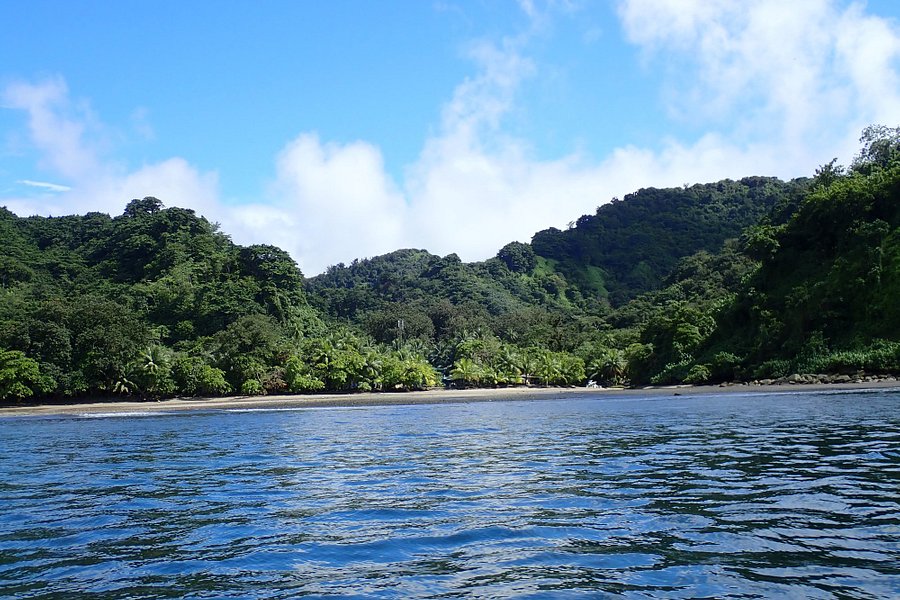
Top ways to experience nearby attractions

Most Recent: Reviews ordered by most recent publish date in descending order.
Detailed Reviews: Reviews ordered by recency and descriptiveness of user-identified themes such as wait time, length of visit, general tips, and location information.
Also popular with travelers
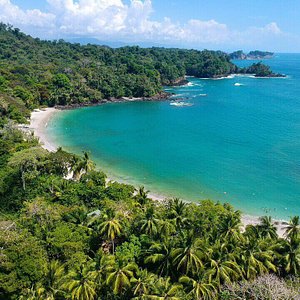
Cocos Island National Park - All You Need to Know BEFORE You Go (2024)
- All Destinations
- National Parks
- The Pacific
- TRANSPORTATION
- Cost of Living
- Costa Rica Education
- Health Care
- Work in Costa Rica
- Residency Overview
- Restaurants
- 15 Day Weather Forecast
- Weather Regions
- Dry Season vs Wet Season
- Holiday & Festivals
- National Flag
- Customs & Etiquette
Real Estate
- Featured Properties
- Local Real Estate
- Before you buy
- Real Estate FAQs
- Find my Property
- Find my Rental
- Tres Leches
- Rice with Chicken
- Cheese Beans Turnover
- Gallo Pinto
- Costa Rican Food
- Before Doing Business in Costa Rica
- Setting up a Corporation
- Demographics
- Economic Indicators
- Jun. 29-Jun. 29 Saints Peter and Paul Day
Travel Blog
- My First Cup of Coffee
- Top Six Extra Things to Pack on Your Next Trip Abroad
- Ten Things to do on the beach in Manuel Antonio
- Eating Alone in Costa Rica
- Nosara Yoga: Switching the Channel
- Riding a bus to Sierpe in Costa Rica
- High speeds, high waves, high in the air over Manuel Antonio
- In-shore fishing off the coast of Manuel Antonio
- Enjoying Puerto Viejo on $28 a day
- How conservation saved Tortuguero
Living in Costa Rica Blog
- Protecting the kinkajous in Manuel Antonio
- Learning Spanish at Rancho Margot
- Backyard Surf Series on Hermosa Beach
- Life in the Monteverde Countryside
- Border Crossing: Nicaragua by Boat
- The Top 5 Reasons I love living in Tamarindo
- A Look Back: Tamarindo, Six Months Later
- Fruit of the Month: Cas
- E-Voting Info for American Expats
- Naturalized Costa Rican Citizenship by Marriage
- Red Eyed Tree Frogs
- White-faced Monkeys
- Scarlet Macaws
- Leatherback Sea Turtles
Itineraries
- 6 Day Best of Activities
- 10 Day Nature Lovers
- 15 Day Best of Destinations
- 12 Day Honeymoon
- 5 Best Waterfalls
- Spectacular Beaches
- Best of Activities
- Best Kept Secrets
- Best of Destinations
- Sky Trek Canopy Tour
- Celeste River Waterfall
- Superman Canopy Tour
- Tortuguero Canal Tour
- Journey to Cocos Island
Medical Tourism
- Dental Care
- Book a Medical Vacation with Us
- Cosmetic Surgery

Cocos Island National Park
Quick facts.
- Location : Pacific Ocean, 340 miles from Puntarenas
- Altitude : 2,080 feet above sea level
- Area : 5,706 acres and 240,171 maritime acres
- Telephone : 2233-4533 or 2283-0022
- Entrance Fee : $25.00
Serpentine coastline, roaring waterfalls, lush rainforest, and sparkling beaches define picturesque Cocos Island, set 340 miles off Costa Rica's southwestern coast. The island's accolades read like a list of superlatives: it is a UNESCO World Heritage Sight, nominated as one of the New Seven Wonders of the World, and designated a Wetland of International Importance under the Ramsar Convention. The beauty of Cocos Island has inspired man for centuries. It has been called "the most beautiful island in the world" by Jacques Cousteau and served as inspiration for Robert Louis Stevenson's Treasure Island and Michael Crichton's Jurassic Park.
Today the island is known as a rich, natural resource, but it was once considered rich for another reason: pirate booty. Cocos Island was an important base for sailors and cartographers since the early 1500’s, and legendary pirate kings like William Davis (1684) and Benito Bonito (1819) are rumored to have buried their treasure here.
Costa Rica acquired Cocos Island in 1869. Between 1872 and 1874, the Costa Rican government ran a prison on the island; it also funded its own treasure-hunting expedition, but no golden doubloons were uncovered. In 1898, naturalists Anastasio Alfaro and Henri Pittier visited the island and suggested it be treated as a protected area.
In 1978, it was designated a Costa Rican national park, part of the nation’s heritage and an important natural resource. Cocos Island is the only point above sea level in Cocos Ridge, a geological line of submerged volcanoes that runs from Costa Rica to just north of the Galapagos Islands. Of volcanic origin, the island’s mineral-rich soil supports tropical lowland ecosystems and a high-montane cloud forest.
Just off the island’s shores, the Pacific Ocean teems with reefs and marine life. It is home to what is probably the largest scalloped hammerhead cleaning station in the world, which attracts these prehistoric creatures by the hundreds. Cocos Island is a crucial habitat for other large pelagic species like dolphins, giant manta rays and at least eight types of sharks.
Cocos Island National Park encompasses the entire island, protecting its lands and waters. It is Costa Rica’s most secluded and least visited national park and can only be reached by a 36-hour boat ride. Home to some of the country’s most stunning scenery and rare wildlife, Cocos Island is well worth the lengthy trek.
Cocos Island is almost entirely covered in rainforest and sees rain most days. There is a short “drier” season from January through March.
Annual Rainfall: 250 inches Temperature: 75º F to 85º F average Ocean Temperature: 84º F to 86º F average
Activities:
Snorkeling and Scuba Diving: Brimming with vast seascapes and copious amounts of wildlife, Cocos Island National Park is considered one of the world's top ten scuba diving destinations. The quality and quantity of marine animal sightings is unprecedented, creating a diver’s paradise – particularly for shark divers. The undisturbed waters and rocky pinnacles surrounding these shores attract scores of hammerheads, white tip reef sharks, jacks, and rays as well as at least 32 types of corals, 57 crustaceans, 118 mollusks and 250 fish species.
Ten-day scuba safaris with private tour companies are available for experienced divers. Divers live on cruise ships that anchor offshore, and the diving takes place off smaller speedboats that hold up to ten divers each. Trips usually include three dives per day, but night dives are available for those who seek extreme underwater adventures. The best time to see large groups of hammerhead sharks is during the rainy season, from May through late November. Visibility is better and currents tamer during the dry season months of January-April.
Volunteer Work: Volunteers are invited to the island to complete tasks from cooking and cleaning to clearing brush and trailblazing. Stays range from one to two months. Meals, lodging and transport from Puntarenas are completely free of charge in exchange for about 40 hours of work per week.
Flora & Fauna:
Cocos Island is the only Pacific Island to receive enough rainfall to support a tropical rainforest. Though the forest is dense, the island is home to relatively few plant and animal species – isolation from other forests creates a closed ecosystem. Plant life includes approximately 235 species of vascular plants, 75 species of fern, 55 species of moss, 85 species of fungi, 106 species of liverwort, and 99 species of lichen. Most species are neotropical and at least 11% are endemic.
The terrestrial fauna of Cocos is also less diverse that that of the Central American mainland. One hundred bird species have been recorded; 13 are resident, seven of which are land birds, and one – the yellow warbler ( Dendroica petechia ) – is endemic to Cocos Island and the Galapagos. The region is also home to five reptile species, including two endemic – no amphibians reportedly inhabit the island. Additionally, 362 insect species have been recorded, with 18% endemic. There are only five terrestrial mammals present on Cocos Island, and all were introduced: pigs, white-tailed deer, goats, cats, and rats.
Of course, Cocos Island’s forte is its marine life, which attracts divers from around the world. Though there are many varieties of coral, there is not a large quantity at Cocos Island, so divers will not see as many colorful reef fish. Other species include: white tip reef shark, black tip shark, silky shark, hammerhead shark, Galapagos shark, bull shark, whale shark, dolphin, bigeye jack, spotted eagle ray, manta ray, marble ray, green sea turtle, giant moray eel, Commerson’s frogfish, rosy-lipped batfish, yellowfin tuna, wahoo, marlin, and sailfish.
There is a $25 fee per person and a $10 diving fee, making it $35 per day for divers and $25 for non-divers. Children under ten are free. Professional filming of the national park carries a $500 fee. Visiting cruise ships are also charged an admission, depending on the size and number of occupants.
Facilities:
Bahia Wafer (Wafer Bay): Located to the north of the island, Wafer Bay has boat anchorage, dining huts, rest areas, showers, and sanitary facilities. An ICE telephone tower is located here, offering wireless Internet and a payphone. Dormitory style cabins as well as double and triple cabins with electricity are offered for volunteers, normally separated by sex but sometimes co-ed. There is also a greenhouse, cafeteria and outdoor gym. There are no overnight facilities for the general public. Contact by satellite phone on the island: 0087-468712-0010
Bahia Chatham (Chatham Bay): Located to the northeast, it offers boat anchorage, dining huts, rest areas, showers, and sanitary facilities.
The island is home to virgin rainforest, spectacular views, and more than 200 waterfalls that beckon adventurous hikers. There is one public trail that connects Chatham Bay to Wafer Bay, and the national park provides guides free of charge. It takes an hour roundtrip, and leads to a gorgeous waterfall. A WWII B24 airplane wreck was discovered north of Cerro Iglesias, but hiking there is prohibited without special permission. Always check with park rangers before setting out on any Cocos Island hike.
Getting There:
Fly into the San Jose International Airport (SJO) or Liberia International Airport (LIR). You may either arrange transportation to Puntarenas, where most dive expeditions to Cocos Island begin, or request that the dive company do so for you. The boat trip from Puntarenas to Cocos Island takes approximately 32-36 hours each way. Some small cruise ships also pass by the island, offering day trips out to its shores.
Cocos Island National Park in Pictures
Diving catalina islands - costa rica.
Cocos Diver Marcosok - Costa Rica
Cocos Bigscalesoldierfish - Costa Rica
Cocos Frogfish - Costa Rica
Colorful Fish Near Cano Island - Costa Rica
Sea Turtle Swimming - Costa Rica
Pacific Green Sea Turtle - Costa Rica
Cocos Rainbowoflife - Costa Rica
Hawksbill Turtle Swimming Cano Island - Costa Rica
Cocos Whitetipblueandgoldsnapper - Costa Rica
Moray Eel South Pacific - Costa Rica
Hammerhead Sharks - Costa Rica
Night Diving Sharks Cocos - Costa Rica
Fish Underwater Cave - Costa Rica
Cocos Whitetipreefshark - Costa Rica
white tip reef shark up close - Costa Rica
spotted eel - Costa Rica
lobster underwater - Costa Rica
Octupus Underwater - Costa Rica
diving coco beach - Costa Rica
coral cano island - Costa Rica
school of manta rays - Costa Rica
striped eel - Costa Rica
coral underwater - Costa Rica
fish underwater - Costa Rica
sea turtle underwater - Costa Rica
moral eel - Costa Rica
starfish underwater - Costa Rica
eel underwater - Costa Rica
ray underwater - Costa Rica
sea anemone - Costa Rica
vibrant seascapes - Costa Rica
purple yellow fish - Costa Rica
Best Hotel Deals in Costa Rica!
- Contact Info
- Testimonials & Reviews
- Advertise with Us!
Signup for our newsletter
Stay in touch and get the inside scoop.
- Privacy Policy
- Terms & Conditions
© 1996-2024 costarica.com, Inc. All rights reserved.

Cocos Island National Park in Costa Rica: Guide for Divers
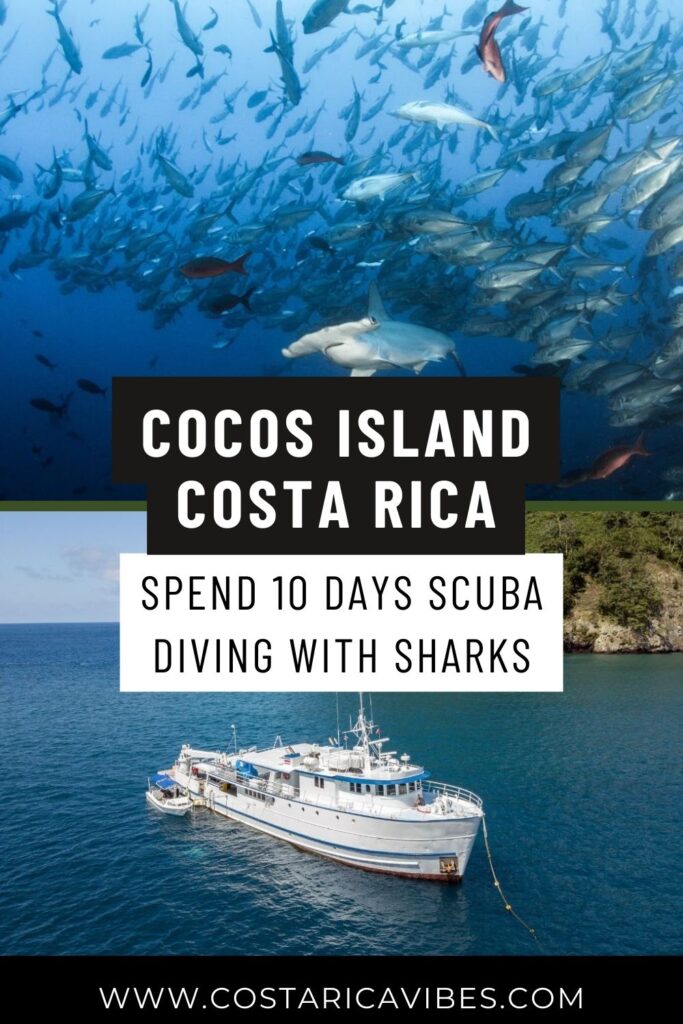
Cocos Island, Costa Rica is a remote island destination on the Pacific Ocean. This is a protected area and part of the Costa Rica national park system. The island is located 300 miles off of mainland Costa Rica and the only way to visit is with a multi-day liveaboard scuba diving tour.
The real draw to this remote destination is the abundance of sharks and other marine life that live in the waters surrounding Cocos Island National Park. If you are passionate in scuba diving, this may be the perfect Costa Rica vacation option for you.
Are you ready to plan your adventure?
Read on for all the details on the best tours, the fascinating history of the island that involves buried treasure, and info about the marine life you might see on your multi-day live-aboard experience.
Month of May Savings!
📞 Purchase an eSIM card for your Costa Rica travels from Airalo 📱
Use code NEWMAY15 at checkout in May to save 15% as a new customer on purchases over $10!
Already a customer? Use the code AIRALOMAY10 for a 10% discount
Just Want to Book Your Trip?
Here are the three best Cocos Island live-aboard tour options
Cocos Island Aggressor
Okeanos Aggressor II
The cocos island diving experience.
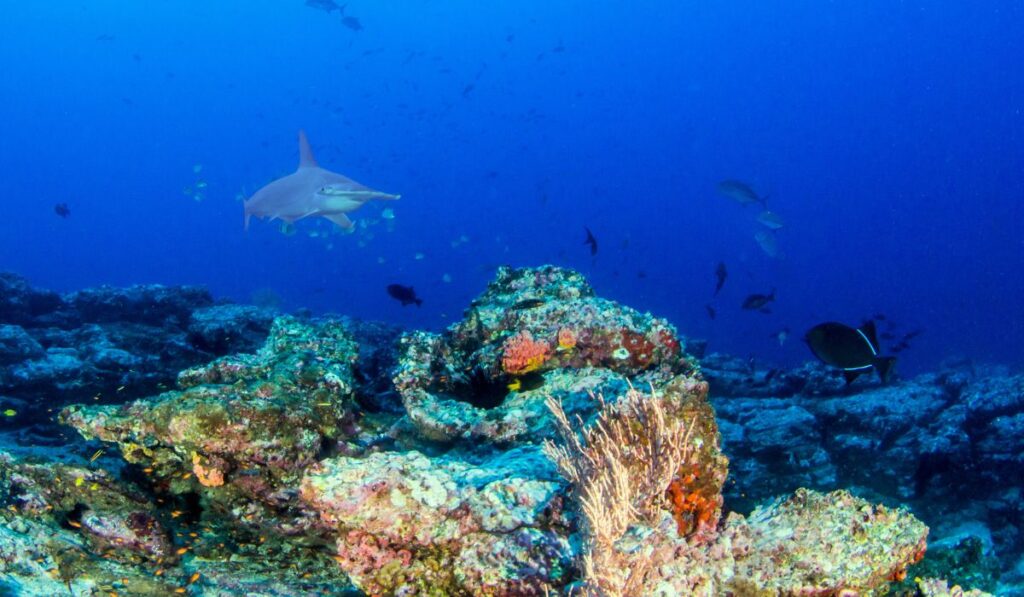
The Cocos Island diving experience starts by boarding a comfortable diving yacht in the city of Puntarenas on the Pacific coast of Costa Rica.
From here, your boat ride out to the island will take approximately 36 hours. It is definitely a very remote location!
You will then spend the next several days visiting diving sites around the island to explore coral reefs and marine life. All meals and sleeping will take place on the comfortable boat.
You will also get the chance to explore Coco’s Island National Park by land as well.
Typically, you will have the chance to dive at 3 different sites per day if you choose.
Marine Life at Cocos Island
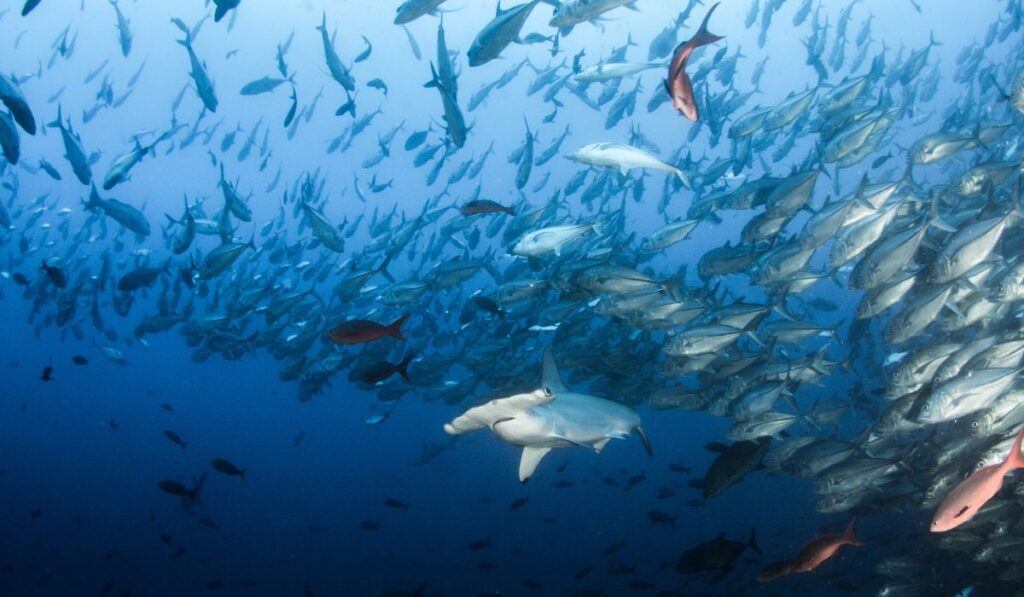
In the waters surrounding Cocos Island, you may see a variety of marine species including:
- Multiple species of sharks including scalloped hammerhead sharks, white tip reef sharks, tiger sharks, whale sharks
- sailfish
- yellowfin tuna
- giant manta rays,
- various species of sea turtles including hawksbill turtles, green turtles, olive ridley turtles
- humpback whales,
- orca whales
- bottlenose dolphins
- Over 300 species of fish
- 30 species of coral
- Over 60 species of crustaceans
- 600 species of mollusks.
🤿 Check Availability and Arrange Your Cocos Island Trip 🦈
Cocos Island Diving Sites
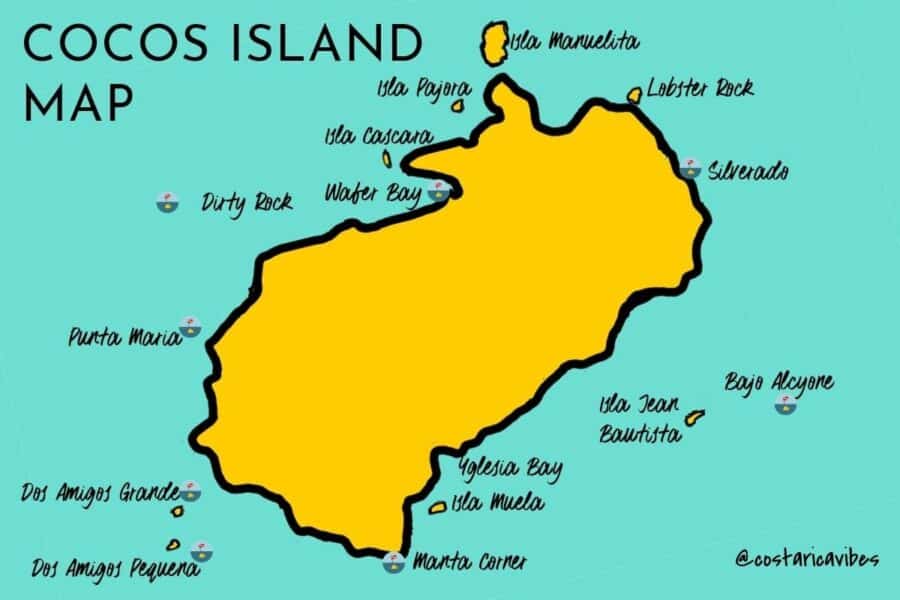
There are several dive sites that you will visit during your trip. Here are the main marine area highlights.
Bajo Alcyone
This is a great spot to see hammerhead sharks.
The seamount top is about an 82ft (25m) descent. From here, you can find a crevice to hang out and watch the hammerheads come into view in swarms. You will likely see hundreds of them. In this area, you might also see silky sharks and whale sharks.
The reef isn’t overly impressive, but there is some sea life with octopi and manta rays.
This is considered the most popular diving spot in the area due to the volume of hammerheads and the large amount of fish that gather here. You may see tuna, blacktip sharks, snapper, bigeye jacks, whale sharks, and more!
The area is made up of volcanic rock outcrops that are divided by a seed channel.
Dos Amigos Grande
Here there is an impressive underwater arch. This can be accessed at 82ft (25meter). Here you can see hammerheads, reef sharks, eagle rays, jacks, snapper, etc.
Occasionally, tiger sharks have also been known to show up in this area.
🤿 Check Availability and Arrange Your Diving Adventure 🦈
Dos Amigos Pequeña
This small island is a nice spot to swim around and see sharks, urchins, snappers, and starfish. This is an area of great visibility.
Manuelita Deep
There are numerous ledges in this area where white tip reef sharks often hang out. Just note that this area can have strong currents.
This is one of the more popular diving sites and is sometimes visited more than once on liveaboards.
Manuelita Garden
Manuelita Garden is a coral garden located atop a submerged mountain. This is one of the only coral reef dives near Cocos Island, and it is beautiful!
Visiting the Island’s Mainland
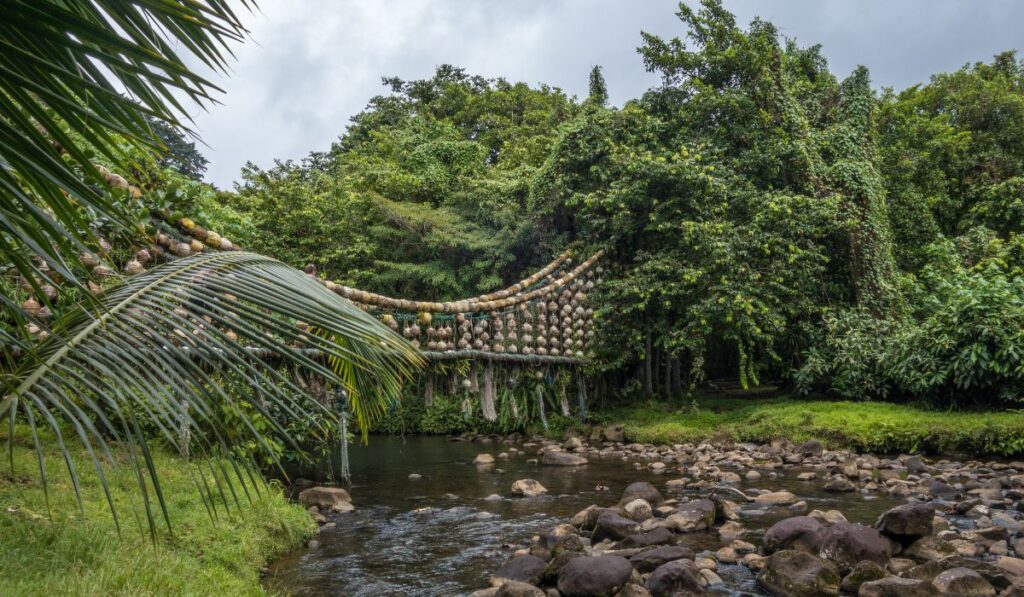
During your several days of diving at the Isla del Coco National Park you will have a few opportunities to walk with a park ranger on the island. There is a waterfall that you could previously walk to, but I read that it is now closed to visitors.
Along the way, you may see wild boars, goats, white-tailed deer, two species of rats, and house cats, over 90 species of birds including red-footed boobies, brown boobies, and Cocos finch and various species of insects.
Keep in mind that the government of Costa Rica has made this island into a national park . The only people who live out here are the national park rangers. The only people allowed to step foot on the land are people visiting on liveaboard diving tours.
History of Cocos Island
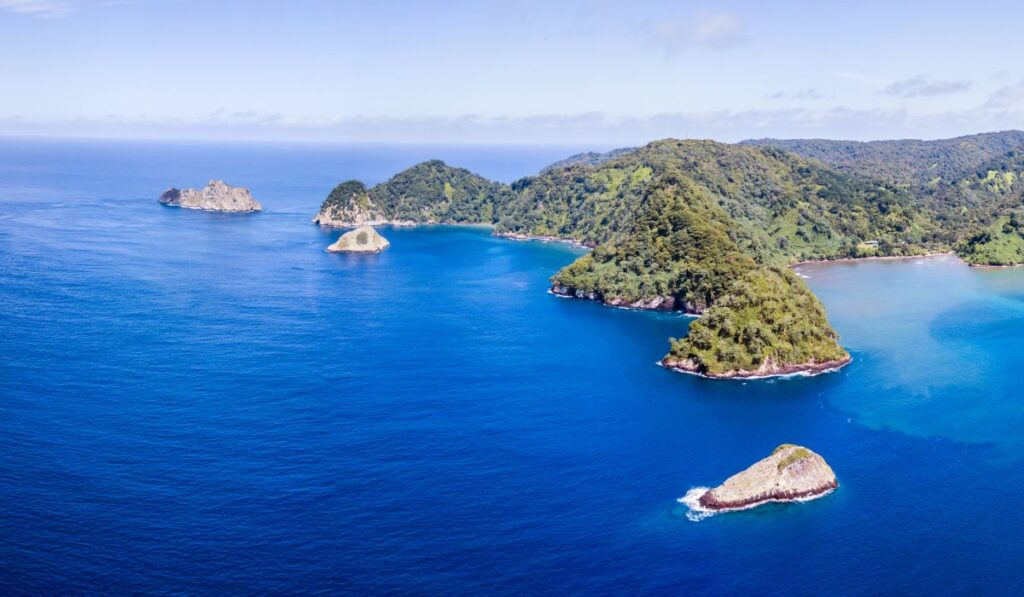
I’ve got to admit, the history of Cocos Island is one of my favorite histories in Costa Rica. It is so fascinating and it involves billions of dollars in buried treasure!
Cocos Island was annexed by Costa Rica in 1832. During this time and until the mid-19th century, whalers regularly stopped at the island.
In October 1863, a few hundred Tongan former slaves were abandoned on the island after it was discovered that they had contracted smallpox. The crew did not want to be affected, so they deserted them.
By the time the Tongans were rescued one month later only 38 people remained. The rest had died from smallpox.
The island was established as a national park in 1978.
In 1997 it became a UNESCO World Heritage Site.
In 2002 that classification was expanded to include over 700 miles of ocean surrounding the island.
And, in 2022 the president of Ecuador announced the expansion of the Galápagos Marine Reserve by 50%. This addition added 23,000 sq miles of protected sea and land to the northeast of the islands.
This means, the protected oceanic area around Cocos Island now connects all the way down to the Galapagos Islands.
Buried Treasure
The island is sometimes referred to as Treasure Island, and for good reason!
There are multiple claims of buried treasure on the island, but none has actually been discovered (that we know of).
The first claim came from a woman, Mary Welch in 1818. She stated that 350 tons of gold (worth $16 billion today) was buried on the island by a British pirate named Bennett Graham. She claimed that she had been a member of the pirate crew and knew that this cache had been stolen from a Spanish galleon and buried there.
Welch was sentenced to an Australian penal colony for her crimes. However, when she was released she returned to Cocos Island with a map which she claimed showed the location of the treasure.
Unfortunately, the landmarks were unrecognizable and she never found the treasure.
A Portuguese pirate, Benito Bonito also supposedly buried treasure on the island around the same time as Bennet Graham, but no concrete evidence has been found.
The most well-known legend of Cocos’ treasure comes from what is referred to as the Treasure of Lima. The Spaniards controlling Lima, Peru in 1820 supposedly entrusted a British trader, Captain William Thompson, with the city’s treasures while Lima was being invaded by the Argentinian army.
Thompson and his crew allegedly took off with the treasure and sailed to Cocos Island where they allegedly buried the loot. Not long after, they were stopped by a Spanish warship that killed the entire crew except for Thompson and his first mate.
They promised to show the Spanish crew the location of the buried treasure on the island in exchange for their lives, but both Thompson and his first mate ran off into the thick jungle as soon as they landed onshore.
The treasure was never found.
In 1897, a small colony was formed here under the rule of a German adventurer. This colony was short-lived, but while here the adventurer spent a great deal of time searching for the supposed buried treasures. He found a few gold coins., but nothing else
Since then, there have been over 300 hundred expeditions to find the buried treasures that the island may possess, but none have been successful so far.
And, because the Costa Rican government decided to make the island a protected area that is not open to the public it is not a heavily traversed piece of land except for by the park rangers.
Best Time of Year to Visit
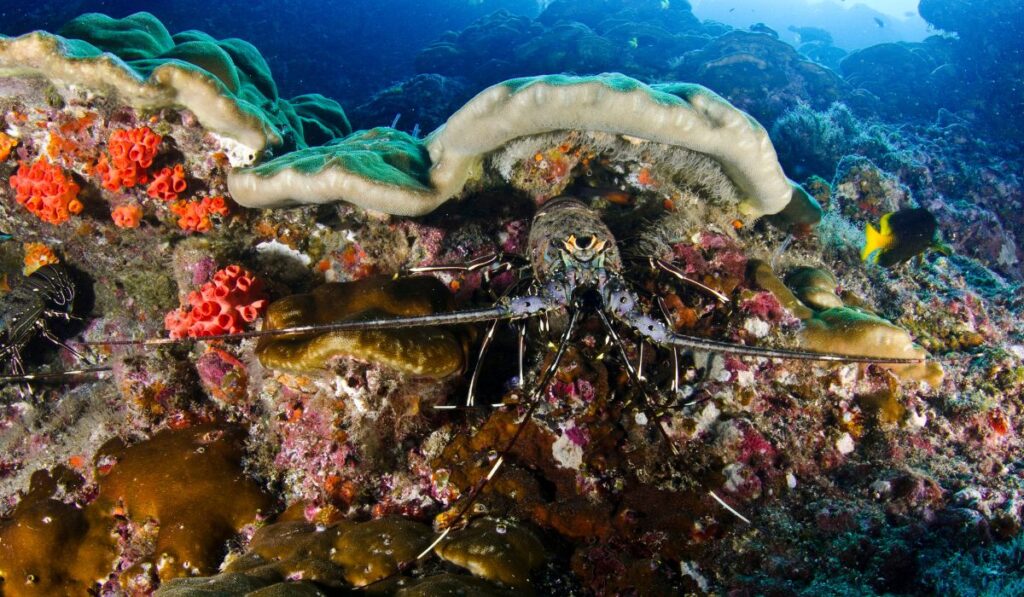
The dry season (mid-December until end of April) is the best time to visit for good weather and clear visibility. There will be almost no rain during this time of year.
This is the best time to visit if you have a tendency to get seasick because the waters will be much calmer.
The rainy season (May until mid-December) means almost daily rain storms usually in the afternoon. During this time of year, the water may be much rougher. However, this is the best time to see hammerhead sharks and manta rays.
If possible, we suggest visiting in mid-July . Usually, Costa Rica experiences a mini summer during this time of year and the rain stops for about two weeks. This also happens to be when hammerhead sharks are about at their peak.
Diving Conditions
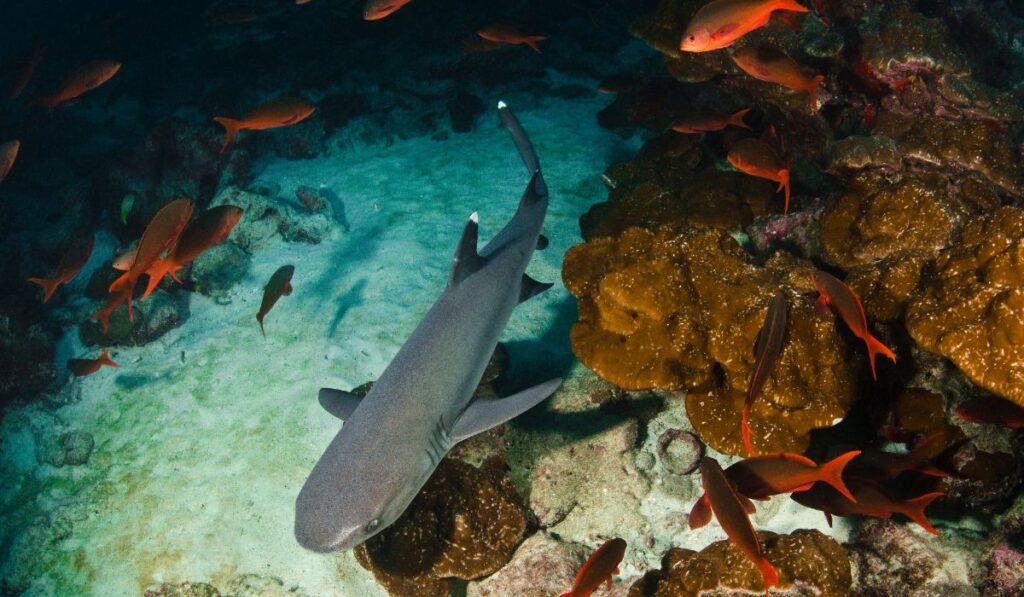
Most of the diving sites are open water. Keep in mind that many of the diving sites are located on submerged mountains and can have strong currents depending on the time of year.
The water temperature is usually between 75 and 85 degrees Fahrenheit.
🤿 Arrange Your Cocos Island Diving Adventure 🦈
The visibility is generally between 30 and 100 feet. Most dives are between 30 – 131 feet (10 – 40m).
For this reason, Nitrox diving is recommended.
What to Pack for the Liveaboard Experience
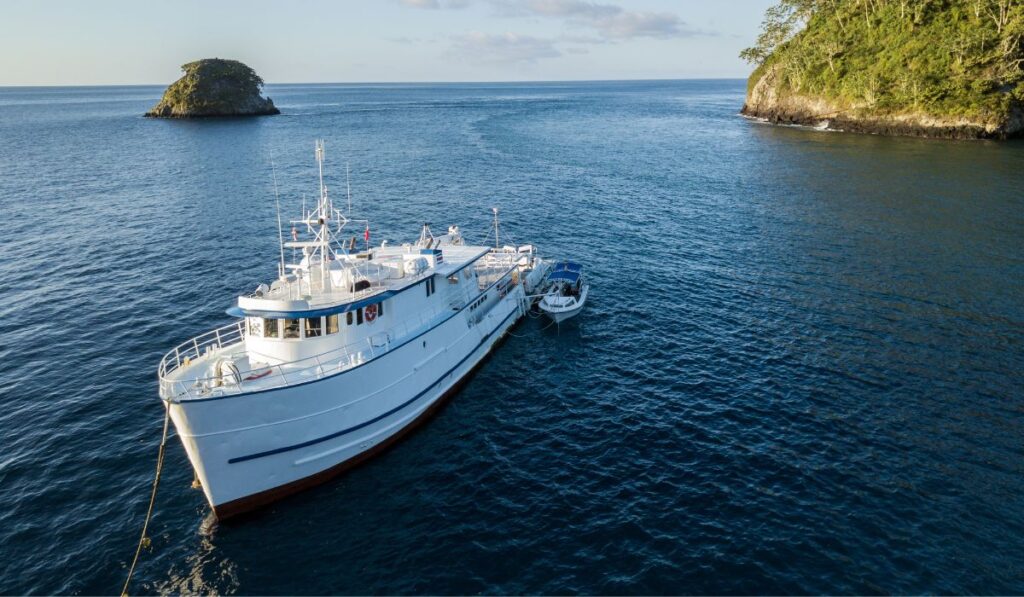
It is recommended that scuba divers bring:
- Reef-safe sunblock
- Comfortable clothes for while on the boat
- Dive computer
- snorkel gear
- wetsuit (between 3 and 5mm)
- dive gloves
- depth gauge
Tanks, weights, and weight belts will be provided on the boat.
We suggest that you put all of your gear in luggage designed for diving gear . This will help keep everything secure and well packaged.
If needed, it is always possible to rent all equipment on the boat for the extent of your diving adventure. This will save you from the hassle of lugging everything with you.
Also, laundry service is available on most boats.
PADI Requirements
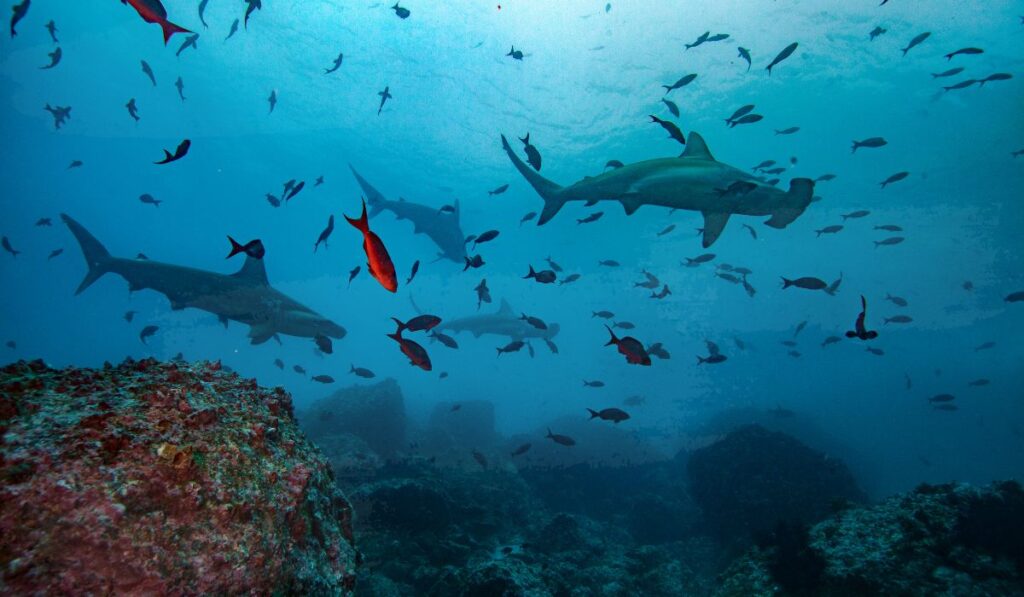
We recommend this trip to more experienced divers. It is a full immersion into diving and if it is not something you are super passionate about, it may be a bit much for you.
However, for most tours, the only requirement is that you have your PADI open water certification.
There is no requirement for the number of dives completed, but 50 hours of completed dive time is highly suggested.
Most tours will offer the Enriched Air Nitrox course for an extra fee.
Safety Notice
All tours and dives are led by certified guides with extensive training. That being said, occasionally things happen.
I say that because a woman from New York was killed here in 2017 during an unprovoked tiger shark attack.
Her diving instructor was also bit in the leg but survived the attack.
Tiger sharks in the area are a relatively new thing and are very rare.
Cocos Tour Options
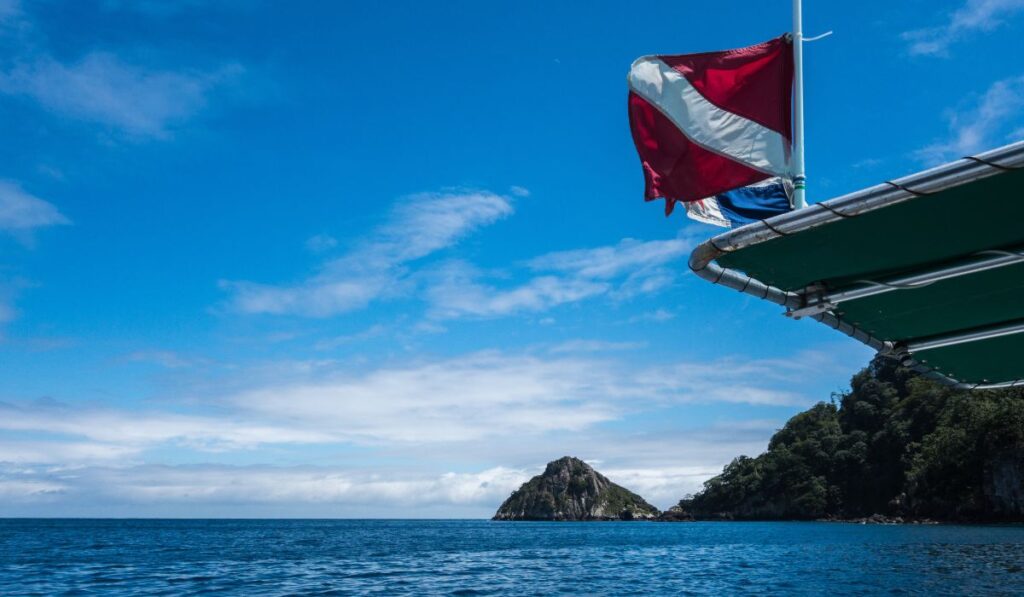
In order to visit Cocos Island it is necessary to take a multi-day liveaboard-style boat trip. This is due to the fact that it is located over 300 nautical miles off of Costa Rica’s coast and the fact that nobody besides park rangers are allowed on the actual island (they are trying to keep all the buried treasure for themselves 😉 ).
The boat trip out to Cocos Island from the Puntarenas port takes between 36 to 48 hours.
All liveaboard boats will anchor it the bay off of the island at night. Staying on the island is not permitted.
There are multiple tour options. Here are the best options.
MV Sea Hunter
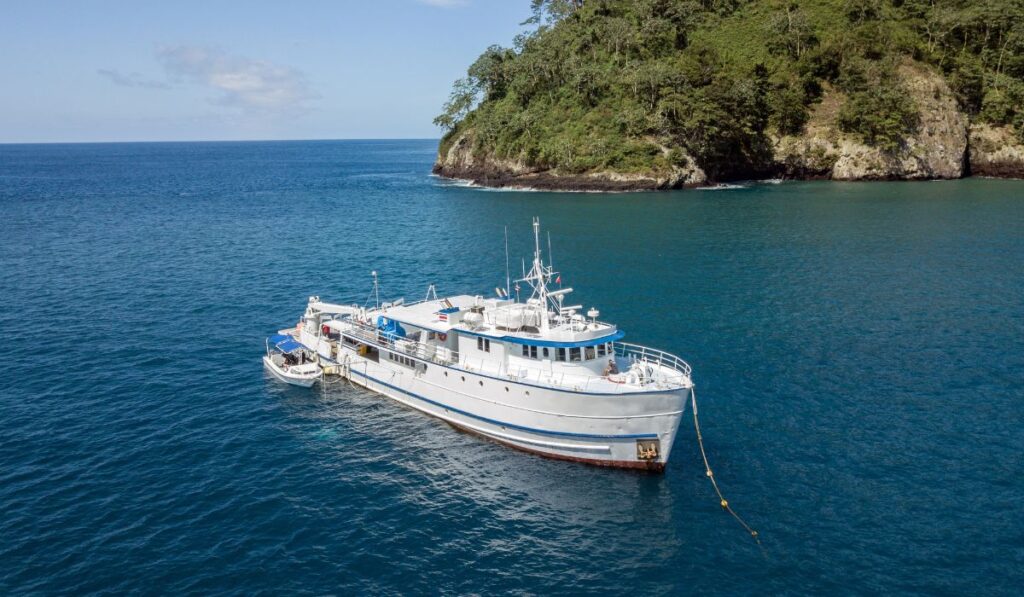
⭐️ RATING: 9.3 on LiveAboard | ⏳ TOUR LENGTH: 10 to 11 days | ✅ Book it!
This boat has 10 cabins which accommodates 20 guests in twin and double bed air-conditioned suites. All rooms have en-suite bathrooms. The boat has an air-conditioned restaurant, sundeck, entertainment lounge, and a study with books.
Tour Length
Tours vary between 10 and 11 nights
Tour Schedule
Plan your flight to fly in and out of the San Jose International Airport . You will need to organize your own transportation from the airport to your hotel in San José for the first night.
The next morning, the boat’s crew arranges to pick up only from these 4 hotels: Grano de Oro , Park Inn, Hampton Inn , and Costa Rica Marriott , so you will need to book your stay at one of those places.
A sample itinerary based on the length of your trip is as follows….
Day 1: Meet in front of the host hotel in San Jose. A transfer service to Puntarenas will be provided. Along the way, you will stop for a snack and lunch. You will then board the boat and depart for Cocos Island.
Day 2: It will take approximately 36 hours to arrive at Cocos Island.
Day 2-9: These days will consist of eating, sleeping, and diving around the multiple island diving sites. Meals will be provided throughout the day. Most days consist of three dives, but three times during the trip there will be an option for a night dive as well.
Day 9-10: Travel back to Puntarenas.
Day 11: Check out of the boat at 8am. A transfer bus will take you back to San Jose Airport or host hotels.
In addition to the liveaboard rate you will also need to pay
- National Park Fee – USD 553 (to be paid in advance)
- Fuel surcharge – USD 200 per person (to be paid onboard)
🤿 Check Availabilit y for MV Sea Hunter 🦈
Okeanos Aggressor
⭐️ RATING: 8.4/10 on LiveAboard | ⏳ TOUR LENGTH: 10 nights | ✅ Book it!
This is a brand-new yacht that was built in 2022. It is a beautiful mix of luxury and practicality.
- 10 nights accommodation
- 7 days of diving (3-4 dives per day)
- Snacks, soft drinks, water, tea, coffee, local beer and wine
- 12l tanks and weights
- Scheduled group transfer from San Jose to yacht terminal
- Free short-term DAN diving insurance (upon request)
This yacht accommodates 22 guests in 5 deluxe staterooms and 4 master staterooms.
Each room has an individually controlled AC, TV and media player, bathroom, and ample storage space. All meals are served in the dining room.
The food consists of freshly prepared local cuisine, American, and BBQ. There is a large salon with entertainment options as well as a sun deck with lounge chairs, a hot tub and a shaded cocktail deck. All food and drinks are included in the price.
11 days/ 10 nights
Plan your flight to fly in and out of the San Jose International Airport .
The organizers of this trip would like you to spend your first and last night at the Park Inn in San Jose if possible. This makes it easy for them to pick you up in the morning.
You can book your stay at the Park Inn here
You will need to arrange your own transportation from the airport to Park Inn. We suggest just getting a registered taxi from the airport.
Day 1: Meet in front of Park Inn. A transfer service to Puntarenas will be provided. This drive takes about 1.5 hours. You will then board the Aggressor and depart for Cocos Island.
Day 2-3: Arrive to Cocos Island and begin diving.
Day 4-8: These days will consist of eating, sleeping, and diving around the multiple island diving sites as well as visits to the island for nature exploration.
Day 11: Check out of the boat at 7 am. A transfer bus will take you back to San Jose Airport or Park Inn hotel.
On top of the diving tour price, you will need to pay for any gear that you need to rent, Cocos Island Park Fee to be paid on board (USD 490 per person + 13% VAT), Cocos Island Emergency Evacuation Plan – USD 30 per person (to be paid on board).
Also, flights, hotel on the first and last night, Nitrox, and crew gratuities are not included.
🤿 Check Availabilit y for Cocos Island Aggressor 🦈
⭐️ RATING: 8.6/10 on LiveAboard | ⏳ TOUR LENGTH: 10 nights | ✅ Book it!
This yacht accommodates 22 guests in 11 cabins. All meals are served in the dining room and consist of freshly prepared American style cuisine.
There is a large salon with entertainment options as well as a sun deck with lounge chairs and a bar and grill. All food and drinks are included in the price.
The organizers of this trip would like you to spend your first and last night at the Park Inn.
You will need to arrange transportation from the airport to Park Inn. We suggest just getting a registered taxi from the airport.
Day 1: Meet in front of the host hotel. A transfer service to Puntarenas will be provided. This drive takes about 1.5 hours. You will then board the Okeanos Aggressor ii and depart for Cocos Island.
Day 4-8: These days will consist of eating, sleeping, and diving around the multiple island diving sites..
Day 11: Check out of the boat at 7 am. A transfer bus will take you back to San Jose Airport or host hotels.
🤿 Check Availabilit y for Okeanos Aggressor ii 🦈
Things You Should Know Before Booking
Here are all of our helpful travel tips that your should know before booking your liveaboard adventure to Cocos Island.
There are Multiple Places Called Cocos Island
Don’t get confused when booking your trip. There is also a series of islands in the Indian Ocean called Cocos Islands.
These islands are part of Australia and are sometimes also referred to as “Cocos (Keeling) Islands” or Cocos Islands Malay.
Don’t Forget Travel Insurance
Make sure to purchase a travel insurance plan which will cover you for accidents related to diving.
Conservation Efforts
Conservation of this area is very important. Please be careful not to destroy or take any part of the natural habitat. Leave to trace of your visit except your amazing memories.
Conclusion: Scuba Diving Cocos Island
In conclusion, Cicos Island is a beautiful place with a diverse marine ecosystem. A scuba diving adventure here is bound to be an extremely memorable experience.
So, what do you think? Is a diving trip to Cocos Island in your future? If you have any questions, feel free to comment below. We are always happy to help you out!
You Might Also Like:
The 10 Best Spots for Snorkeling in Costa Rica
Fishing in costa rica: charters, shore fishing, and more, 60 things to do in costa rica – for all budgets and interests, costa rica catamaran tours: how to arrange a trip, costa rica excursions – plan day tours.
Costa Rica Travel Details : What You Need to Know
🚗 Should I rent a car in Costa Rica?
Having a rental car will give you the most flexibility when traveling in Costa Rica. This will also allow you to take fun day trips on your own.
- Save 10% Plus Other Perks with Our Adobe Rental Car Discount
- You might also consider; shared shuttle services or private transfer services
🏄🏽 How can I book things to do?
We find that Viator tends to have the most comprehensive selection of activities with secure booking and good cancellation policies.
🍍 I’m overwhelmed with planning. Can you help?
Of course! I suggest joining our Facebook group for specific questions and head to our Start Here Page to get started planning.
✈️ What is the best way to book a flight?
Usually, we have the best luck finding great prices with Skyscanner . Check for flights to both San Jose Airport (SJO) and Liberia Airport (LIR).
🛏️ What is the best way to book my Costa Rica hotels?
We highly suggest Booking.com for hotel bookings and typically use VRBO for Costa Rica vacation rentals.
🗣️ What is the main language in Costa Rica?
The main language in Costa Rica is Spanish. Most people working in tourism speak at least some English.
💰 What is the currency in Costa Rica?
The currency used in Costa Rica is the Costa Rican colón (CRC). However, the US dollar is widely accepted in most tourist areas
📞 What is the best way to stay connected?
An eSIM from Airalo is the easiest way to get 4G data while traveling in Costa Rica.
🌴 Is Costa Rica safe?
Generally, Costa Rica is considered safe for tourists. However, like any travel destination, it’s best to use caution and be aware of your surroundings.
🛂 Do you need a passport to go to Costa Rica?
Yes, Costa Rica is its own country. You will need a passport to visit.

Hi! We’re Thomas (the German) and Sarah (the US-er)
We met in Virginia, moved to Germany, and since 2016 we have lived in sunny Costa Rica. It was a spontaneous decision to move here, but it was the best decision! Now we spend our days roaming the country to bring you the very best in Costa Rica travel here on Costa Rica Vibes. Sarah is the writer. Thomas is the one keeping it all together. Want the whole crazy story?

Sarah McArthur
Sarah McArthur is the co-founder and main writer of Costa Rica Vibes. She is originally from the United States but has lived in sunny San Jose, Costa Rica since 2016. She has traveled all over the country and now considers herself a self-proclaimed Costa Rica travel expert. Want the whole crazy story?
Leave a Reply Cancel reply
Your email address will not be published. Required fields are marked *
Search in Site
Geography · Islands
Cocos Island
April 21, 2014 by Sam

A rough and extremely gorgeous island, this World Heritage Site and Marine Park is the cherry on top of Costa Rica’s national park system. The island was created during a volcanic turmoil approximately two-and-a-half million years ago and is primarily created out of basaltic rock, labacorite and andecite lava flows. Its landmass is peppered by four mountain peaks, the highest of which is about 2,080 feet. The island has a couple of large bays with safe anchorages and sandy beaches. Chatham is nestled on the northeast side and Wafer Bay is on the northwest.
Cocos Island is an island approx 600 off the nearest Costa Rican coast of volcanic origin. Its nutrient rich deep water is what attracts the large schools of pelagic life, namely the regularly seen schools of Hammerhead Sharks (at the world’s largest cleaning station) that make the region a top class diving destination.
The island is the only point above the sea in Cocos Ridge, a line of sunken volcanoes that run from Costa Rica to the north of Galapagos Islands. The island is of volcanic origin and its rich soil supports a tropical lowland ecosystem along with a cloud forest.
Cocos Island National Park includes the entire Isla del Coco and the marine ecosystems up to a distance of about 20 kilometers around the island. It the only island in the tropical Eastern Pacific with a tropical rainforest setting. Its location and varied eco marine system make it one of the most biologically intriguing corridors on the planet. The adjoining marine national park has is celebrated among divers for the large range of big pelagic species such as sharks, rays, tuna and dolphins.

The island has a primarily tropical climate with high humidity and rainfall fluctuates with sunshine throughout the year. Even so there are two seasons, the dry season runs from December to May and is when the sea is calm and the visibility at its optimum. June to November (rainy season) which has more rain, rough seas and less visibility is actually the best time of the season to go diving. The nutrient generous swells attract incredibly large schools of hammerheads, sharks and large rays.
The highlight of a Cocos island trip is the unbelievable experience of witnessing scores of hammerhead sharks brush past you and you meander through its clear waters. Bajo Alcyone is one of the beat sites for an up, close and personal encounter with hammerheads coming in their hundreds to the cleaning stations nestled here. The most strategic way to get close and capture images is to find a rock to lie still and patiently hand around behind it. They are easily scared so the lesser the movement, the better are the chances of them approaching. It’s not just hammerheads that come here to be cleared. Divers experience a variety of sharks such as white tip reef sharks, silky sharks, Galapagos sharks and occasionally a spectacular whale shark or the ever popular in the waters- manta ray .
The secluded location of the Island means that it can only be accessed by diving live aboard trips, which departs from Puntarenas . The travel usually depends upon the climate conditions and winds but usually takes about one and half day of cruise time. The high travel time, challenging dive conditions combined with the fact that the trips are highly focused means that they are not appropriate for beginner divers or non divers.
Since Cocos Island is a liveboard destination, all island tourist and leisure activities are centered on the reefs and the vessel. By seeking prior permission, tourists are permitted to visit the island but are not allowed to take back flora or fauna. Visits are facilitated by the Park Rangers.
Though the range of terrestrial fauna is rather low, they are present here in considerable numbers. The island hosts about 90 bird species including the three endemics like the Island cuckoo, the Island flycatcher and the Island finch. There are other aerials like the Red-footed booby and brown bobby along with the great frigate bird, the white tern, and the common noddy create breeding colonies on the encircling small islands and rocks. A couple of endemic reptiles have also been identified such as the anolis lizard and gecko. Some of the terrestrial mammal s here introduced by man include pigs, goats and cats.
Cocos Island is known as rich, natural resource, but it was considered a rich source for erstwhile pirate treasures. Cocos Island was a significant base for sailors, explorers, pirates and adventurists since the early 1500’s, and notorious pirate kings like William Davis (1684) and Benito Bonito (1819) are believed to have stashed their treasure here.
The Costa Rican administration acquired the Cocos Island in 1869. During the period of 1872 and 1874, the Costa Rican government ran a prison for the most hardened criminals on this cast away island. It also carried out its own treasure unearthing expedition, but it yielded no efforts. In 1898, naturalists Anastasio Alfaro and Henri Pittier visited the island and proposed to turn into a national park. In 1978, Cocos Island was included in the part of the nation’s heritage and a significant hub of natural resources.
Owing to the breathtaking marine life in Cocos Island, it has been named one of the top 10 scuba diving spots in the world by PADI (Professional Association of Diving Instructors) and on the diving list of most divers. For many, the primary attractions here are the range of pelagic species, which are present in large numbers here. The largest schools of hammerhead sharks in the world are consistently reported there. Up close and personal sightings of scores of these creatures and other large animals can be seen in every dive. Tinier and more vibrant marine species can also be abundantly encountered in one of the most widespread and generous reefs of the south eastern Pacific.
More Information
http://www.visitcocosisland.com/ – Isla de Coco of Costa Rica, information about travel, tours, and of course scuba diving. http://www.costarica-scuba.com/about-cocos-island/ http://en.wikipedia.org/wiki/Cocos_Island http://www.tripadvisor.in/Attraction_Review-g291982-d633584-Reviews-Cocos_Island-Costa_Rica.html
Share this:
Comments are closed.
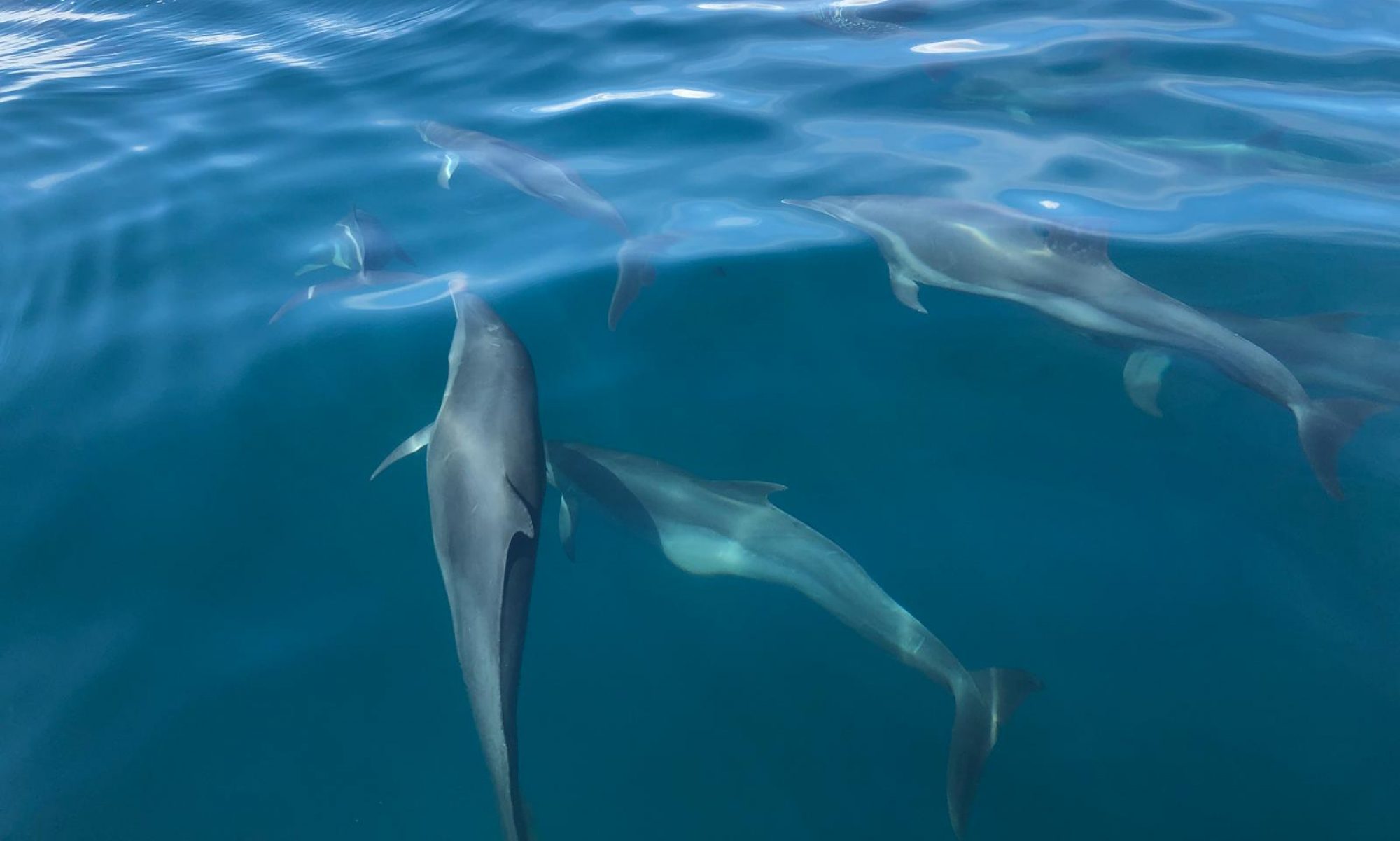
Responsible Whale & Dolphin Tours
The Eco Experience of a Lifetime in Costa Rica
Cocos Island
Cocos Island is hands down the best diving in Costa Rica, and one of the best locations in the world. For diving fanatics, there is no comparing Coco Island to anything else. It is one of the largest uninhabited islands in the world, but its waters are teeming with wildlife. Huge schools of hammerhead sharks and white-tipped reef sharks, whales, manta rays, dolphins and fish species too many to list, put Coco Island as a top ranked diving location in the world. Seven to ten day chartered boat tours are available.
Contact us to learn more about multi-day diving trips.
- Country Overview
- Press Releases
- Museums / Art Galleries
- Calendar of Events
- Distances and driving time
- FAQ / Entry Requirements
- National Parks and Reserves
- Responsible Travel
- Security Tips For Tourists
- Weather Forecast
- Related Sites
- Canopy - Zip Lines
- Combination tours
- Cultural / Museums
- Diving - Snorkeling
- Golf Courses
- Horseback Riding
- Special Packages
- Sport-Fishing
- Arenal / North Zone
- Caribbean / Limon
- Central Valley / San Jose
- Corcovado / Osa / South Pacific
- Guanacaste / North Pacific
- Jaco / Mid Pacific
- Quepos and Manuel Antonio
- Talamanca Highlands
- All Inclusive
- Bed & Breakfast
- HOTELS BY REGION
- Airlines / Local Flights
- Rental Cars
Probably offers the single finest big animal diving experience in the world. COCOS ISLAND (TREASURE ISLAND) is an ocean oasis lying isolated 320 miles southwest of continental Costa Rica, where it concentrates the marine life from many hundreds of miles around. For centuries the hideout of pirates and adventurers, Cocos is recognized today as one the world's largest uninhabited island and, to many, the most beautiful as well as one of the last truly wild places in nature. It has been granted World Heritage status because of the quantity of marine life to be found in its vicinity. According to the February 1996 issue of Scuba Diving Magazine, Isla Del Coco is second in the Americas for the amount of larger animal species inhabiting its waters.
The waters around the island offer the excitement of diving with schools of Hammerhead Sharks, giant Manta rays, giant Moray eels, bottle nose dolphins, and the occasional whale shark! Additionally, you will see Moorish Idols, large schools of jack and tuna, Creole fish, lobsters, octopus and other various reef life. Silky sharks, silver tips, sailfish, marlin, and green turtles are also abundant in the area. The key word to describe Coco is ACTION!
The best time to dive Cocos Island is the May to December rainy season when you'll find the roughest sea conditions, strongest currents, lowest visibility and have the best chance to see the biggest animals. June, July and August are historically the best months for hammerhead sightings, while March and April are the worst.
The "OKEANOS AGGRESSOR" is a spacious, 110' yacht, built and powered for comfort, safety and stability, that accommodates 21 divers and offers the amenities of luxurious staterooms with air conditioned, hairdryers and fitted with private toilets, hot freshwater showers and sink; breakfast (cooked to order), buffet lunch and an elegant chef prepared meal at dinner with tableside service are served in addition to fresh mid morning and mid afternoon snacks. Beverages (alcoholic and non alcoholic) are complimentary while onboard. A large dining room and salon, personal dive gear lockers, ample camera set-up and work tables, a ship's mini-boutique and restaurant. COCOS ISLAND DIVE SITES MANUELITA ISLAND Depth: 45 to 150 feet Skill Level: Advanced This islet off Cocos's northeast corner features a sheer wall and deep boulders on the west side and shallow orange plate corals on the east. Lazy white-tip sharks and marbled rays are stacked atop each other on the rocks. Hammerheads venture in close for barberfish cleanings. Locate the schools of creoles - they migrate toward big-animal action - settle into the rocks, and don't move.
DIRTY ROCK Depth: 65 to 150 feet Skill Level: Advanced Like diving the Grand Canyon. Half a mile off Cocos's northwest corner, this site has monstrous boulders sloping down the south side and a 100-yard-wide channel separating the main rock from a collection of pinnacles. Eagle rays soar between gaps, gorges and valleys formed by boulders, while hawksbill turtles and octopuses bop around the rocks. Look for whale sharks and mantas cruising the channel. SHARK FIN ROCK Depth: Surface to 200 feet Skill Level: Advanced A mile southwest of Punta Turrialba. This is a mammoth underwater rock with boulders hugging the southwest side and a wall on the northwest. A tornado of bigeye jacks sweeps around this site, while solitary tuna and pairs of wahoo hunt. Watch for mobila and Pacific manta rays during your safety stop. PAJARA Depth: 65 to 100 feet Skill Level: Advanced Islet at the mouth of Weston Bay. Someone emptied a cupboard of plate corals down the south slope of this site. There's an 85-foot wall on the north side. Look for orange, muppet-like frog fish on the wall at 55 feet and morays in the coral. Green and hawksbill turtles rotate around a pinnacle to the west. BIG DOS AMIGOS Depth: 65 to 120 feet Skill Level: Advanced A half-mile off Punta Rodriguez, this islet features a 45-foot-high arch and a 60-foot pinnacle off the southeast side. Rainbow runners, yellowtail snappers and bigeye jacks stream through the arch. Cracks are packed with lobster. Hundreds of hammerheads swim between the islet and the pinnacle.
- Accomodation aboard the vessel
- Diving, 4 dives per day
- Guided dives, at least one divemaster per group.
- Compressed air tanks, weights and weight belts
- Hotel transfers on day of charter
- All meals and snacks and non alcoholic beverages
- Local beer and wine
Charter DO NOT include:
- Equipment rental
- Nitrox fills
- Specialty courses or certifications
- Hotel stays
- Crew gratuity
- Park fees or government taxes
Park Fees: A $35 per day (CASH ONLY, no traveller checks) charge per person will be collected during your charter.
Fuel surcharge: $100.00 per person.
* All prices are per person and quoted in USD. Rates, taxes and fees are subject to change without notice.
Guests must arrive in San Jose, Costa Rica one day prior to the vessel's departure to meet the transfer schedule to Puntarenas from San Jose. Your travel arrangements must include a one night stay-over, prior to the vessel departure, in San Jose.
Nitrox Certification Course : $250 Due to the dephts we dive on the island, Nitrox is a highly recommended course to take, the cost of the filling tanks if you do the course in Okeanos is $90
If you are already Nitrox certified, don't forget to bring your licence.
Filling of tanks up to 36% oxygen, $150 per charter.
Advanced Open Water Diver: $280 Specialities to choose from: Videography, Deep Diving, Boat Diving, Naturalist, Night diving..etc..
U/W FOTOGRAPHER OR VIDEOGRAPHER : $180 Introduction course to basic photography or videography. You will learn about different
Lenses, filters, cameras, housings and different techniques.
DIVE EQUIPMENT RENTAL:
- Bc/Reg $170 combo per charter
- Diving computer $125 per charter
- Night light $8
DVD OF THE WEEK: $80.00
Hosted by Rainforest Group

What to do in Cocos Island
The Professional Association of Diving Instructors (PADI) named Cocos Island one of world’s ten best dive destinations. The rich coral reef and volcanic caves support more than 300 species of fish, including giant manta rays, sailfish, and whale sharks.

What is the Weather Like?
Cocos Island features an equatorial climate, hot and humid year-round. The (relatively) dry season extends from January to April and the wet season from June to December. However, torrential rain can be expected year-round.
The rains occur mainly in the form of downpours and thunderstorms in the afternoon. Precipitation exceeds 195 inches per year. The temperatures are high and stable throughout the year, with highs in the 80s and lows in the mid-70s. However, the heat is tempered by sea breezes.
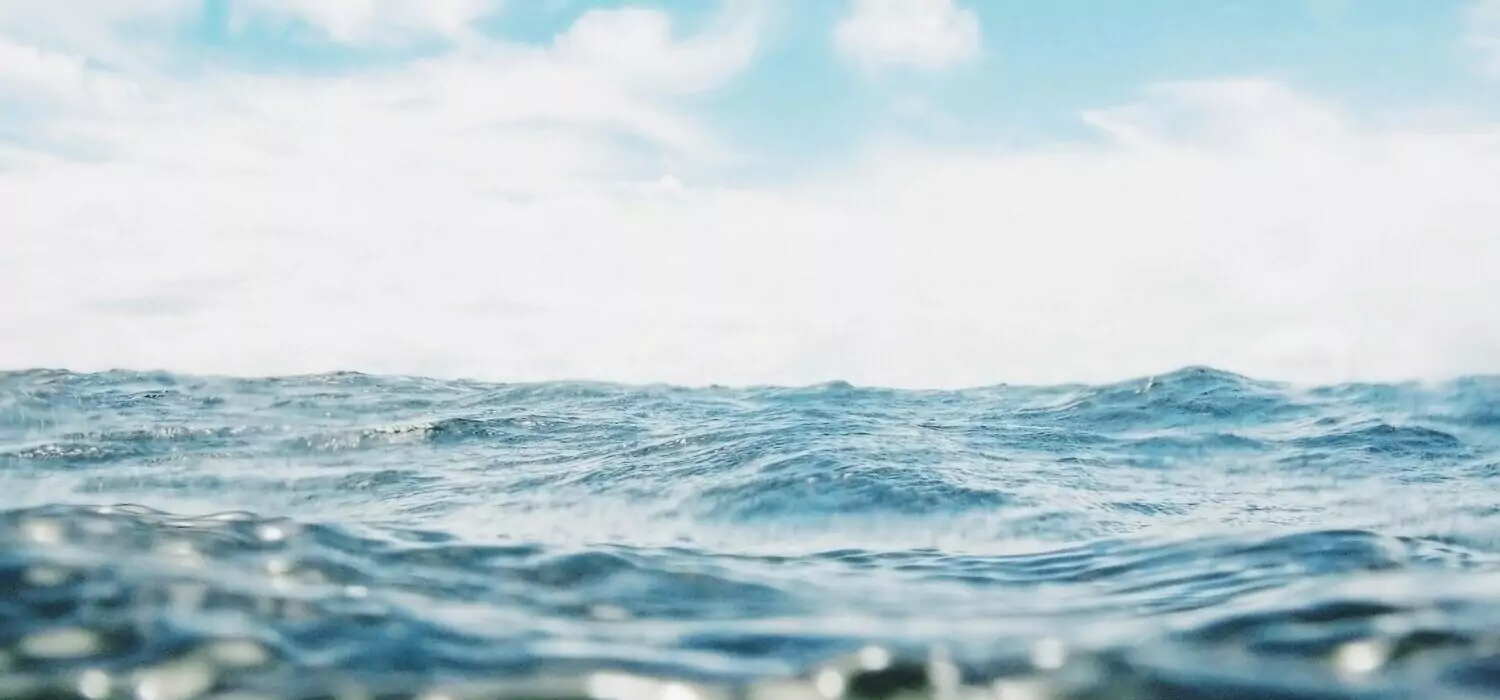
Getting There
The only way to reach Cocos is by sea. Most dive boats begin the 35-hour voyage from Puntarenas , staying at sea for ten to twelve days. Because the surrounding marine environment is so fragile, access to the island is strictly limited; fewer than 1500 people are permitted to visit each year.
Start your journey today
LANDED delivers the finest in custom, private travel to Central America, South America, and Antarctica. These regions are our passion; we know them first-hand and by heart. Speak with one of our travel designers and let us create a tailored itinerary for you in Cocos Island.
How to combine Cocos Island
Have some extra time? Here are some options for you to combine with
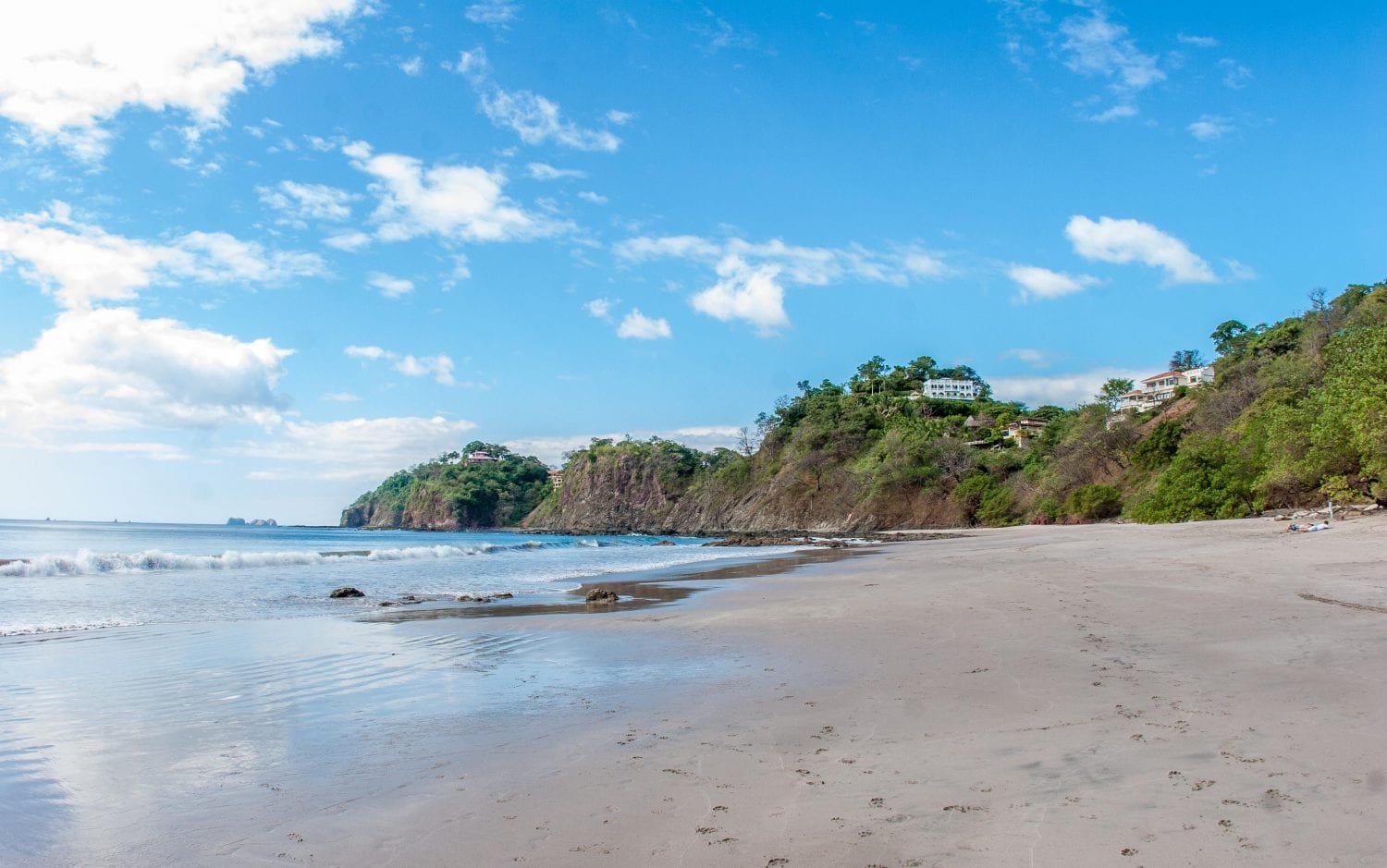
Central Nicoya
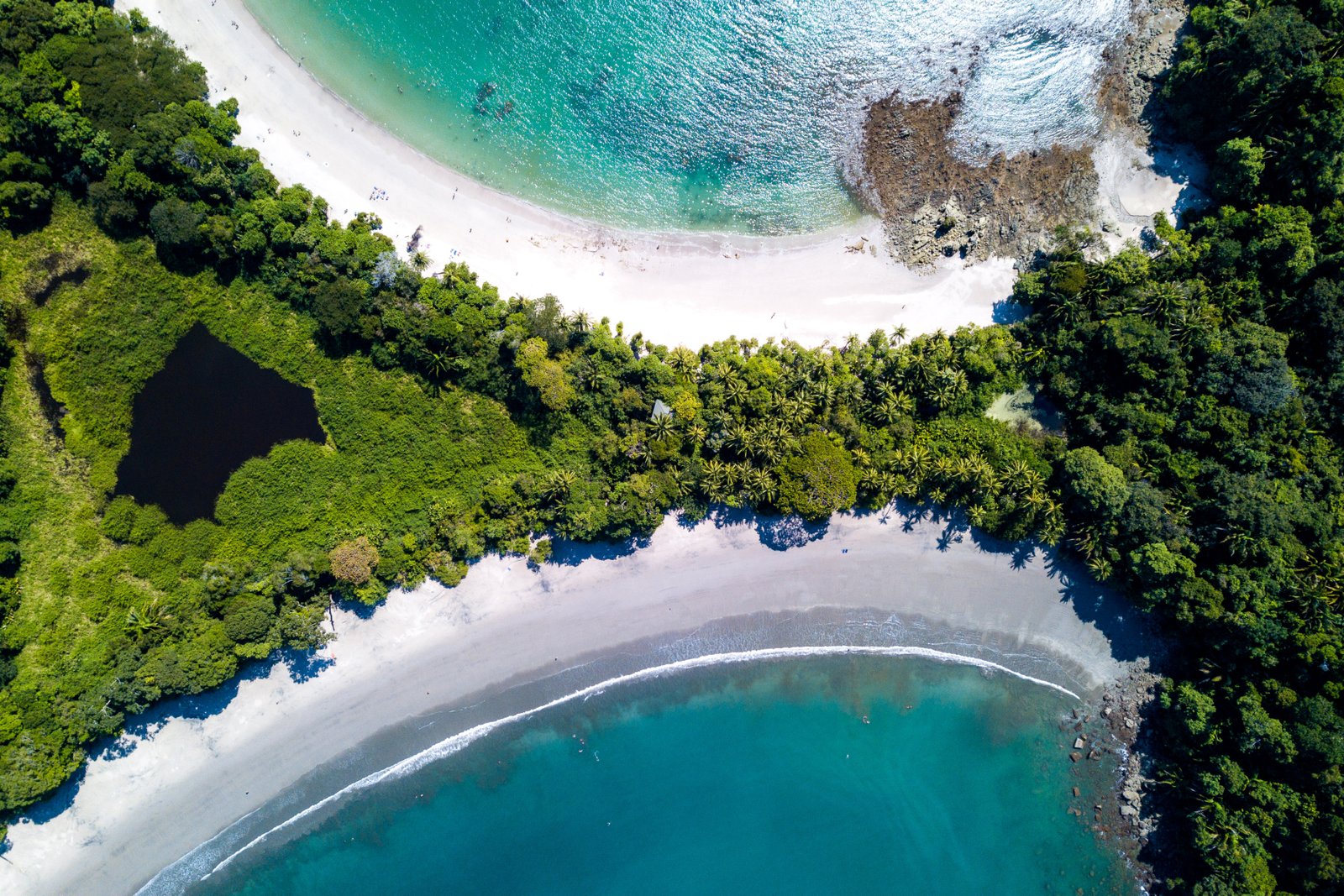
Manuel Antonio
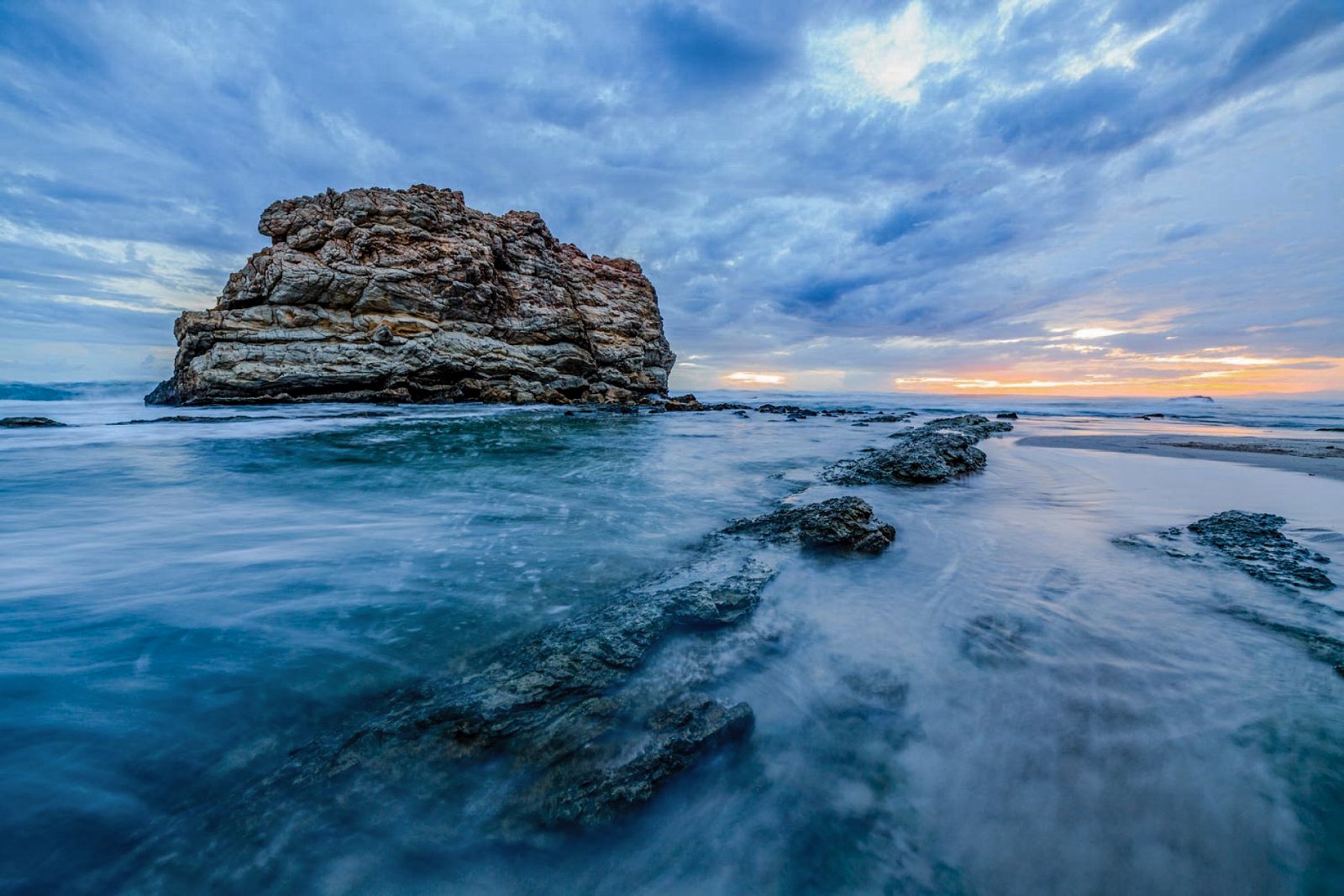
Southern Nicoya
Travel inspiration.


landed.travel
LANDED: the finest in private, tailor-made travel to Latin America and Antarctica. Smile. You’ve LANDED 🛬 www.landedtravel.com


Cocos Island

Cocos Island, Costa Rica
Pacific Ocean Area: 23.52 kms2 Area de Conservacion Marina Cocos
Isla del Coco is located in the Costa Rican Pacific Ocean, at an approximate distance of 532 km / 330 miles southwest of Cabo Blanco, Nicoya Peninsula. The Cocos Marine Conservation Area (ACMC) is one of the eleven Conservation Areas that make up the National System of Conservation Areas (SINAC) of the Republic of Costa Rica. Its mission is to observe the ecosystems of the ACMC, through the execution of an adequate management of its natural resources, and to constantly increase its knowledge and that of its area of influence.
This National Park was created in 1978, it has been declared a World Heritage Site by UNESCO since 1997. Due to its characteristics, Coco Island is one of the most privileged natural sites worldwide. It is recognized as a reservoir of biodiversity and endemism, a site of exceptional scenic beauty. The blue-turquoise water is extraordinarily clear and makes a great habitat for an abundance of marine life, making this island one of the most extraordinary places in the world for diving. It also has beautiful evergreen forests and numerous impressive waterfalls.
When visiting Coco's Island National Park, tropical animals and exotic avian and marine life are just a few of the attractions that magnetize travelers visiting this beautiful island. A trek through the national park will likely expose visitors to many kinds of wildlife that are so rare, they cannot be located anywhere else on the planet. In the nearby water, 270 kinds of fish are abundant, and a snorkeling adventure provides an intimate view of their variety. These exceptional finds are conventional discoveries in Cocos Island National Park fauna. The phenomenal flora is exhibited by the 235 breeds of plants that punctuate the island’s versatile landscape.
Volcanic transformation has carved cliffs and valleys into the island landscape, creating a spectacular panorama. The absence of colonization has helped to preserve the island’s stunning and pristine composition. This lack of human settlement means that there are no hotels, hostels, or cabins for overnight stays on the island. The intent is for Coco’s Island to remain a preserved sanctuary for wildlife and maintain an unsullied view for travelers in search of nature’s secrets. For visitors, there is an information center, a park ranger’s station, trails, signage, restroom services, potable water and several lookout points.
The island is accessible exclusively by boat. From the Port of Puntarenas you can reach Isla del Coco National Park by boat. The trip takes about 36 hours. The park is open all year, every day of the week. There are two sectors: Bahía Wafer and Bahía Chatham. Snorkeling is a favorite pastime. For visitors, there is an information center, a park ranger’s station, trails, signage, restroom services, potable water and several lookout points.
Contact our Cocos Island, Costa Rica Vacation Guides today by visiting our Costa Rica Trip Planner !
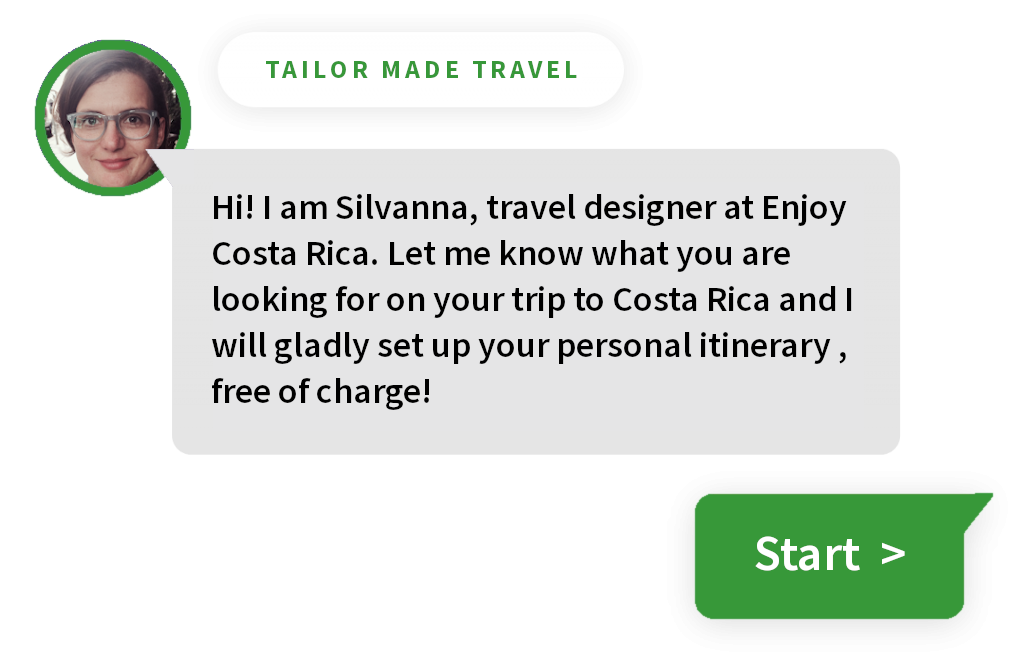
Take advantage of the search to browse through the World Heritage Centre information.
Share on social media
Unesco social media, cocos island national park.
- Description
Cocos Island National Park, located 550 km off the Pacific coast of Costa Rica, is the only island in the tropical eastern Pacific with a tropical rainforest. Its position as the first point of contact with the northern equatorial counter-current, and the myriad interactions between the island and the surrounding marine ecosystem, make the area an ideal laboratory for the study of biological processes. The underwater world of the national park has become famous due to the attraction it holds for divers, who rate it as one of the best places in the world to view large pelagic species such as sharks, rays, tuna and dolphins.
Description is available under license CC-BY-SA IGO 3.0
Parc national de l'île Cocos
Le parc national de l'île Cocos, situé à 550 km au large de la côte pacifique du Costa Rica, est la seule île du Pacifique tropical oriental possédant une forêt tropicale humide. Son emplacement – au premier point de contact avec le contre-courant nord-équatorial – et la myriade d'interactions entre l'île et l'écosystème marin environnant font de ce parc un laboratoire idéal pour l'étude des processus biologiques. Le monde sous-marin du parc national est devenu célèbre et de nombreux plongeurs le considèrent comme le meilleur endroit au monde pour observer les grandes espèces pélagiques comme les requins, les raies, les thons et les dauphins.
منتزه جزيرة كوكوس الوطني
يُشكّل منتزه جزيرة كوكوس الوطني، الواقع على مسافة 550 كيلومترا في عرض ساحل كوستاريكا المتوسطي، الجزيرة الوحيدة للمحيط الهادئ الإستوائي الشرقي التي تنعم بغابة إستوائيّة رطبة. وبفضل موقعه عند أوّل نقطة تلاقي مع التيّار البحري الإستوائي الشمالي المضاد وتفاعله بين الجزيرة والنظام البيئي البحري المحيط، أصبح هذا المنتزه مختبراً مثالياً لدراسة العمليّات البيولوجيّة. وقد ذاع صيت عالم ما تحت البحار في هذا المنتزه الوطني الذي يعتبره العديد من الغطّاسين أفضل مكانٍ في العالم من أجل مراقبة الأصناف المحيطيّة الكبيرة مثل سمك القرش والشفنين والتنّ والدلفين.
source: UNESCO/CPE Description is available under license CC-BY-SA IGO 3.0
科科斯岛国家公园距哥斯达黎加太平洋海岸550公里,是热带东太平洋上唯一拥有热带雨林的岛屿,其位置最接近北赤道逆流,又是该岛和周围海洋生态系统全面相互影响的地方,因此这个地区是研究生物进程的理想实验室。公园的海底世界非常著名,吸引了众多的潜水员,因为这里被认为是世界上观看远洋生物的绝佳地点,鲨鱼、鳐鱼、金枪鱼以及海豚等随处可见。
Parque Nacional Isla del Coco
Situada a 550 km del litoral costarricense, la Isla del Coco es la única de la zona tropical del Pacífico Oriental que posee un bosque húmedo tropical. Es un laboratorio ideal para el estudio de los procesos biológicos, debido a su ubicación en el primer punto de contacto con la contracorriente norecuatorial y a sus múltiples interacciones con el ecosistema marino circundante. Los fondos marinos del parque nacional son famosos y muchos submarinistas estiman que son los mejores del mundo para observar especies pelágicas de grandes dimensiones, como tiburones, rayas, atunes y delfines.
source: NFUAJ
Nationaal park Cocos eiland
Het nationaal park Cocos Eiland ligt 550 kilometer van de Pacifische kust van Costa Rica en is het enige eiland in de tropische oostelijke Stille Oceaan met een tropisch regenwoud. Het gebied is een ideaal onderzoeksgebied voor de bestudering van biologische processen. Ten eerste omdat het eiland het eerste contactpunt vormt met de noordelijke equatoriale tegenstroom. Ten tweede vanwege de talloze interacties die plaatsvinden tussen het eiland en het omringende mariene ecosysteem. De onderwaterwereld van het gebied is bekend geworden vanwege de populariteit bij duikers. Zij beschouwen de plek als een van de beste plaatsen ter wereld om haaien, roggen, tonijn en dolfijnen te bekijken.
Source: unesco.nl
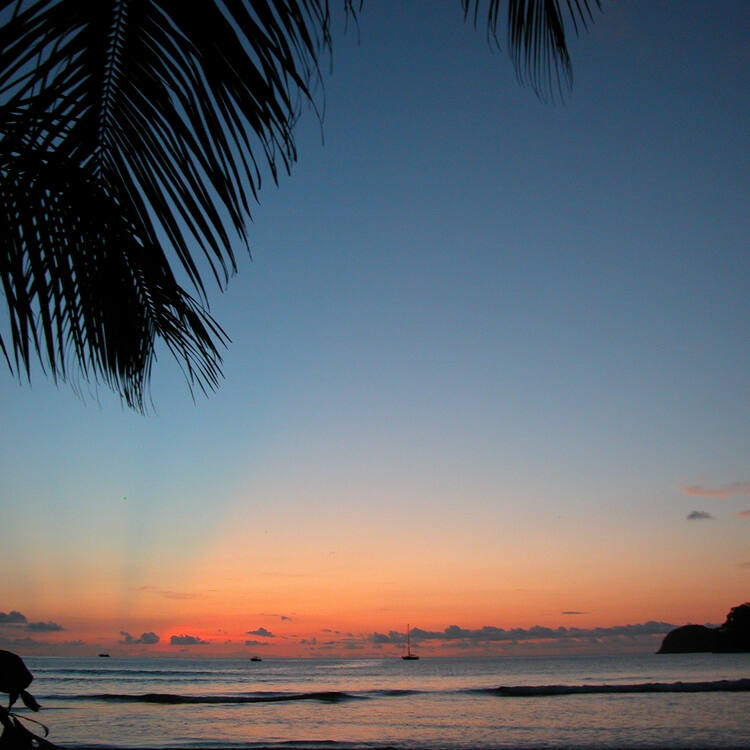
Outstanding Universal Value
Brief synthesis
Cocos Island National Park is located in the Eastern Tropical Pacific, covering an area of 202,100 hectares some 530 kilometers off the Costa Rica mainland. The island itself, “Isla del Coco”, also known as “Treasure Island”, is the only landmark of the vast submarine Cocos Range. With a surface area of 2,400 hectares it supports the only humid tropical forest on an oceanic island in the Eastern Tropical Pacific. The remaining 199,700 hectares protect not only diverse marine ecosystems, mostly pelagic but also, the most diverse coral reefs of the entire Eastern Tropical Pacific. Thanks to its remote location and conservation efforts, the biologically highly diverse property constitutes one of the best conserved marine tropical waters, well-known as a world-class diving destination. The property belongs to the Eastern Tropical Pacific Marine Corridor, a marine conservation network, which also includes World Heritage properties in Colombia, Ecuador and Panama.
Natural population densities of large top predators indicate a near pristine conservation status of a property that is among the most important sites in the Eastern Tropical Pacific for the protection of large pelagic migratory species, such as the endangered Scalloped Hammerhead Shark and the near-threatened Silky Shark and Galapagos Shark. Due to its geographical position, the oceanic island of volcanic origin is the first landmark met by the North Equatorial Countercurrent and a point of confluence of other marine currents. This makes it a dispersing centre of larvae of marine species from various parts of the Pacific Ocean. In its land portion, the property hosts a remarkable degree of endemism across most diverse taxonomic groups. There are, for instance, three endemic bird species, two endemic freshwater fish and two endemic reptile species. Cocos Island National Park is of irreplaceable global conservation value, reminding us what parts of tropical oceans historically looked like.
Criterion (ix): The property harbours a rare and complex mosaic of land and sea environments, including forested mountains, rivers, waterfalls, estuaries, cliffs, sandy and rocky beaches, bays, and extensive and highly diverse coral reefs and pelagic environments. The oceanic island, more than 500 kilometers off the continent, is mostly occupied by tropical rainforest and, from around 500 m.a.s.l. to the highest elevation at 634 m.a.s.l., by cloud forest. The isolation has been allowing ongoing evolutionary processes on land, giving origin to countless endemic species in the most diverse taxonomic groups, including several vertebrate species. The geographic location at the meeting point of the North Equatorial Countercurrent with other major marine currents and the ecological interactions between a remote island and the surrounding marine ecosystems are of major scientific importance. The currents and the island affect the movements and distribution of the many migratory marine species aggregating for feeding and reproduction in the waters around the island. The property serves as a dispersion centre of larvae of numerous marine species coming from the entire Pacific. The islets and rocks around the main island are reported to also serve as important cleaning stations, i.e. pelagic species aggregate to have parasites removed by specialised fish and other species.
Criterion (x): The small island supports the only tropical forest ecosystem located on an oceanic island within the Tropical Eastern Pacific. It is home to some 70 endemic species of vascular plants and several endemic animals, including three birds, two reptiles and even two freshwater fish. Smaller satellite rocks around the island support nesting and resting habitats for numerous migratory and resident bird species. However, the main species conservation value derives from critical marine habitat and the corresponding role of the property in the conservation of large pelagic species, especially several species of sharks. Among the latter are exceptional aggregations of the near-threatened Silky and Lemon Shark, the vulnerable Bigeye Thresher Shark and Galapagos Shark, the emblematic and endangered Hammerhead Shark, as well as White-tip Reef Shark and Black-tip Shark. Among some 300 recorded fish species are important aggregations of large pelagic fish, such as the vulnerable Whale Shark and Blue Marlin, as well as Sailfish Broadbill Swordfish, Shortbill Spearfish, Giant Manta Ray and Pelagic Stingray. Blue Whale and Bottlenose Dolphin are among the visiting marine mammals.
The isolation of Cocos Island National Park contributes to the safeguarding of evolutionary processes, which are the basis of the notable richness and abundance of land and marine life forms. Provided that alien invasive species of both flora and fauna can be controlled, the conservation prospects on land are promising. In the marine areas, the large aggregations of top predators, including but not limited to numerous shark species, demonstrate the integrity within an intensively fished marine region. The entire property is one of the rare marine no-take areas and as such makes an invaluable contribution to conservation as a safe haven for marine life, and as a nursery and dispersal centre – provided illegal fishing can be kept at bay. While many of the aggregations occur in a relatively small area within the property, the marine limits fail to do justice to the life cycles of the many migratory species. Cocos Island National Park cannot achieve the long-term conservation of species indiscriminately exploited in the wider Eastern Tropical Pacific and elsewhere. The critical factor for the long run integrity not only requires adequate management of the property but also sustainable fishing levels outside of it. The Eastern Tropical Pacific Marine Corridor provides a highly needed framework for international cooperation in this regard.
Protection and management requirements
While there is no evidence of pre-Columbian occupation, fishermen, pirates, whalers, commercial sailors and scientific expeditions have long used Cocos Island as shelter and to procure fresh water. Attempts to settle the island include a brief episode of running a prison, but eventually all such attempts have been unsuccessful. Today the human presence is restricted to a rotating group of conservation staff, tourists, and visiting scientists. The entire property is strictly protected by law, state-owned and managed by Costa Rica’s National Park Service under the Ministry of Environment and Energy in cooperation with other governmental and non-governmental institutions, such as the “Friends of Cocos Island Foundation”. Any extraction of marine resources and all commercial, industrial or agricultural activities are banned. Management planning guides interventions with a focus on planning of public use and tourism, protection of sensitive sites, alien invasive species, scientific research, and the review of relevant legislation. Sufficient staff and funding is needed to secure adequate operations, which is costly due to the remote location.
On land, the main threats are invasive alien species of both flora and fauna. While no mammals originally existed on the island, deer, wild boar, cats and rats have been introduced with complex effects on the ecosystems, as well-documented from small island settings around the globe. Temporary settlers brought plants like guinea grass and coffee. The latter has since been invading the understory of the forests. Continuous monitoring and management are needed to eradicate alien invasive species to the degree possible and to prevent new invasions through and strict and enforced protocols for all visitors to the island. In the waters, illegal fishing is common despite efforts by national authorities and non-governmental organizations. Therefore, continuous monitoring and law enforcement is needed, as is awareness-raising with the fishing industry. Tourism activities around the island, mostly recreational diving, likewise require adequate monitoring and control to prevent disturbance in the highly localised areas of major aggregations of fish, as well as littering and other pollution caused by passing vessels and yachts. Following the 1982/1983 El Niño event, about 90 percent of the coral reefs of Cocos National Park died off, a dramatic reminder how protected areas can be affected by events far beyond their boundaries. Eventually, for conservation to be effective in the long term, measures are needed at a much larger geographical scale. These measures could include extensions, buffer zones and, at the international level, coordination and cooperation with other marine protected areas in the Eastern Tropical Pacific, including World Heritage properties in Colombia, Ecuador and Panama.
- Protectedplanet.net
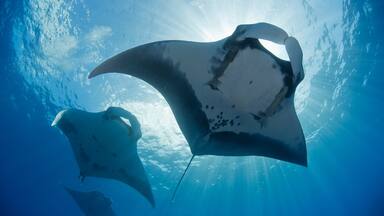
The Nomination files produced by the States Parties are published by the World Heritage Centre at its website and/or in working documents in order to ensure transparency, access to information and to facilitate the preparations of comparative analysis by other nominating States Parties.
The sole responsibility for the content of each Nomination file lies with the State Party concerned. The publication of the Nomination file does not imply the expression of any opinion whatsoever of the World Heritage Committee or of the Secretariat of UNESCO concerning the history or legal status of any country, territory, city or area or of its boundaries.
State of Conservation (SOC)
Protections by other conservation instruments.
1 protection / 1 element
- Isla del Coco
Read more about synergies
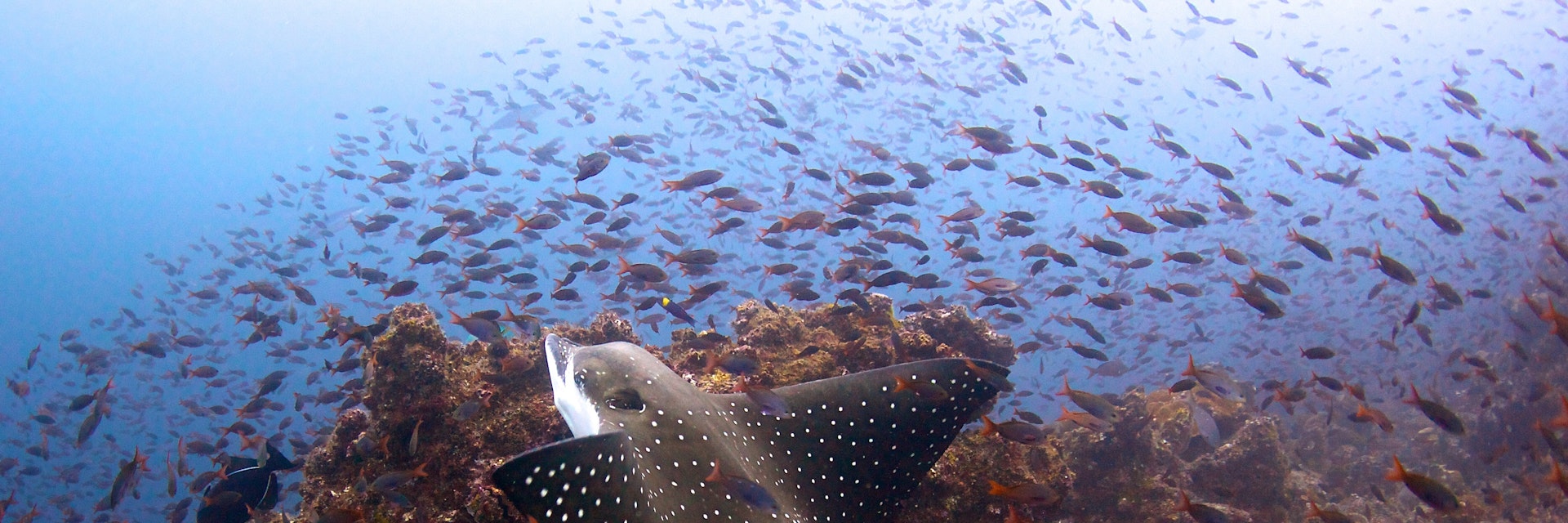
Shutterstock / Nicolas Aznavour
Parque Nacional Isla del Coco
Top choice in Southern Costa Rica & Península de Osa
Around 500km southwest of the Costa Rica mainland, Isla del Coco is a natural wonder that teems with wildlife, including the largest schools of hammerhead sharks on the planet. For that reason, divers descend from all corners, often venturing out on liveaboard trips with companies like Aggressor and Undersea Hunter . There's also some fascinating pirate history here, and apparently some buried treasure.
Get In Touch
https://www.cocosisland.org/
- Find Your Trip
- Vacation Ideas
- Travel Tips
Customized Costa Rica Vacations, since 1999.
Cocos Island
The mecca for divers a remote, stunning island destination on the pacific ocean in costa rica..
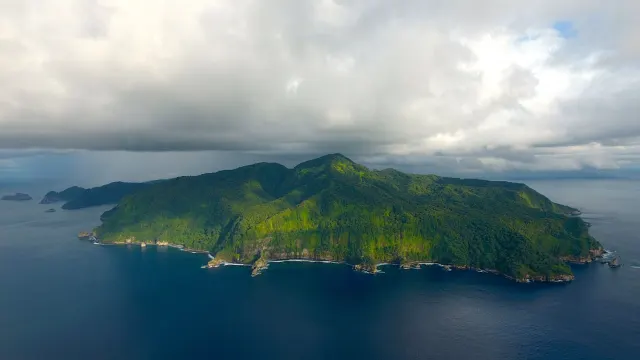
Cocos Island at a Glance
- Ideal for: Seasoned divers, adventure seekers and n ature lovers.
- Nearby activities: Scuba diving, wildlife watching, hiking and sportfishing.
- Main dive spots: Bajo Alcyone, Dirty Rock, Dos Amigos Grande, Everest, Manuelita Coral Garden (night dives).
Special Features:
We live, work & travel in Costa Rica.
Every trip is designed for you.
5,000+ reviews from dazzled guests.
ON THE PALAU SIREN!

Search form
- Best Scuba Diving In The World
- Best Diving in Asia
- Best Diving in Africa
- South Africa
- Zanzibar, Tanzania & Kenya
- African Land Safaris
- Tanzania Land Safari
- Australia Best Diving
- Great Barrier Reef
- Caribbean Best Diving
- British Virgin Islands
- Cayman Islands
- Dominican Republic
- Jardines de la Reina
- Roatan, Utila & Guanaja
- Saba, St Kitts & St Eustatius
- St. Vincent and the Grenadines
- Tiger Beach
- Trinidad & Tobago
- Turks and Caicos
- Best Diving in Costa Rica
- Cocos Island
- French Polynesia Best Diving
- Galapagos Islands
- Andaman Islands
- Indonesia - Top 10 Areas
- Cenderawasih Bay
- Derawan Islands
- Lembeh Strait
- Manado and Bunaken
- Raja Ampat Area
- Wakatobi National Park
- Best Scuba Diving in Mexico - Top 9
- Baja California
- Cabo San Lucas
- Guadalupe Island
- Isla Mujeres
- San Ignacio Gray Whales
- Sea of Cortez
- Socorro Islands
- Micronesia Dive Guide
- Bikini Atoll
- Truk Lagoon
- Saudi Arabia
- Southeast Asia - Top Areas
- Philippines - Top Areas
- Cebu and Bohol
- Malapascua Island
- Puerto Galera
- Papua New Guinea
- Solomon Islands
- Thailand Best Diving
- Similan Islands
- Best Diving in the USA
- Best Scuba Diving in Hawaii
- Catalina Island
- Southern California
- All 110 Destinations
- Best Liveaboard Destinations
- All Liveaboard Destinations
- Bahamas Liveaboards
- Belize Liveaboards
- Caribbean Liveaboards
- Cocos Island Liveaboards
- Galapagos Liveaboards
- Great Barrier Reef Liveaboards
- Indonesia Liveaboards
- Komodo Liveaboards
- Maldives Liveaboards
- Norway Liveaboards
- Palau Liveaboards
- Philippines Liveaboards
- Raja Ampat Liveaboards
- Red Sea Liveaboards
- Sea of Cortez Liveaboards
- Socorro Liveaboards
- Thailand Liveaboards
- Tubbataha Liveaboards
- Turks & Caicos Liveaboards
- 170+ Liveaboards Worldwide
- Bali Dive Resorts
- Belize Dive Resorts
- Bonaire Dive Resorts
- Caribbean Dive Resorts
- Cayman Islands Dive Resorts
- Cozumel Dive Resorts
- Fiji Dive Resorts
- French Polynesia Dive Resorts
- Indonesia Dive Resorts
- Maldives Dive Resorts
- Mexico Dive Resorts
- Palau Dive Resorts
- Philippines Dive Resorts
- Raja Ampat Dive Resorts
- Roatan, Utila, & Guanaja Dive Resorts
- Sipadan Dive Resorts
- 200+ Dive Resorts Worldwide
- All Guided Group Trips
- swim with whales
- Off the beaten track
- African Safari Trips
- Bluewater Travel's 50 Amazing Adventures
- All Dive Travel Specials
- Best Of Articles
- All Articles
- Top 10 Lists
- Top Luxury Liveaboards
- Top Rated Liveaboards
- Travel Search
- Travel Insurance
- Terms of Service
- Leave a review
- Learn Underwater Photography
- Buy Underwater Camera Gear
- Get Scuba Certified
Cocos Island Diving
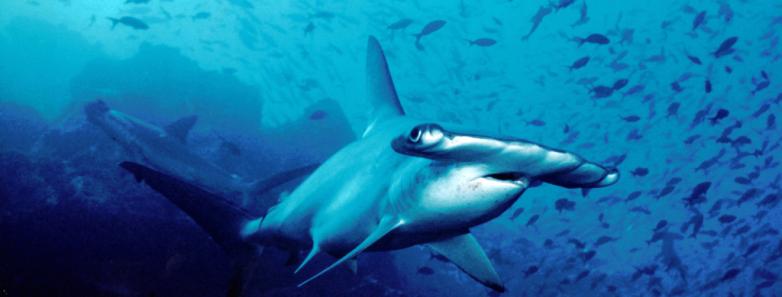
Scuba diving in cocos island, Costa Rica
Cocos island diving highlights.
Cocos Island is one of the world's best scuba diving destinations for diving with big animals . Schooling hammerhead sharks is what the Cocos Island diving scene is most famous for, but you can find many other shark and ray species, including white tip reef sharks, silky sharks, the occasional whale sharks, manta rays and marble rays.
Cocos is also home to 27 endemic fish species including the red-lipped batfish , that are also commonly found in the Galapagos. Divers can also see large schools of jacks and tuna, Creole fish, green turtles, and octopus, and the list goes on...
Interested in Cocos Island? View the live availability of some of the best liveaboards in Cocos Island and book online at the best price or check out our sidebar for specials and workshops there!
Read why Cocos is one of the best shark diving destinations in the world.
Marine Life & Environment - Diving Conditions
How to Get There - How to Dive Cocos Island - Best Time to Dive
NEW! Find a Liveaboard - Practical Information - Book a Trip
Intro to Cocos Island
Belongong to Costa Rica, Cocos Island is the mecca for divers looking for big animals, open ocean, and advanced diving. Howard Hall's film " Island of the Sharks " was filmed here, and sharks are the main attraction. Cocos Island is not a place with pretty corals or reefs. It is a gorgeous, uninhabited island, approximately 5 x 2 miles (8 x 3 km) in size. The bottom is a sloping rocky substrate without a lot of colors.
Find out about other places to scuba dive in Costa Rica .
What you do get with Cocos Island diving is amazing marine life - prolific shark populations including reef whitetip and scalloped hammerheads, plus a chance of many other species. There is also great schooling fish action, and a good chance of seeing true pelagics like wahoo, tuna, and even billfish. If you are comfortable with deep (100ft) nitrox diving in open oceans, and the possibility of swell, strong currents and low vis, Cocos Island can be the apex dive trip of your dive career. It is not a place for non-divers.
Interested in pretty coral reefs? Scuba diving in the Philippines is a great option.
Cocos Island is quite a beautiful island to look at topside, and short excursions to the island are possible, but you are on the boat almost all of the time. The island is lush and green with rainforest and waterfalls. Malpelo Island is another destination that Cocos liveaboards sometimes visit during the same trip. It is not that attractive and you can not go ashore.
View Location on Google Map
Back to Menu
Diving Information

cocos island diving with Hammerhead sharks
Hammerhead sharks are drawn to Cocos Island to be cleaned by King angelfish, butterflyfish and other small fish. These islands are basically giant cleaning stations.
Other marine life in cocos island
Scuba diving in Cocos Island is always exciting, with dozens of white-tip sharks usually seen on every dive, at any depth, cruising around the rocks. Enormous schools of big-eyed jacks, barracuda, snappers and grunts are seen on many dives, and the size of these schools must be seen in person to appreciate.
Marble rays are very frequently seen in groups of 5-20, feeding on the bottom at 100ft. Marble rays are easy to approach and are always cruising around like they are on parade.
Whale sharks occasionally pass through, and there are often a couple of sightings on a trip. Large tuna, mantas, silky and silvertip sharks are often seen as are eagle rays. Orcas, tiger sharks, dolphins, wahoo, and sailfish are also seen but not on every trip.
Dolphins and tiger sharks are quite frequently seen, up close. Divers have seen dolphins hunting jacks. Galapagos sharks, which can be aggressive, are not as common but do sometimes appear.
cocos island Diving Conditions
- Water Temperatures: In June/July, the water is sometimes 81 degrees at all depths. It stays from 80-82 during the summer. The water can get much colder, down in the lower 70s in the winter. Thermoclines are common, and deep down can get into the 60s.
- Visibility: In June, July the visibility was 50-70ft. Visibility can be variable but 30-50ft is the norm, with even better visibility from Jan - May.
- Depth Range: 30 – 131 feet (10 – 40m)
Typical Cocos Island scuba Dive
On a typical scuba dive at Cocos Island, you drop down as a group to a depth of 100ft, spread out and find a rock to hide behind. You then look for a cleaning station for hammerhead sharks, which is often a larger rock with many angelfish and butterflyfish around it. Hammerhead sharks are easily spooked by erratic divers' flailing limbs and exhaust bubbles. Attempting to approach these sharks usually only leads to their quick retreat. In order to get a chance at a close approach, enabling opportunities for good photographs, quickly and carefully locating a suitable rock to hide behind and controlling your buoyancy and breathing is essential.
Divers are advised to become "blue" divers; (holding your breath when the sharks approach). By following the divemaster's directions, calming down, being patient you will greatly improve your chances of close passes and prolonged encounters.
3 dives a day are the norm at Cocos Island, with occasional night dives. On several days a night dive will be offered with white-tipped reef sharks. Divers' lights illuminating the fish causes a feeding frenzy with the sharks. Any fish or turtle illuminated by a dive light will be quickly assassinated by several sharks, and because of this, some divers may not enjoy this dive or choose not to do it. On a remote trip like this, you need to pay attention to your depth & time, and follow the divemaster's instructions carefully, and double check your surface marker buoy at the beginning of each dive.
Travel Information
How to get to cocos island.
Liveaboards depart from Puntarenas, Costa Rica, a two hour bus transfer from San Jose, Costa Rica. Travel time is approximately 40 hours to Cocos Island, 43 hours to Malpelo, and 40 hours from Cocos to Malpelo. At certain times of the year the crossing can be very rough with big swells and seasick passengers.
How to scuba Dive Cocos Island
The only way to get to the island is via liveaboard dive boats. Most liveaboards offer 10-day trips, with 7 days of diving and 3 dives a day.
Best Time to scuba Dive Cocos Island
Scuba diving Cocos Island can be done in both rainy season and dry season. If you visit the islands in June/July, you may have a chance of having both big animal encounters and calm seas. The dry season is Dec - May, which can bring silky sharks, dolphins and mobulas, calmer waters and smoother crossings. The rainy season is June - Nov; and crossings can be a little rough, there's a lot of rain, but Hammerhead sharks are in larger numbers. That said, you will usually see good numbers of hammerheads throughout the year. May - Aug are probably the best months to go, but sightings/conditions can be highly variable. Note that hammerhead sharks sometimes go deep during an "El Nino" year.
Topside & Non-Diving Activities
Costa Rica is one of the top nature destinations in the world. There are excellent opportunities to see monkeys, toucans, brilliantly colored tree frogs, parrots, sloths, and many more birds and animals. The country is small, easy to travel around, and relatively safe. Make sure you know what to pack for Costa Rica so you've got everything you need to enjoy every minute of your trip without having to worry where to find it when you're there! We highly recommend some time exploring the county either before or after your Cocos trip. There are not many non-diving activities at Cocos Island itself.
Liveaboard availability
Back to Menu
Other Useful Information
Practical information.
- Currency: Costa Rican Colón (CRC)
- Language: The official language is Spanish, but English is widely spoken within tourism-related areas
- Main Airport Code: SJO
- Time Zone: UTC-6
- Electricity: 120V / 60Hertz
GOT QUESTIONS? READY TO BOOK?
Call us today at 310-915-6677 or email us [email protected]
And let us book your dream vacation!
Reviews (3)
- Sort Recent
- Sort Helpful
- Sort Alphabetically
- Top Reviewer
Cocos is scalloped hammerhead central. If you want to get close to hammerheads daily, and see a wall of hammerhead sharks, there are not many places that can compare than Cocos. Expect to also see massive schools of Jacks, lots of marbled rays, Galapagos sharks, silvertip sharks, silky sharks and white tip reef sharks. Making an occasional appearance are also tiger sharks, whale sharks and mantas. leave your macro lens at home. The best night dive in the world can also be found in Cocos where you see hundreds of whitetips hunting for food and getting into a feeding frenzy. There is no need for baited shark dives. The island itself is a beauty. You will pass by numerous waterfalls on your way to the dive sites. A visit to to the ranger station and a hike up to a viewpoint is also a must do on Cocos Island. A dive trip to Cocos is an adventure of a lifetime and well worth the 36 hour crossing from Puntarenas on mainland Costa Rica.

Cocos Island is my favorite dive destination - I have only had other trips come in second or third but never ahead of this one! We dove with the Undersea Hunter group and they are excellent on all levels. They have three boats for their live aboard operations; The Sea Hunter, Undersea Hunter and the Argo. We stayed on the Undersea Hunter which is the smallest boat and therefore takes a smaller group of people which I prefer. The Argo is the more luxurious vessel and is a very beautiful if you don't mind parting with the extra money. There is also a deep sea submersible that sometimes goes out on the Sea Hunter if there are guests that want the experience of a deeper dive.
Every dive site we went to had something spectacular to see. Besides large schools of hammerheads at sites like Alcyone, we saw silky and galapagos sharks. An added adventure is night diving with schools of white tips on the hunt. There is no end to what you can see at sites like Manuelita (outside) because the currents bring in all sort of pelagic life; several species of rays, whale sharks and tiger sharks. Turtles, sharks and rays continuously circle in the shallows looking for the cleaner fish and it's a treat to watch all the activities. It's amazing what can swim by on an open water drift. We had dolphins, sharks and rays pass us on an early morning safety stop.
Then there are the fish! Not everyday fish either! Cocos is a place where you can see the oddball batfish in relatively shallow water. I found the always busy leather bass fun to watch and photograph. You will also see very large schools of jacks and large predatory fish that the sharks follow in search of food.
The crew on the boat are the best and so is the food. The cabins were comfortable and there were plenty of places to relax on the boat. You will want for nothing on the Undersea Hunter boats!
Dive Specials

Liveaboards

BE THE FIRST TO GET NEWS AND SPECIALS
Sign up for the mailing list today

310-915-6677 [email protected]
- OUR DIVE TRAVEL EXPERTS
- TERMS OF SERVICE
Aggressor Adventures™
Cocos island.
- Indo Aggressor ®
Schooling hammerheads, countless white-tip sharks, mantas, tuna and even whale sharks call Cocos home.
Escape to Cocos Island for a Costa Rican liveaboard scuba diving adventure! Cocos is a lush, green uninhabited island resting 342 miles off Costa Rica's Pacific coast. Rocky pinnacles surrounding Cocos are beacons for big animals and big action. Schooling hammerheads, countless white-tip sharks, mantas, tuna and even whale sharks call Cocos home.
Specials & Unique Charters
View Dates & Details
- Explore The World Weeks - Save 25%
- SAVE $3000 Cocos Island
Travel - Cocos Island
Airfare, Hotels & Excursions
The Okeanos Aggressor II® and Cocos Island Aggressor ® depart from Puntarenas, Costa Rica. Boarding and departure depends on the tide schedule. Immediately after boarding for our Costa Rica liveaboard scuba diving adventure, the yacht departs for its 36 hour crossing to Cocos Island.
- Average dives per charter: 15 on 8 night; 21 on 10 night; 27 on 12 night No night diving is currently offered at Cocos Island.
- Depth Range: 55 ft – 110 ft (16m – 33m)
- Water temperatures range from 72 - 82F, 22 - 28C with cooler thermoclines. 3 - 5 mm wetsuit recommended
The Okeanos Aggressor II and Cocos Island Aggressor are each equipped with two 8' x 22' tenders. All dives from tenders.
Cocos Island Itinerary
Four brands, one family - choose your adventure.
- Aggressor Liveaboards™
- Aggressor River Cruises™
- Aggressor Safari Lodge™
Congratulations! You have found the hidden treasure Please fill in your name and email below so we can reach out to you
Cocos Island Liveaboard

Cocos Island fully justifies its place as one of the world's finest liveaboard destinations. This remote Pacific outpost is a magnet for sharks, most notably large schools of hammerheads.
Eagle ray in the Maldives
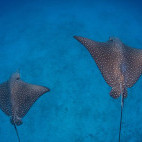
Image courtesy of Wind Dancer

Image by Carlos Villoch (courtesy of Wind Dancer)

Located over 500 kilometres off the western coast of Costa Rica, the only way to dive Cocos Island is by liveaboard. A number of vessels offer ten-night itineraries throughout the year. From April to November, these waters are famous for encounters with vast schools of scalloped hammerheads. November to April brings calmer weather conditions and more excellent marine life encounters.
In addition to hammerheads, divers may encounter bull, silky, silvertip, Galapagos and white-tip sharks. Eagle and manta rays are also frequent visitors, along with occasional whale sharks.
The itinerary below is based on a ten-night trip on board the Okeanos Aggressor II .
Typical Itinerary
Day 1 : fly to san josé, days 2-12 : transfer to puntarenas & begin your cocos liveaboard.
Cocos Island lies over 500 kilometres offshore and the journey takes over 30 hours to reach from Costa Rica. Your ten day liveaboard will typically include six and a half days' diving at Cocos, making three or four dives a day from a spacious tender.
Divers can expect a superb array of shark species, manta rays, large schools of jacks, tuna and barracuda plus regular whale shark and dolphin encounters.
Day 13 : Disembark & return to San José for your flight back to the UK
Day 14 : arrive uk.
Please note: Due to the remote location, this trip is recommended for experienced divers. The itinerary is a sample only and your actual one may vary. The from price is based on a twin share cabin.
- Duration and price including flights from/to UK : 14 days from £ 6,595 pp
- Departures : Exclusive departures available! View all departure dates
- Flights from the UK
- 1 night in San José (BB)
- 10 nights Cocos liveaboard
- All meals on liveaboard
- Additional fees : Park Fee US$490pp
- Additional fees : Evacuation Fee US$30pp
- Send an Enquiry
Availability
Search for your ideal departure below, and then enquire to confirm availability and book.
Cocos Island

The remote Cocos Island Marine Park lies 540 kilometres off the coast of Costa Rica and is a designated UNESCO World Heritage Site. The volcanic pinnacles surrounding the island are beacons for large pelagics, and it is one of the best places to go shark diving. Find Out More about {acc:title}
- Ideal for viewing : scalloped hammerhead shark , Galapagos shark , devil ray , bull shark , giant oceanic manta ray
- Excellent for : Liveaboard diving , Shark diving , Hammerhead shark
Cocos Island Aggressor

Operating throughout the year, this luxurious liveaboard offers dedicated diving adventures for experienced divers to the remote Cocos Island, where pelagic species abound. Hop on board for a diving trip of a lifetime. Find Out More about Cocos Island Aggressor
MV Sea Hunter

This modern, dedicated dive cruiser has been custom built for long-range expeditions to destinations like the world renowned Cocos Island. A superbly comfortable liveaboard with everything a serious diver could wish for. Find Out More about MV Sea Hunter
Okeanos Aggressor II

The Okeanos Aggressor II operates ten night itineraries throughout the year to the amazing Cocos Island, a trip of a lifetime for most. Dives are operated from pangas and deliver fantastic hammerhead shark sightings. Find Out More about Okeanos Aggressor II

This custom built working boat heads to the remote Cocos Island throughout the year and offers experienced divers plenty of luxury and the unique opportunity to get on board a submersible. Find Out More about M/V Argo
Sign Up For E-News
Sign up to get the latest on our holidays, offers and events. We generally send 1 to 3 e-newsletters per month.

Latest brochure
- Order a printed copy if you live in the UK.
- View or download it if you live outside the UK.
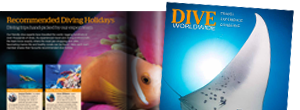
- Tailor-made specialists
- Dive travel experts
- Small group holidays
- 100% independent
- 24 hour on-call support
- 100% financial protection
- Finest dive accommodation
- Widest range of liveaboards
- Finest dive destinations
- Special interests
- Personalised travel services
- Supporter of marine life charities
- Responsible travel
- Most responsible overseas partners
Discover our other holiday experiences
Dive Worldwide is a brand of The Natural Travel Collection Ltd , Long Barn South , Sutton Manor Farm , Bishop’s Sutton , Alresford , Hampshire , SO24 0AA , UK .
Your financial protection is guaranteed by ABTOT and ATOL (number 10544) when you book with us .
- ©2024 The Natural Travel Collection Ltd, all rights reserved
- Terms of use
Countries visited: 114
Work with me, i’m currently in spain.

This is Luxury Travel
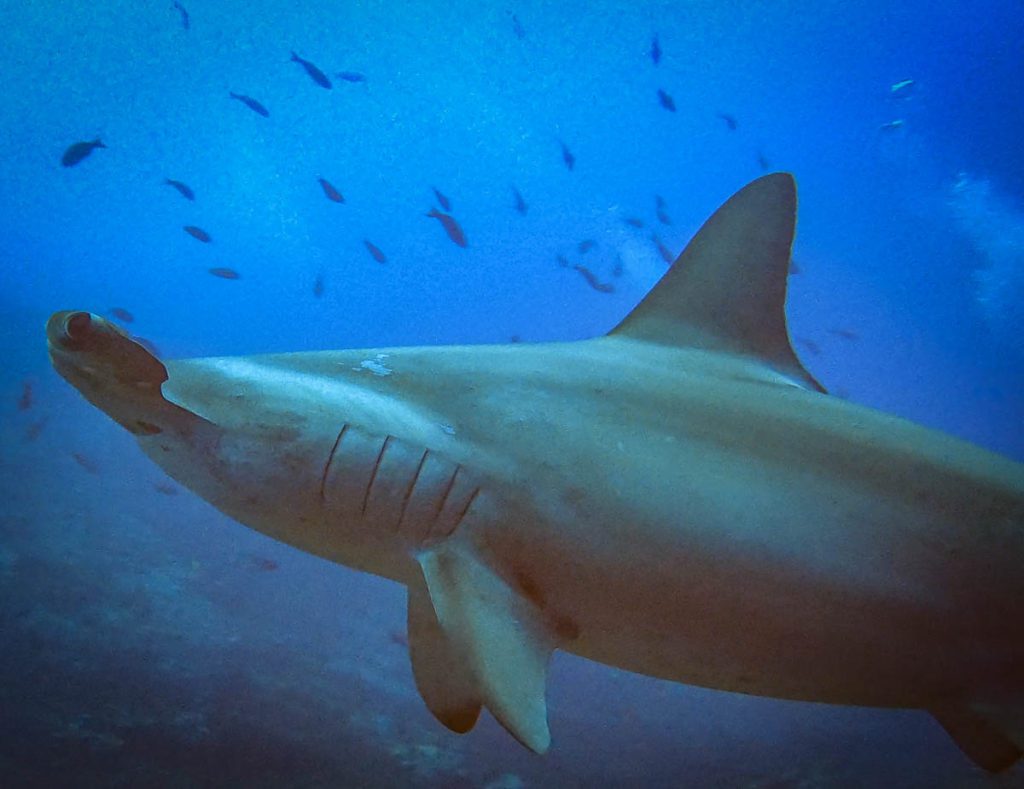
Liveaboard review: Okeanos Aggressor diving trip to Cocos Island in Costa Rica
I spent 10 days diving Cocos island on the Okeanos Aggressor 2, and this is my review of the boat and the trip. Read on to find out if it is the boat for you and for practical tips. Cocos is known as one of the best dive destinations in the world. Find out if the reputation is justified.
Read the Okeanos Cocos Aggressor review and see how it went!
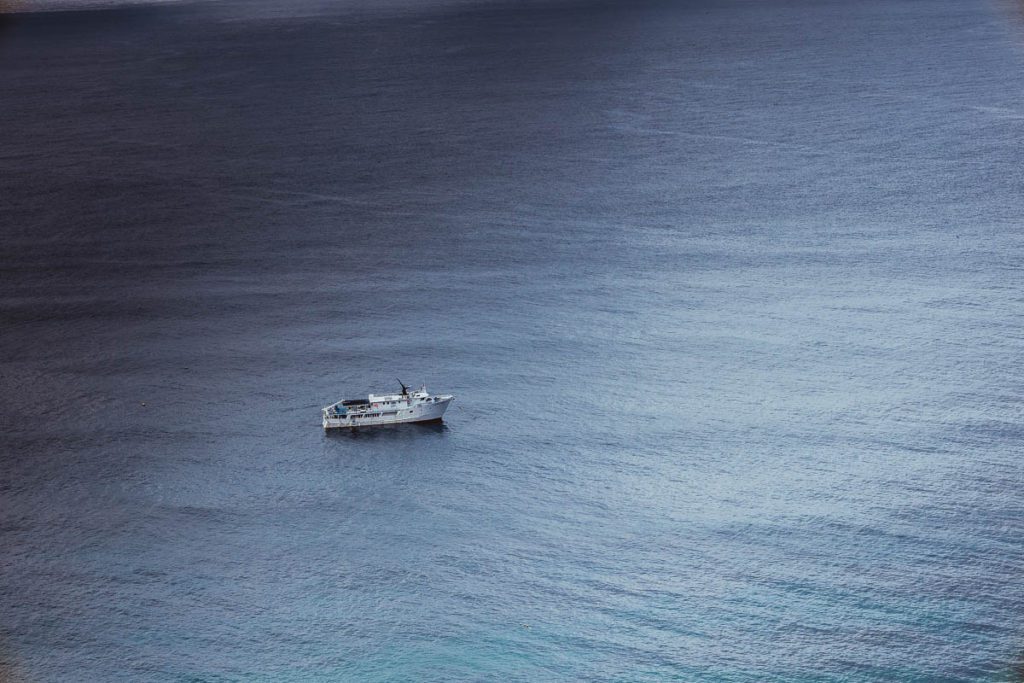
Content of this article:
Arriving on the Cocos Okeanos Aggressor
The Aggressor departs from Puntarenas, a small town 90 minutes from San Jose, the capital of Costa Rica. You are asked to spend the night before in San Jose to meet their shuttle bus early in the morning. It does make sense because if you miss the boat departure for any reason, there is no way to catch up with it the next day as the boat starts by navigating for 36 hours.
As I was already in Costa Rica doing a Marine conservation expedition, I went directly to Puntarenas and spent two nights there. It was a let-down. The town is not the most exciting place in Costa Rica. The houses are heavily protected with metal barriers and barbed wires, giving them a scary look. I didn’t feel comfortable walking alone in the streets and have been told the place could be dangerous.
Tip: I recommend spending the night in San Jose rather than in Puntarenas and meeting the Aggressor shuttle bus transfer as suggested by Aggressor.
Review of the itinerary around Cocos Island during the Okeanos Aggressor liveaboard
Day one and two: navigating to cocos island.
Cocos island is a whopping 36 hours of navigation from the mainland. The distance from any land or humans and the protection of the area make it an exceptional place to dive!
We boarded around 2 pm, were shown to our cabins, and attended the safety briefing.
We were lucky to have very calm water, making the crossing pleasant. It was a lazy day and an excellent way for all the people flying from abroad to refresh, adjust to jetlag and meet the other passengers.
We saw a massive pod of dolphins hunting, and the sunset was spectacular.
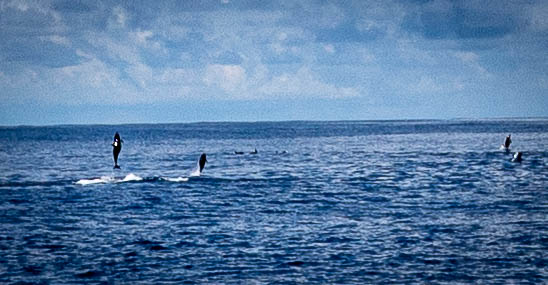
Day three: first encounter with the hammerheads
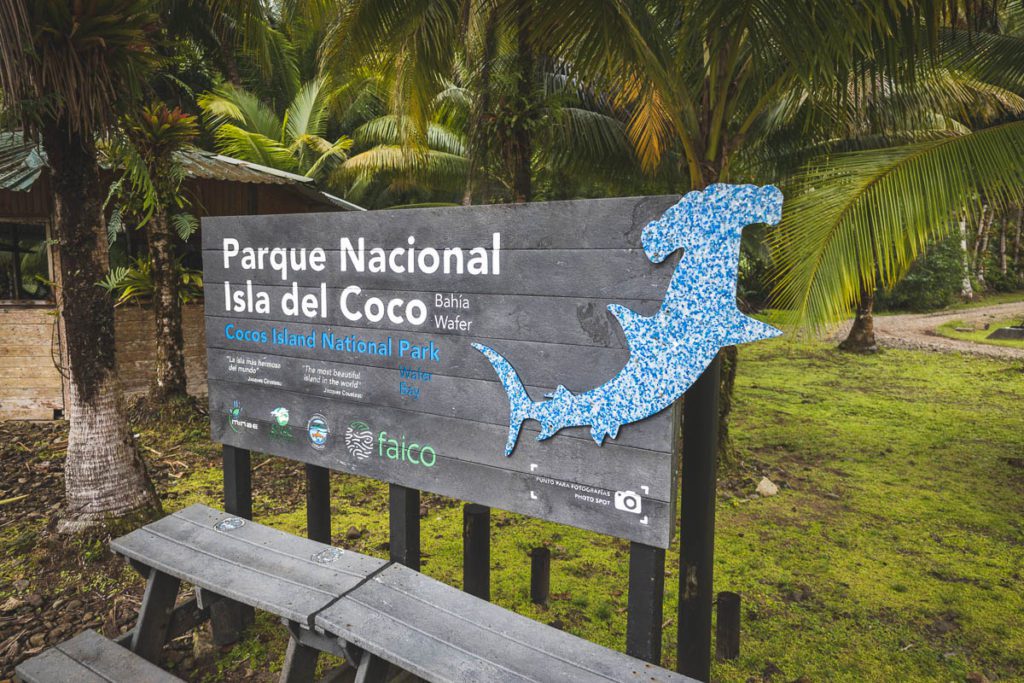
We arrived at Cocos Island’s Chatham Bay around 4 am, and it was raining hard.
After breakfast, we went for our first dive at Manuelita coral garden dive site outside the Manuelita island. It is a shallow sloping reef, starting around 6 meters and sloping down to a sandy bottom at 18 meters. It is an easy dive and perfect for a check dive.
We saw a few blacktip sharks as we went down.
Within five minutes, we saw a school of six hammerheads. They hung out with us for about 10 minutes. It was awesome!
We continued the dive and saw an octopus, a turtle, and a marble ray. The place is also full of small fishes and is covered by small coral patches. Best check dive ever!
And the water was warm at 29 degrees. So whoever tells you that you have to go to 40 meters and have cold water to see hammerheads is lying 🙂
We did two more dives around Manuelita Island. The Manuelita channel dive site is between Manuelita Island and Cocos Island. It goes down to about 30 meters. There is a cleaning station on the west side, which is a great place to spot sharks. Again, we saw plenty of hammerheads, with some of them coming really close to us.
The last dive was the Manuelitas outside dive site , the exposed western side of the island. It can face strong currents and is usually a drift dive. There are three cleaning stations along the wall, and it ends up in a sandy bottom.
Over the course of the day, I think we saw over 70 hammerheads!
We also saw five golden cow rays cruising by and a few marble rays.
The most astonishing was a massive school of Jacks mating. They were dancing two by two. The larger of the two fishes turned black while the other remained white. There were tens of couples dancing together. Amazing!
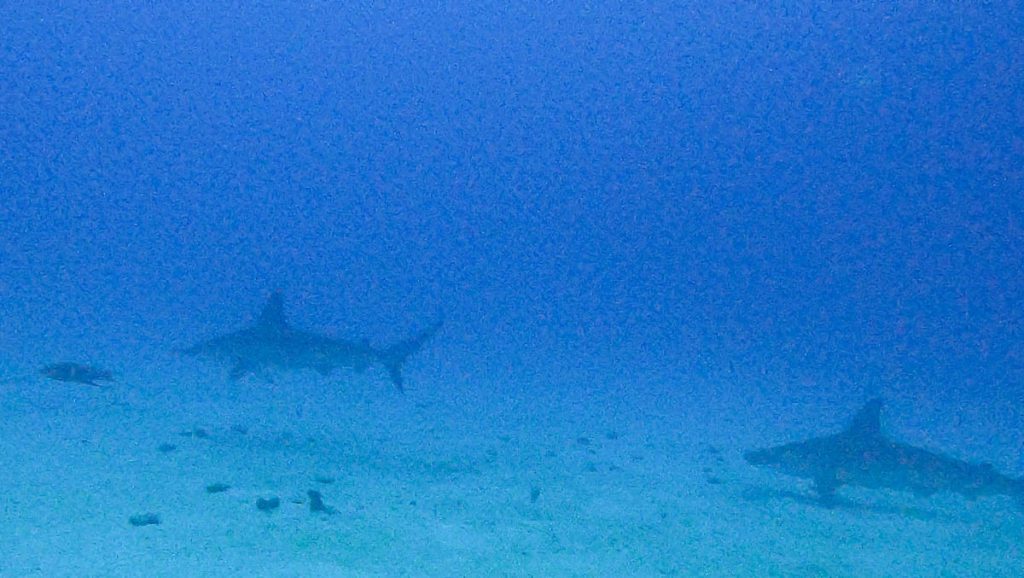
After the dives, we went for a small hike on top of Chatham Bay.
A path is going up, so the walk is not challenging but slippery. The soil at Coco’s is extra greasy after rain due to its clay content.
Tip: Bring walking shoes. Mosquito repellent is not necessary as there are no mosquitos on the island.
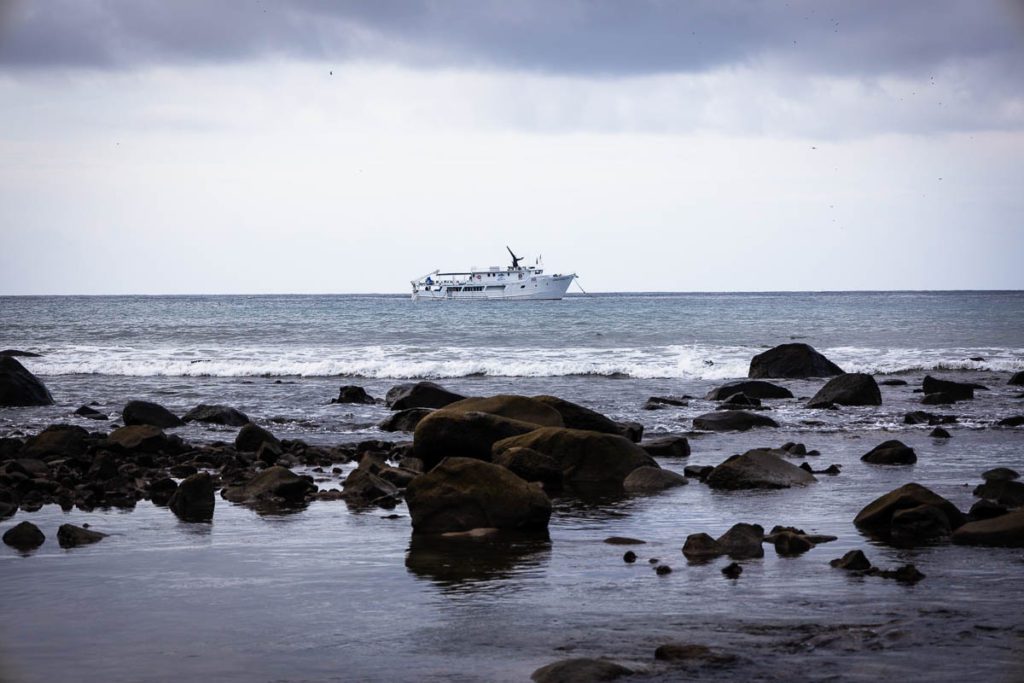
The view from the top was beautiful. We saw many birds and a few feral pigs.
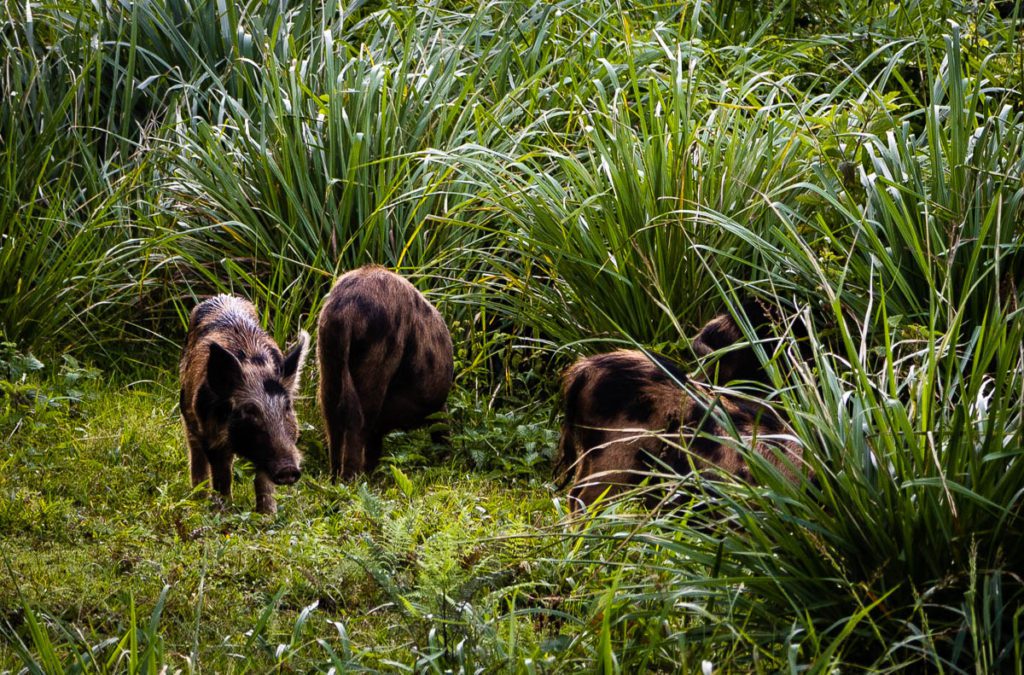
On the beach are many rock carvings from the early explorers. The oldest one dates from the 18th century, and there is even one done by Jacques Cousteau!
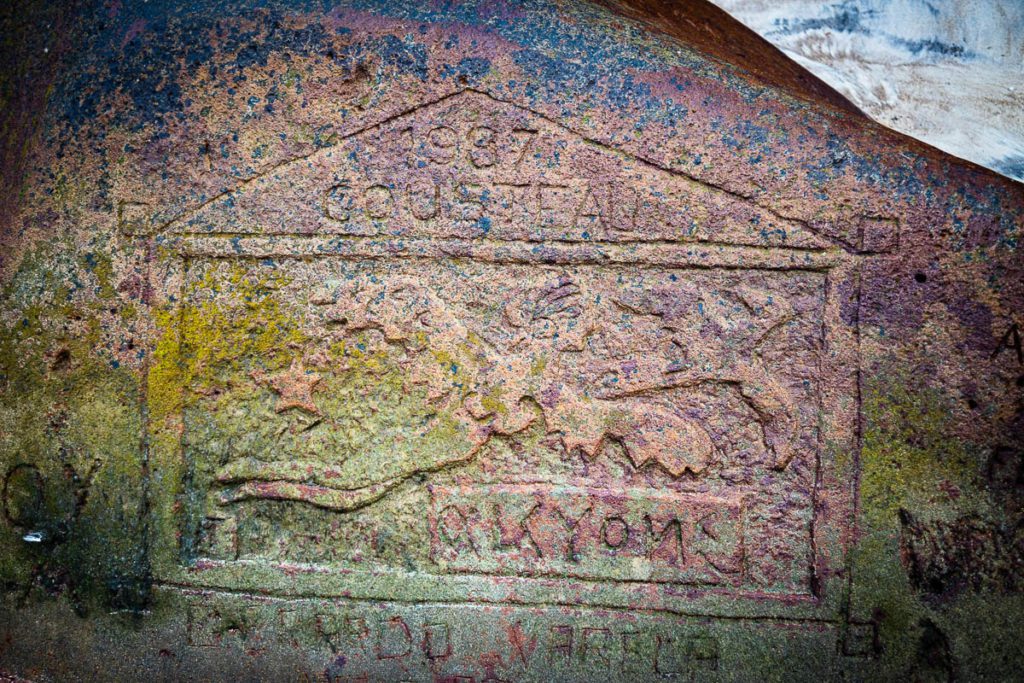
Day 4: Strong current and more hammerheads at dirty rock dive site.
Today, we got the authorization to do four dives. The boat moved to Wafer Bay at 5:45 am.
The first dive was at the Viking Rock dive site . It is a small island situated at the entrance of Wafer Bay with a steep wall. As we dove at 6:45 am, the site was still in the shade, and it wasn’t fantastic.
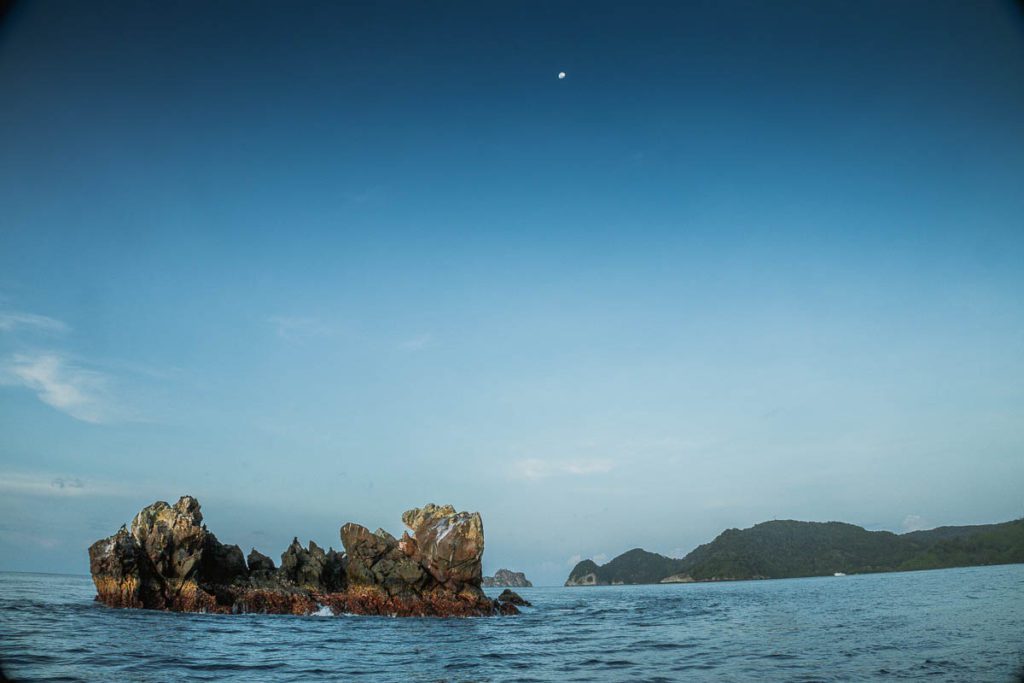
The second dive at Manuelitas dive site saw plenty of hammerhead action and was fantastic.
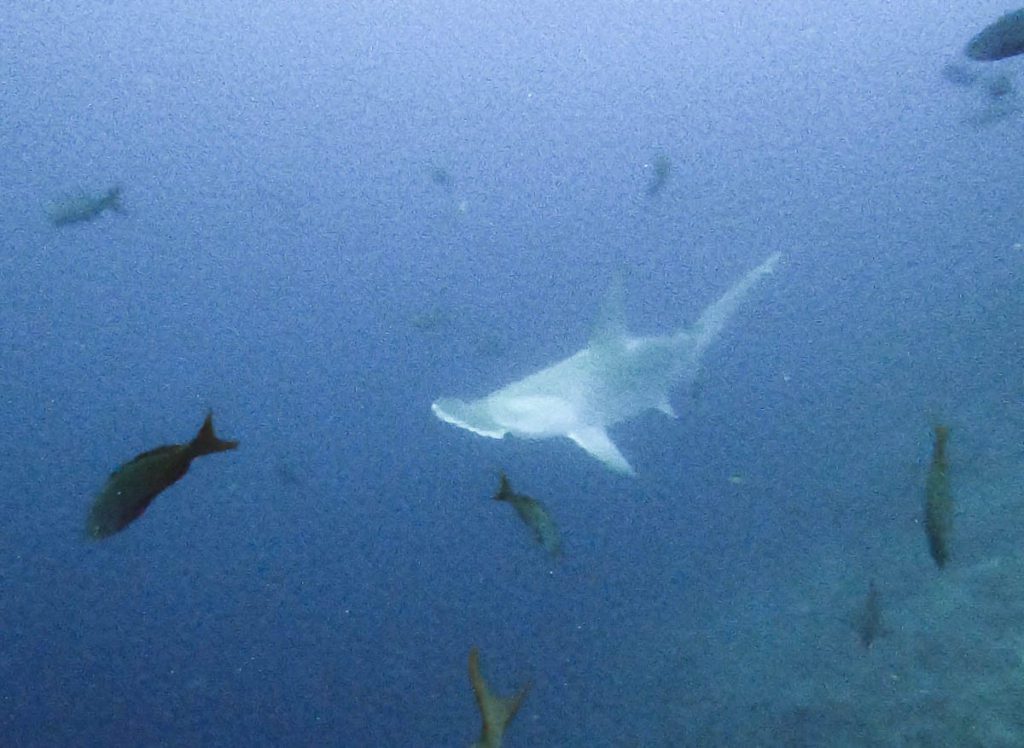
The third dive at Dirty Rock had to be aborted due to the strong current, but we would get more chances to dive Dirty Rock later in the week. The fourth dive was over a small coral reef at the Pan de Azucar dive site . This is a site where you can find frogfishes, but there was too much current today for our group to find it.
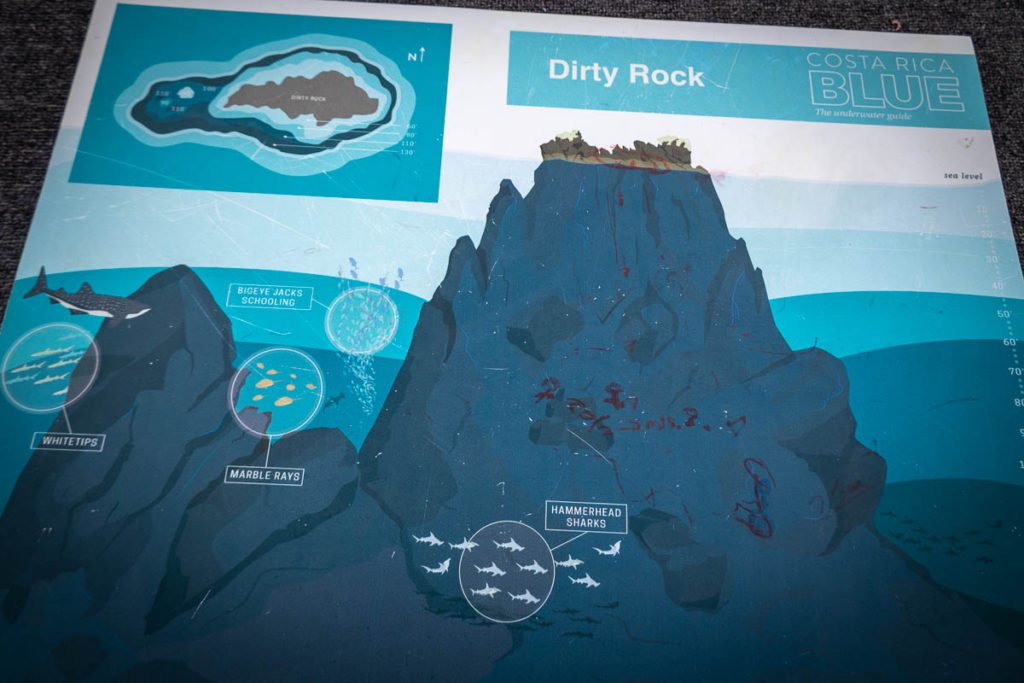
I busted my ear and had to skip the last three dives of the day. This is most divers’ worst nightmare to be unable to dive after traveling so far and being on a liveaboard. But I made the best of my time on the boat for the rest of the day by relaxing on the top deck and enjoying the view over Chatham Bay. There is always something going on when you are out at sea. You might sometimes see birds circling an area in the distance and plunging into the sea. As you get closer, you might see fishes jumping out of the water and sometimes even dolphins.
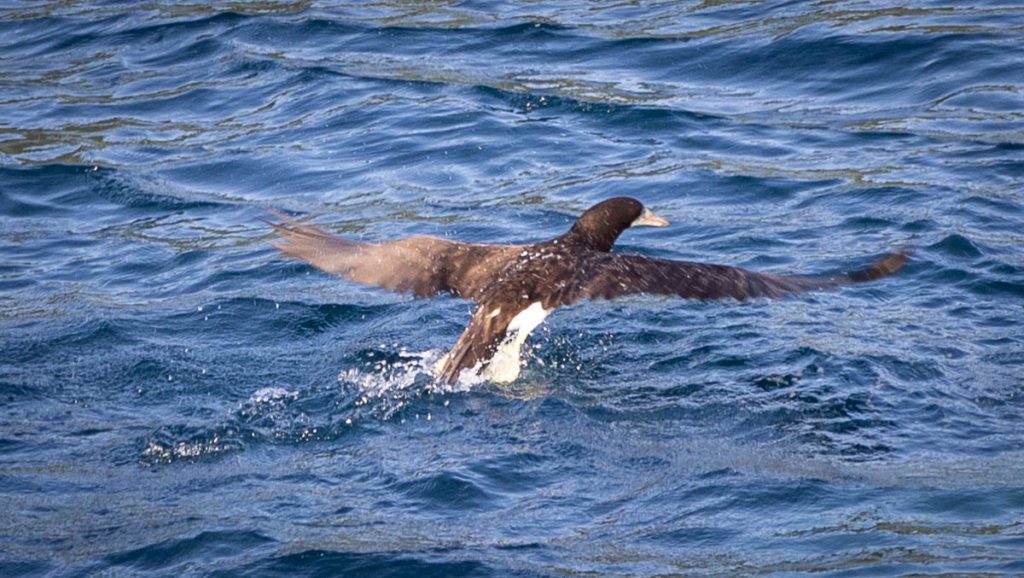
After the dives, we went on a scenic boat ride to see the sunset over Dirty Rock, took a closer look at the waterfalls, and even entered a small cave with the boat.
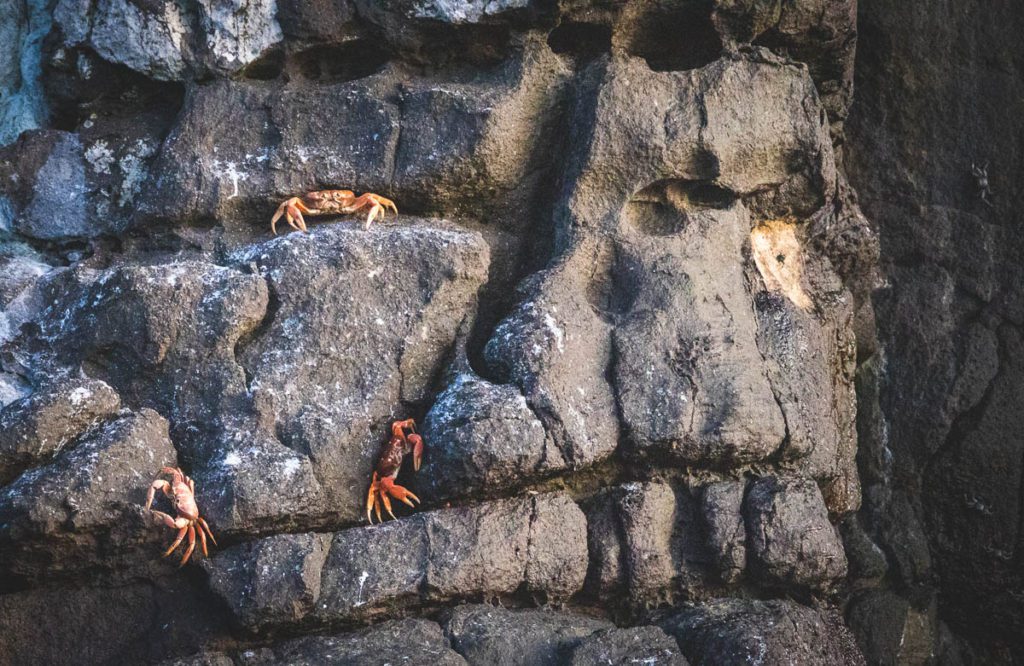
Day 5: Tiger shark action
The boat moved back to Wafer Bay in the morning. Today, we dove Alcyone , Cocos Island’s most famous dive site.
It is a group of rocks that starts about 25 meters depth and goes down to 50 meters. It is one of Cocos’ deepest sites, and it is out in the blue, attracting many large pelagics.
The current at the surface was powerful, but they have installed a line to go down, making it more manageable.
Tip: Bring gloves as the barnacles on the line are sharp. I don’t dive with gloves and had a few cuts after coming down the line.
As I came down, a Tiger shark was cruising by. He was huge! Fortunately, he didn’t come too close, and he left us before I had time to stress about it.
The line comes near the cleaning station, which is also the best spot to see sharks, which is very convenient.
The schools of fish were impressive. Fusiliers, yellow snappers, and Jacks were there en masse. Giant tuna and many hammerhead sharks made an appearance.
Whitetip sharks were also patrolling the area, but by now, we almost don’t see them anymore… this is how spoilt we have been so far with the diving and the sharks. Alcyone is considered one of the best dive sites on the planet to see hammerheads, and it is easy to see why. They are everywhere!
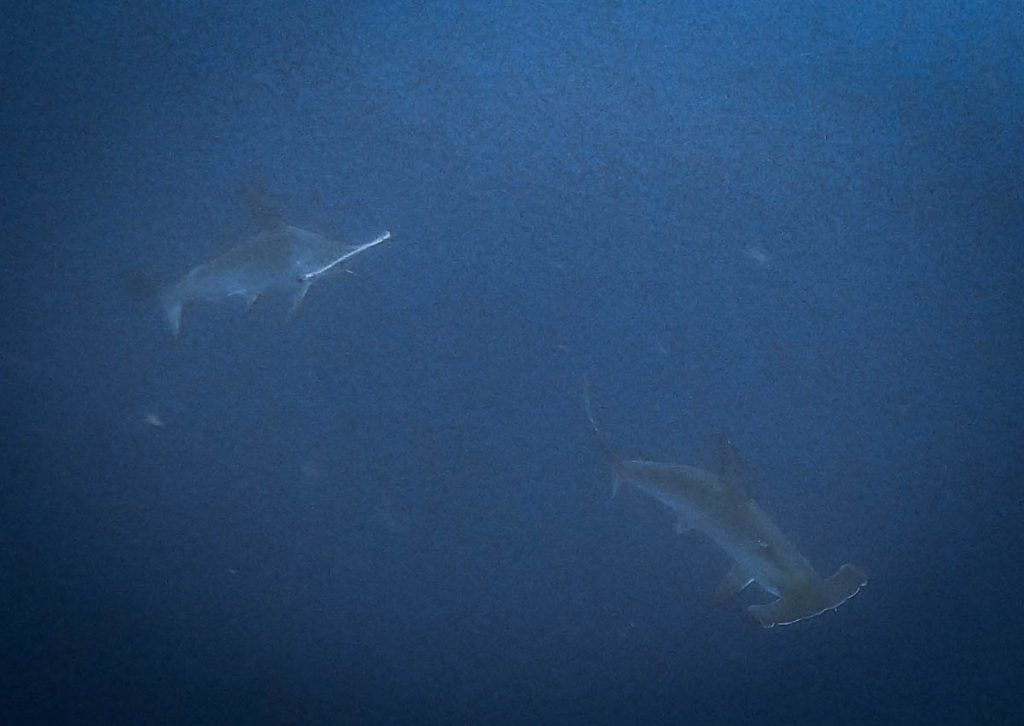
On the way up, we also saw a few salps floating in the water
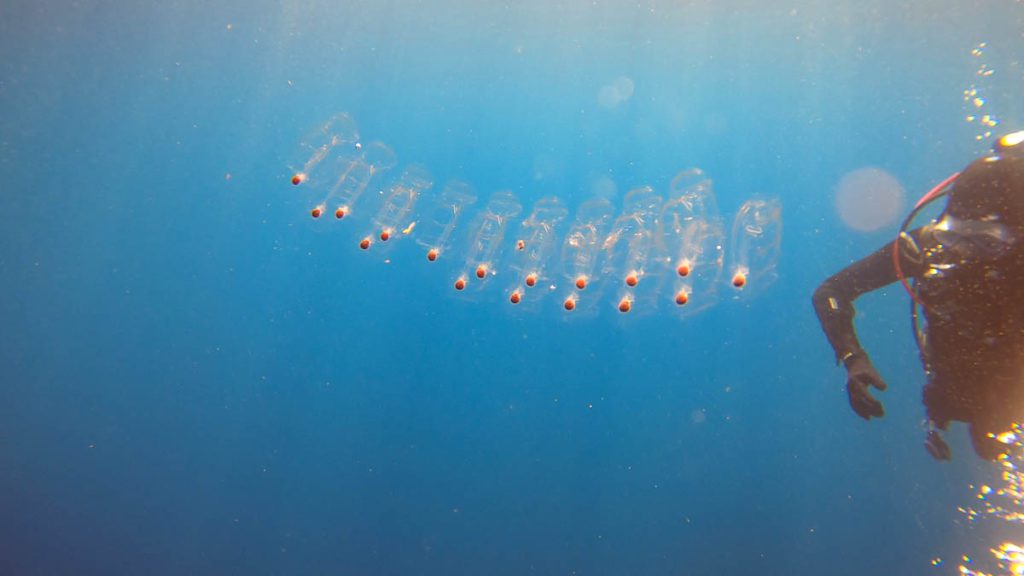
After the third dive, the captain took the boat for a sunset cruise around Cocos Island. The landscape is stunning, and the sunset was mesmerizing. All the guests mingled and enjoyed beers on the top deck. The sound of the waves and the thousands of birds hunting before sunset made it a special moment.
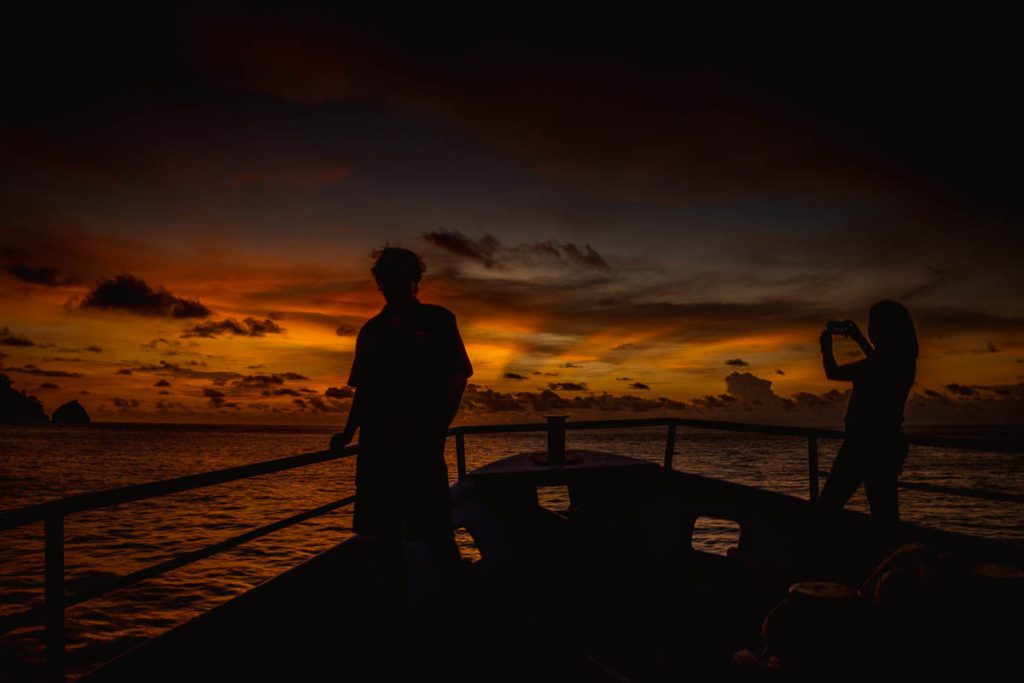
Day 6: More hammerhead actions
Today is the full moon. The day’s first dive was back at the Manuelita outside dive site for more hammerhead action. They were there in large numbers again.
We then tried our luck again at the Alcyone dive site . After yesterday’s Tiger shark and hammerheads, we were curious to see what it could bring. It is definitely one of the best dive sites in the world!
A school of thousands of Jacks closed down on us as we came down. The sea became black! In the background, 20 or 30 hammerheads were cruising by. Add the fusiliers and yellow snappers schools, and you have an absolutely magical dive!
We did the safety stop drifting in the blue and were visited by another small school of hammerheads.
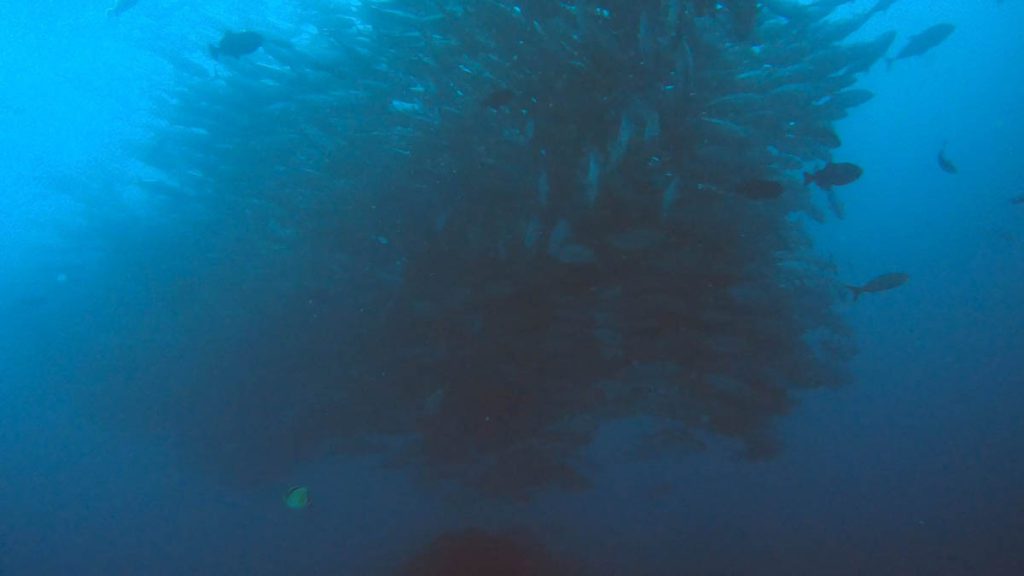
In the afternoon, we visited the ranger station in Wafer Bay. We walked over the Rio Genio bridge that has been made entirely from material confiscated from illegal fishing.
Some people chose to swim in the river Rio Genio. Three people from our boat went on a full-day hike to Cerro Iglesias. It was a strenuous hike that took them 11 hours, but the pictures they came back with were beautiful. The cloud forest looked very impressive, with trees covered by moss.
They were accompanied by a park ranger from Cocos Island.
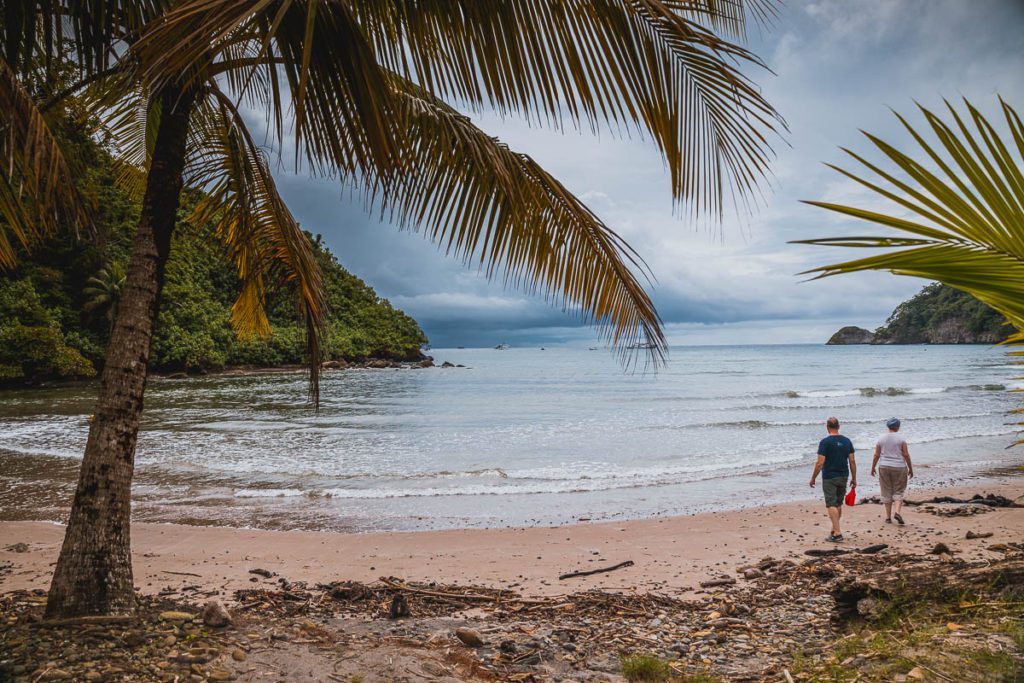
Day 7: More hammerheads
I had to stay on the boat as my ear had gotten worse, but I could still enjoy some action without getting wet.
A considerable hunt was happening around the boat with dolphins, Blue trevally, and sharks hunting fishes. The boobies and frigate birds soon joined it and were fantastic to watch.
There are 149 species of birds in Cocos, so it is an excellent place for bird lovers.
The group did their first dive at the small dos amigos dive site .
Two small islands near each other form this dive site with a channel between the two islands. It is deep as the wall goes down to 45 meters. Big pelagics often visit the cleaning station, and it is an excellent place to find the Galapagos sharks.
They tried their luck again at the Dirty Rock island dive site . It is a wall surrounding the island, and there is another submerged pinnacle to the west at around 30 meters. Many hammerheads cruise by. The wall is made of dramatic stones, some of which have pretty coral.
We then went for a hike to the waterfall. You have to walk through a small river for about 20 minutes. It is very slippery but worth the effort as you can swim at the bottom of the waterfall while enjoying the view.
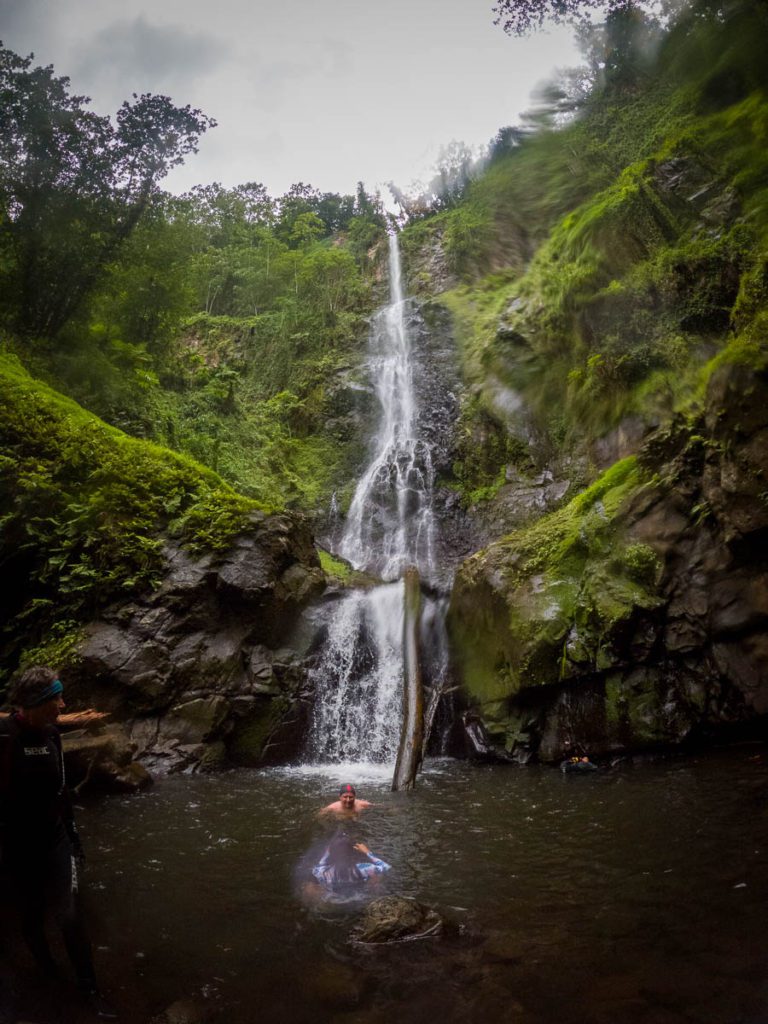
For dinner, the chef made a beautiful display with sushi! They tasted as good as they looked.
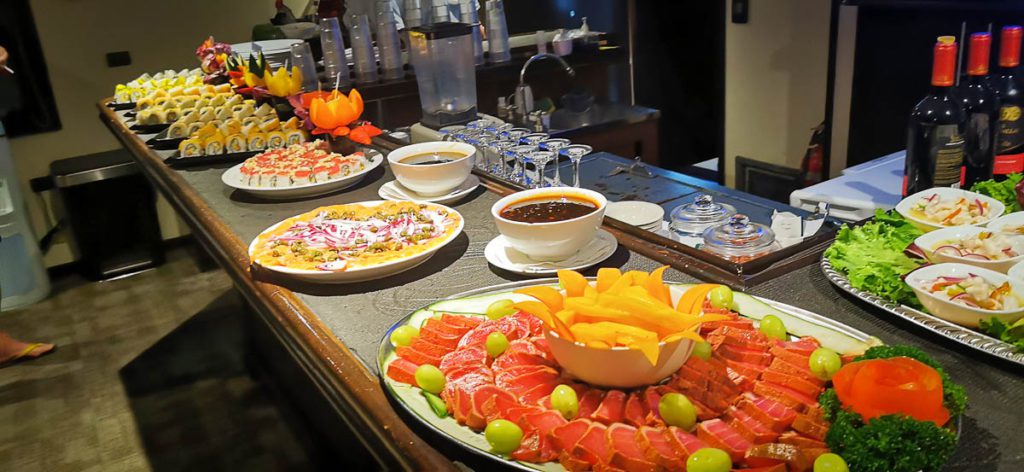
Day 8: Shark galore and dolphins!
Today was a rainy day, but it didn’t prevent us from having amazing dives!
Our day started well at the Manuelitas deep dive site . The site was teeming with hammerheads. They were absolutely everywhere and appeared through the whole dive. Some in small groups, some in groups of 20. Two of them came very close to me, so close I could see their teeth! What a look they gave me! Blacktip sharks were also everywhere. I now understand what it means to swim in a shark-infested sea! We also got to swim with a huge school of Jacks.
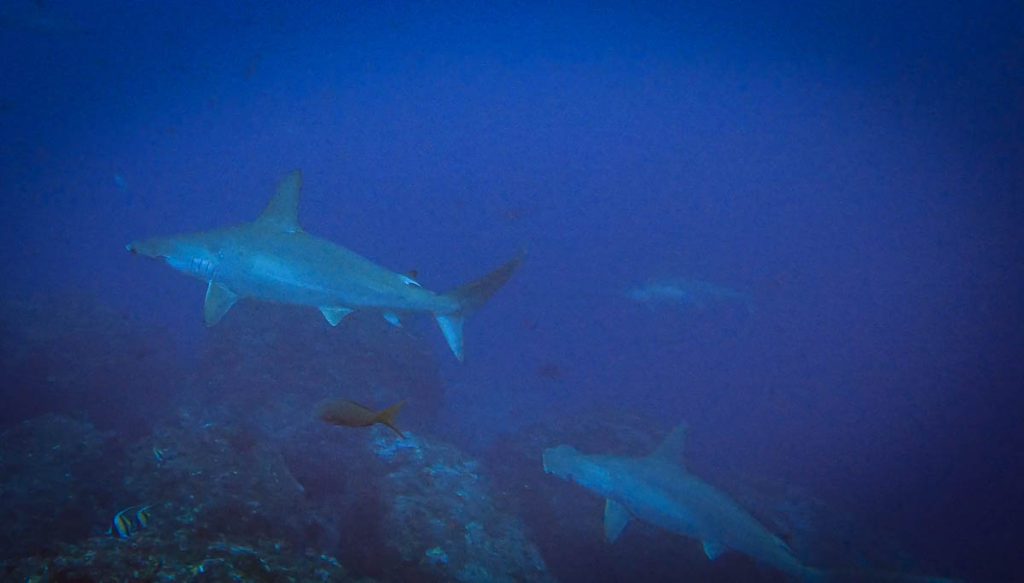
The second dive was at the Punta Maria dive site , the western tip of Cocos Island.
It is a submerged rock that starts at around 20 meters. There is a canyon and then another long pinnacle. You go down with a line. The current was mild, but the site was teeming with life. The usual hammerheads were around, but we found many different sharks here. A silvertip shark was inquisitive and kept circling around and getting close to us.
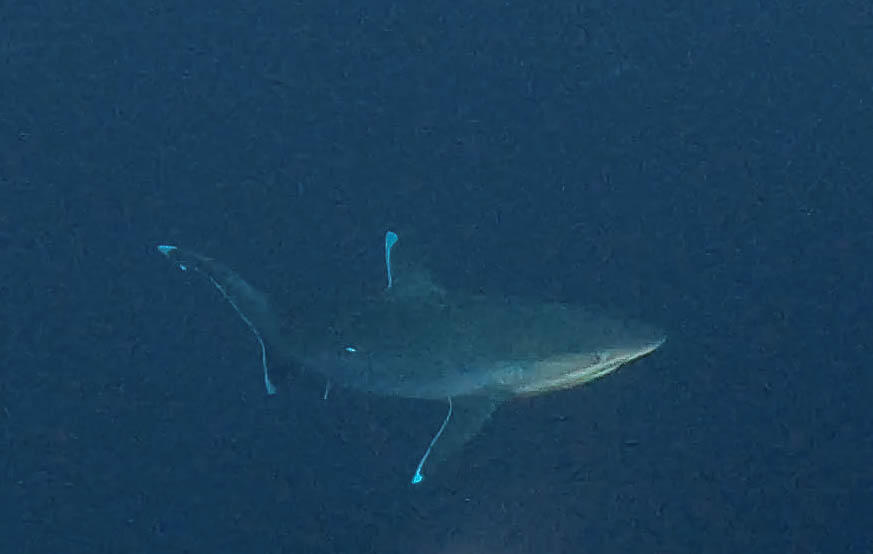
The third dive was at Dirty Rock dive sites . It also didn’t disappoint. There was minimal current, so we could go around the whole island. We saw three eagle rays floating majestically. Plenty of hammerheads and the biggest school of Jacks ever. Thousands of them turned the sea black. We finished the dive in the blue and were at one point surrounded by over 30 hammerheads.
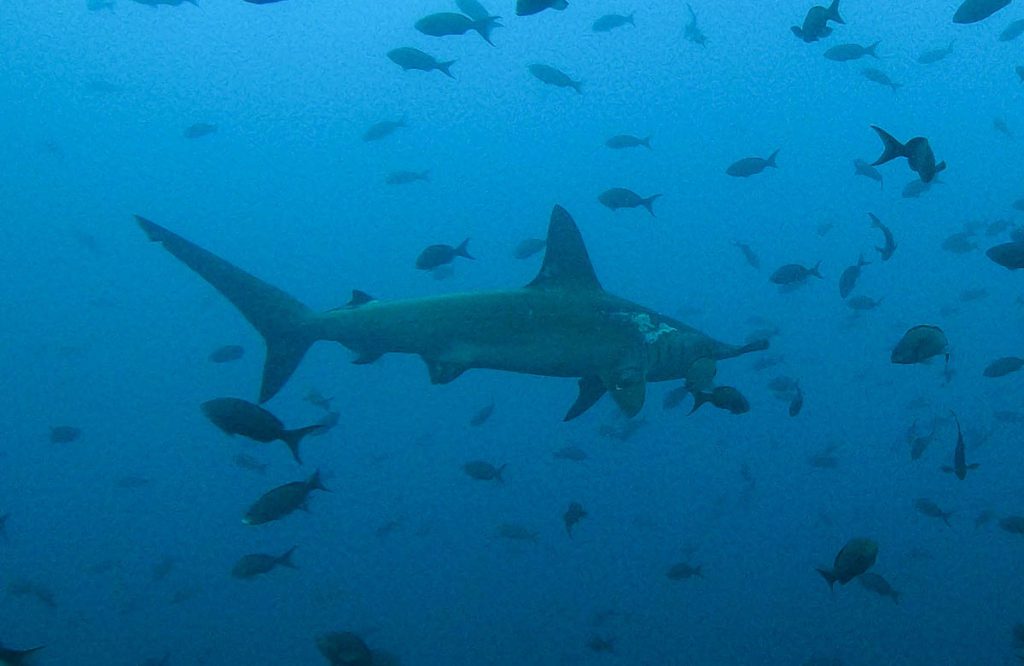
The fourth dive was a t Chatham Bay and was memorable for the large mobula cruising by towards the end of the dive.
What a diving day this had been! It almost didn’t matter that it had been raining most of the day and that the visibility wasn’t great.
The evening program was a beach barbecue, but the torrential rain forced us to have it indoors. The meat had been grilled on the top deck, so it still felt like a barbecue.
Day 8: Last day of diving. Big waves and more rain.
It was still raining when we woke up, but it didn’t prevent us from having a great last day of diving.
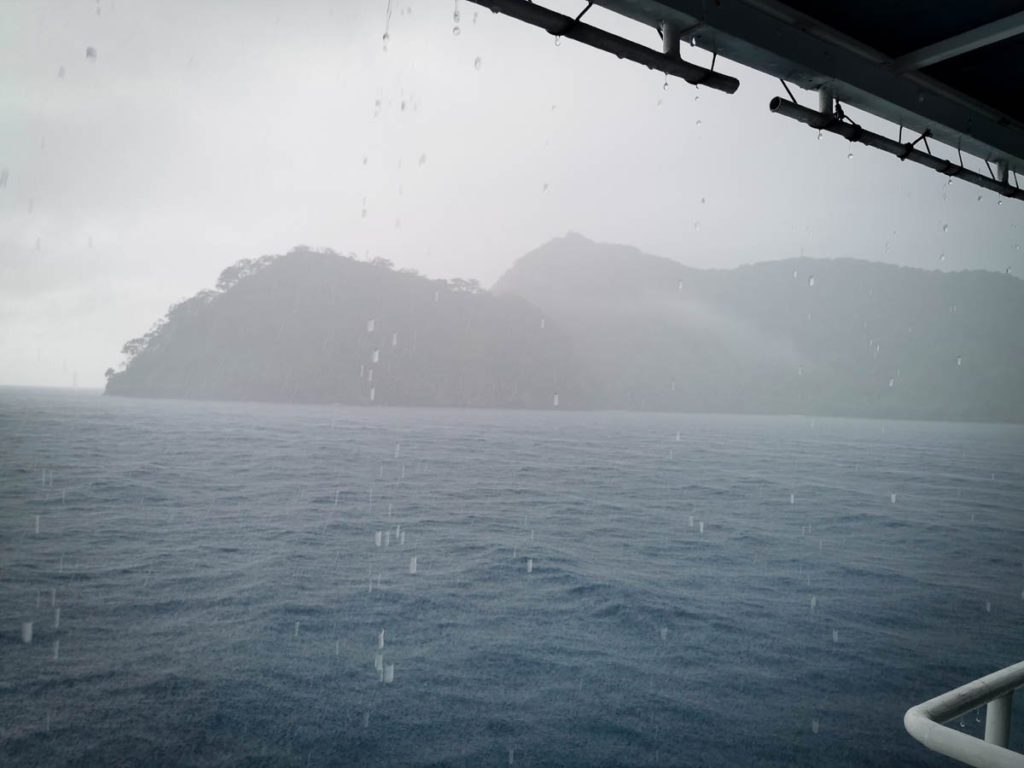
The first dive was at the Small Dos Amigos dive site . Dos Amigos are two small round islands on the western side of Cocos.
It was a 30-minute adrenaline-filled ride on the panga to navigate through the large waves.
Small Dos Amigos is the most exposed island, while Big Dos Amigos is closer to the main island. Big Dos Amigos is famous for its underwater arch made of stones. Small Dos Amigos has more wildlife.
The current was strong and the visibility bad. But it was worthwhile as 10 -15 Galapagos sharks were swimming at about 30 meters depth.
To illustrate how good Cocos is to see hammerheads, this was the only dive in Cocos where we didn’t see a hammerhead shark!
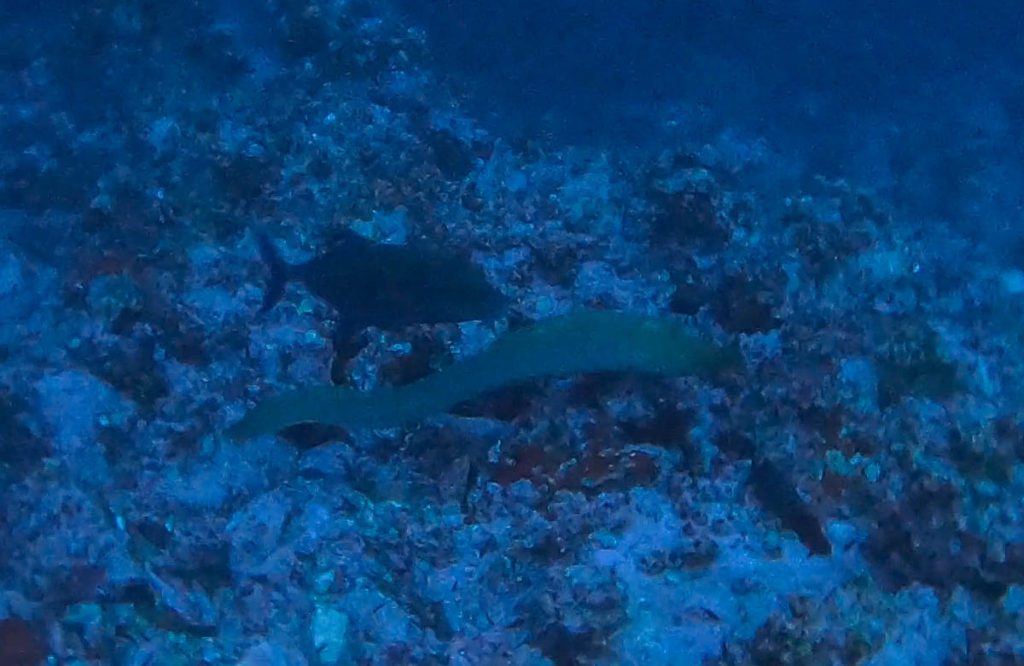
Our second dive was back at the Dirty Rock dive site . We were initially going to dive Big Dos Amigos, but the large waves and distance from the boat made us reconsider, and choosing a dive site nearer Dirty Rock once again didn’t disappoint. While the visibility wasn’t great, it was full of hammerheads.
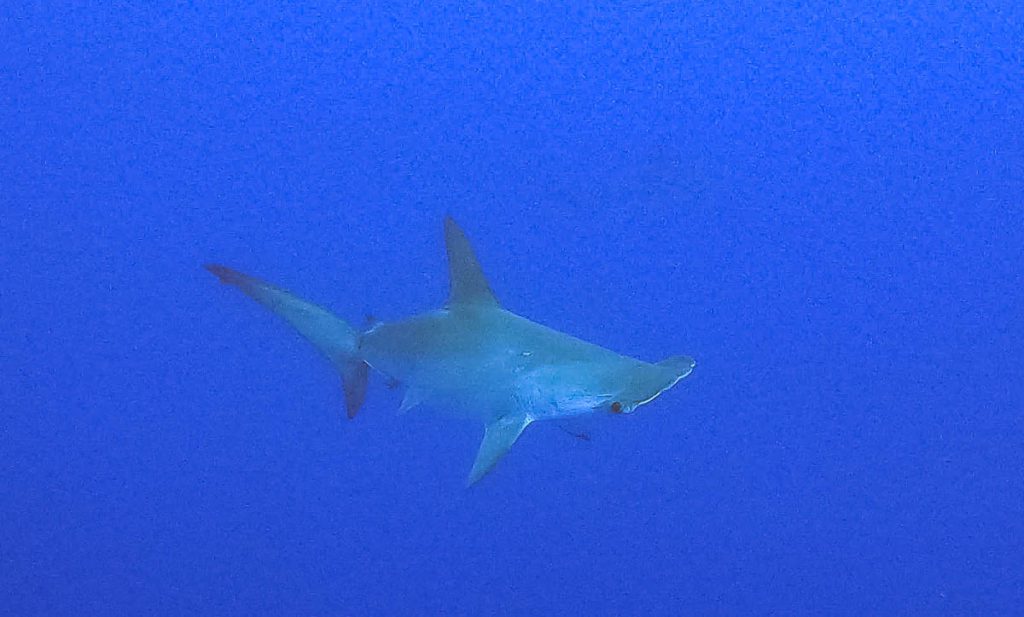
The last dive of the trip was back at the Manuelita deep dive site . The current was also powerful, and the hammerheads were there en masse.
We said our goodbyes to Cocos around 4 pm as we started our 30-hour journey back to Puntarenas.
Day 9: Cruising back to the mainland
Today was a lazy day as we would be on the boat the whole day. Fortunately, the rain had stopped, and we could enjoy the top deck in the sun.
The crew had been doing a movie during the whole trip, and they premiered it in the afternoon.
It was followed by a small party to honor the “iron divers.” Aggressor liveaboards have this tradition that everyone who does all the dives during the trip gets a medal.
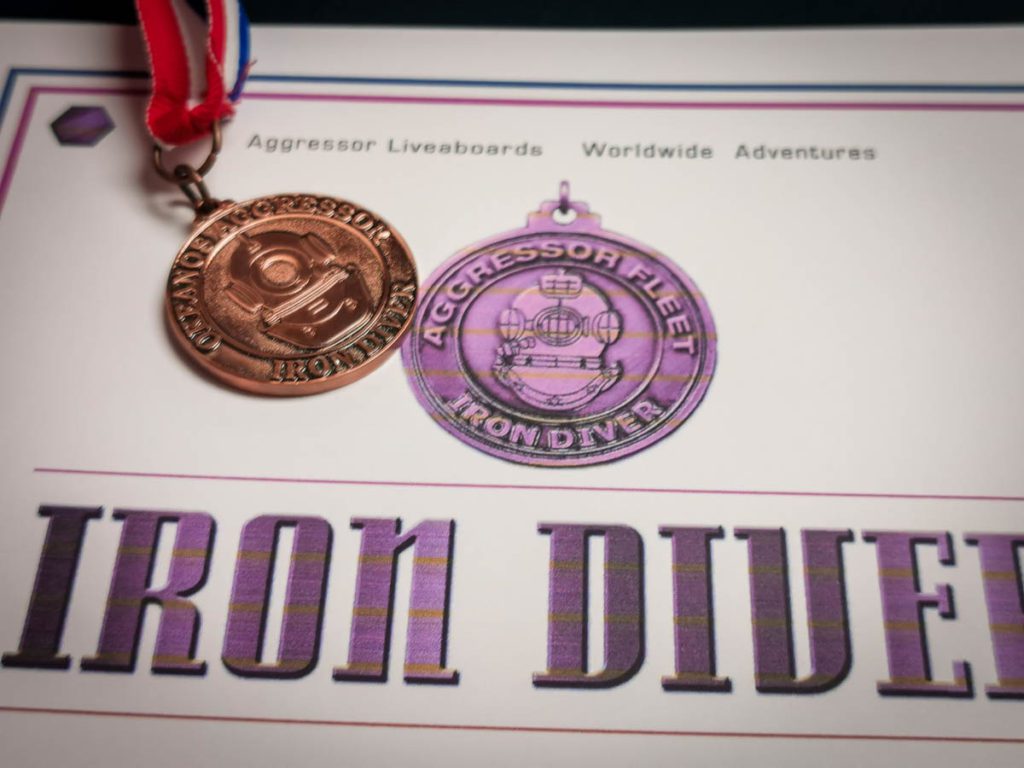
Day 10: Early arrival to Puntarenas and transfer to San Jose.
We arrived in Puntarenas around 4 am and were ready to disembark about 8 am after the last breakfast on board. The Aggressor bus took us back to the airport (or the hotel for people staying a few more days in Costa Rica). I had a 1 pm flight and was too early for the check-in, so I went to wait in the upstairs restaurant in the arrival hall.
Tip: If you need to do an antigen test for your flight, there is a testing center near the airport where the bus can drop you off.
The passengers on the Okeanos Aggressor
There were 18 passengers. Ages ranged from 24 years old to 73 years old!. Most passengers were from Europe and North America.
Most passengers also tended to be well-traveled and good divers with a minimum of about 100 dives. The atmosphere on the boat was incredibly friendly.
Review of the diving organization on the Okeanos aggressor
Cocos national park and aggressors diving rules.
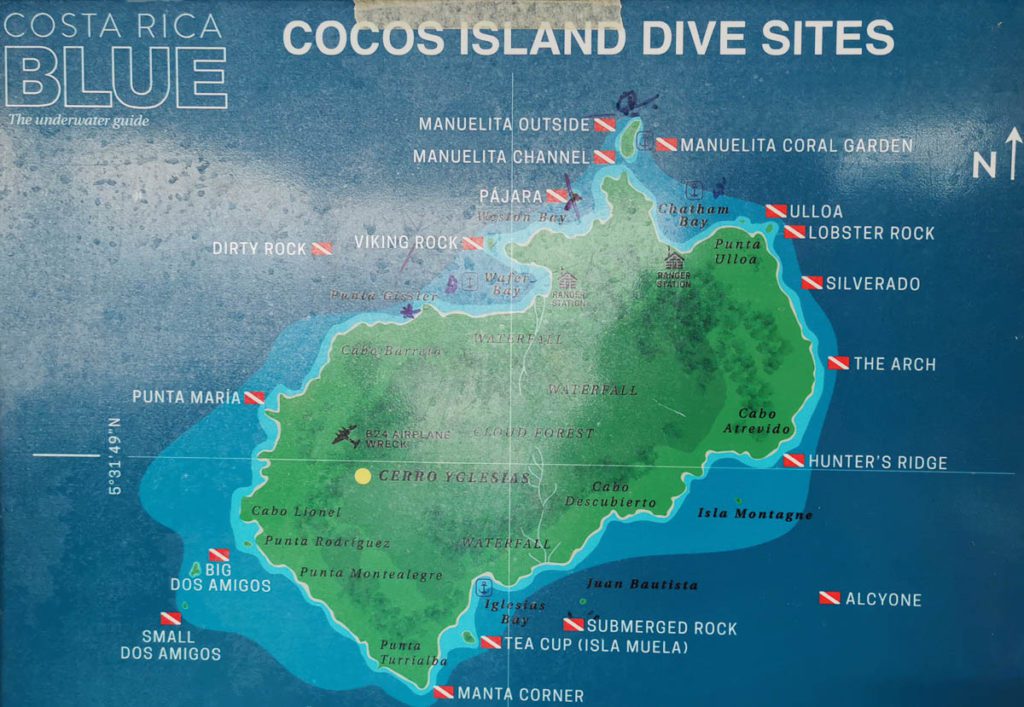
As Cocos Island is a marine conservation area and national park, specific rules must be observed while diving here.
The most important one for divers is that night dives are not allowed anymore. So boats usually offer three dives a day, which might seem little for hardcore divers who have been on other liveaboards that dive four or five times a day. Dive time is 8 am, 11 am, and 3 pm.
The Okeanos was good in offering two extra early morning dives, so we got two days with four dives a day.
The Cocos marine park fee is 560 USD, and this has to be paid on board. It is one of the highest marine park fees I have seen. But you pay for exclusivity as only 60 divers are allowed in Cocos Island at any time, so it never feels crowded.
Tip: Having a dive computer is mandatory, so make sure you bring one.
The maximum depth is 35 meters, and the maximum bottom time is 55 minutes. It was usually enough as the dives are deep, and we would usually run out of air or bottom time by then.
Solo diving is not allowed, and neither is decompression diving.
Blue water diving is not recommended as the currents can be dangerous, but we would sometimes do the safety stop in the blue.
For safety, the Aggressor Okeanos provides nautilus GPS trackers to every diver. Should you drift into the ocean, they will be able to find you.
In case that’s your hobby, be aware that treasure hunting is prohibited on Cocos Island 🙂
Pangas diving
All the dives are from pangas (tender boats). We were separated into two groups of nine divers each.
The crew took care of the tanks and equipment, so we only needed to bring our mask in the panga.
The panga is well-designed and comfortable. It has a good ladder to get on and off the panga and makes diving easy. Most divers would come up with their tank on their back, but the crew could also assist you if you had difficulties with that.
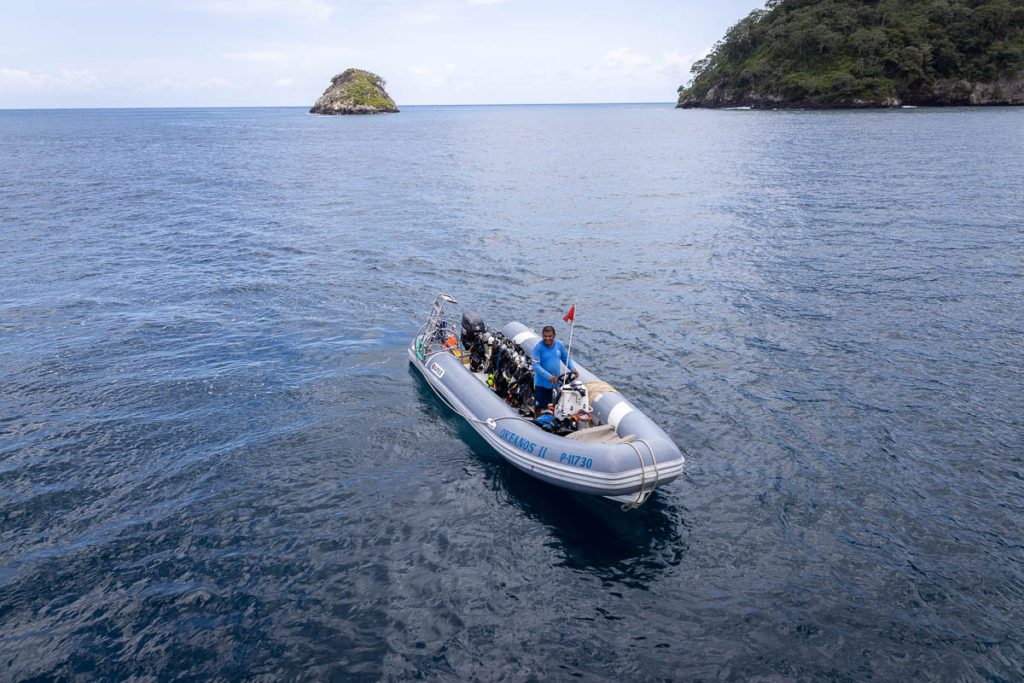
Most dives are done with negative entry backrolls, so make sure you master that before your trip to Cocos.
Tip: The current would often be strong and require intense finning. Bring some diving socks to avoid blisters.
Review of the dive deck on the Okeanos Aggressor
The dive deck is spacious and well-organized. With 18 divers, it felt spacious. You will be assigned a space at the beginning of the cruise with a storage box underneath a seat.
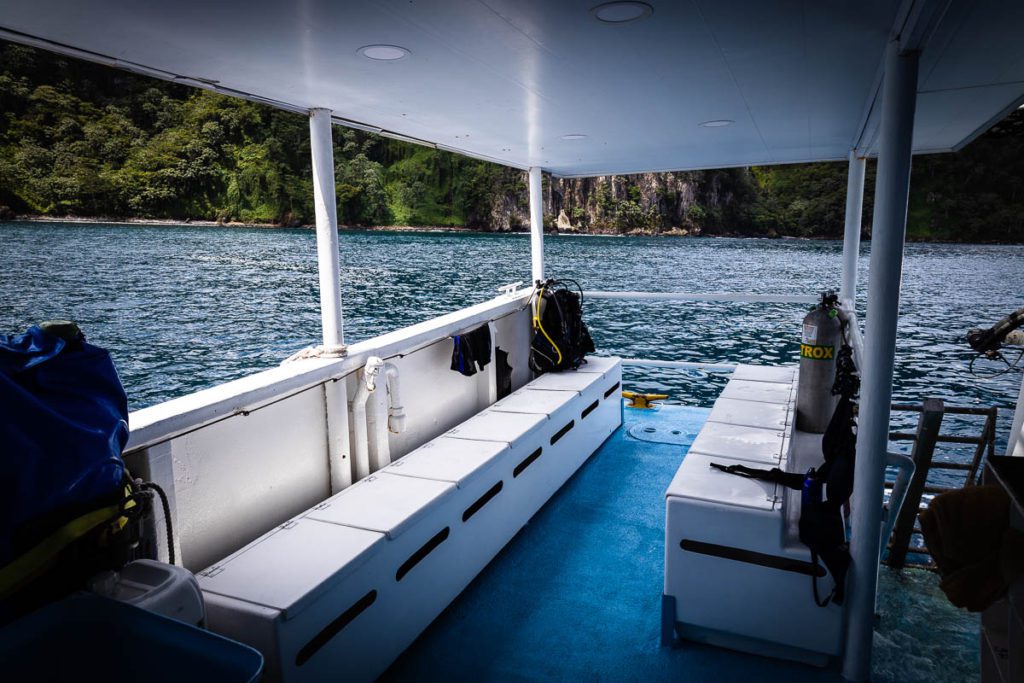
Towel service is organized. Diving towels have your cabin number on them and would be dried off for us so we would have a plush and warm towel waiting for us after every dive.
Fruits or cake are offered after every dive. After the last dive, they even provided hot chocolate that you could spice up with coffee liquor!
Dive briefing and diving groups
The dive briefings were informative. They have well-drawled maps of each dive site.
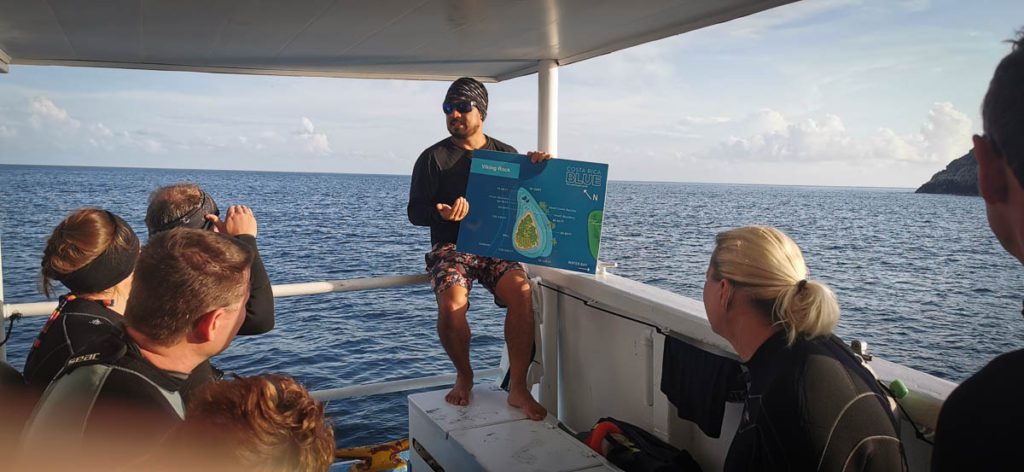
We were split into two groups of nine divers, which might sound large. But they were clever to have the two groups diving to different dive sites simultaneously so that it never felt crowded underwater.
Aggressor liveaboards are famous for allowing divers to dive independently in buddy teams. In most dives in Cocos, all the divers choose to stay with the group. Maybe the strong currents or the considerable number of sharks made people feel more comfortable in groups. Most divers in my group were quite advanced, so they spread out, and the group size didn’t feel too big.
Water temperature when diving in Cocos island
I was there in April, the end of the dry season. The water temperature was 28 or 29 degrees. We encountered a few thermoclines, and the water temperature would go down to 21 degrees for a short time.
Tip: Bring a 3mm or 5 mm wetsuit.
When to dive Cocos Island?
Cocos Island has a wet and a dry season as you can see on the chart below.
We did the trip in April which is the beginning of the rainy season and we experienced a lot of rain during the trip.
There is no bad time to dive Cocos Island as the fishes and hammerheads seem to be always there. However, the rain and stormy weather would often reduce visibility underwater.
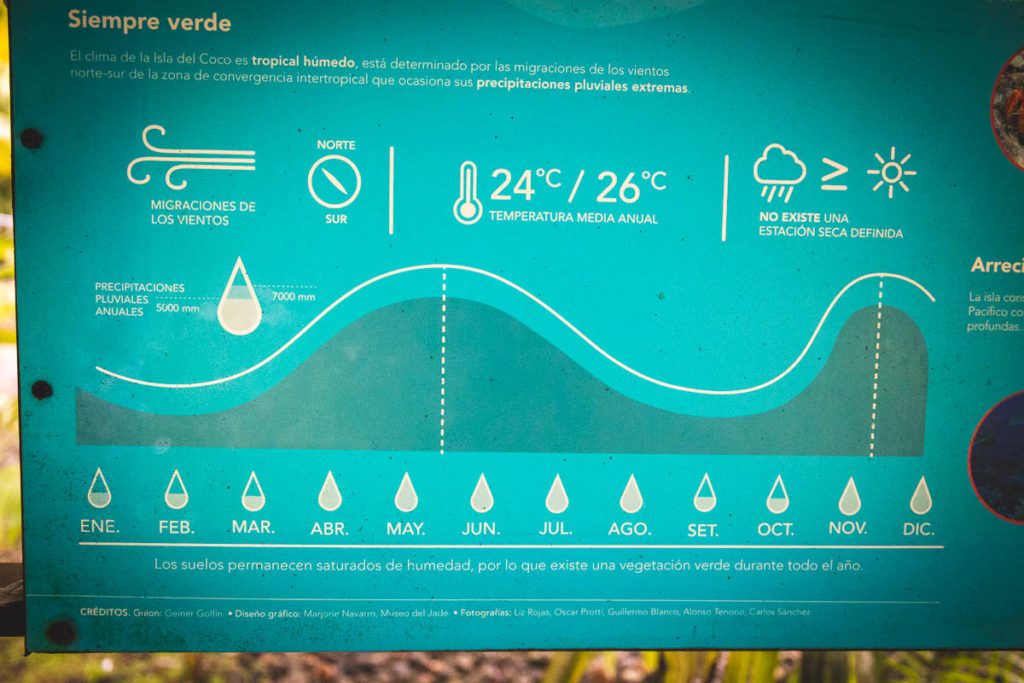
Is diving the Cocos Island good for beginners or snorkelers?
There are so many sharks everywhere that I would not recommend snorkeling in Cocos island.
The current can be strong, and most of the dives are negative entry, so I would recommend it for experienced divers only.
it is however one of the most rewarding dive destinations for sharks and large schools of fish so it is definitely worth the extra efforts
Furthermore, controlling your buoyancy and staying calm underwater is critical when encountering potentially dangerous sharks.
Do you need Nitrox on a diving trip to Cocos?
Most dives in Cocos are between 20 and 35 meters, so using NitroxNitrox will give you significantly more bottom time. I, therefore, recommend it on this trip. It is available for 150 USD for the trip. If you are not Nitrox certified, they offer the course onboard for a fee, and you can do it on the first day.
Review of the Okeanos 2 liveaboard.
The Okeanos 2 will not win any beauty prizes, but it is an extremely well_built boat. In order to dive Cocos Island, it needs to travel 500 kilometers and be able to withstand rough seas. It is a tough and compact boat. I think it might be one of the liveaboards that navigates the longest for a diving cruise on a regular basis. It is easy to navigate with easy stairs and lots of handles. You can see that the boat is well-designed.
We were 18 passengers during the cruise, and the boat never felt crowded.
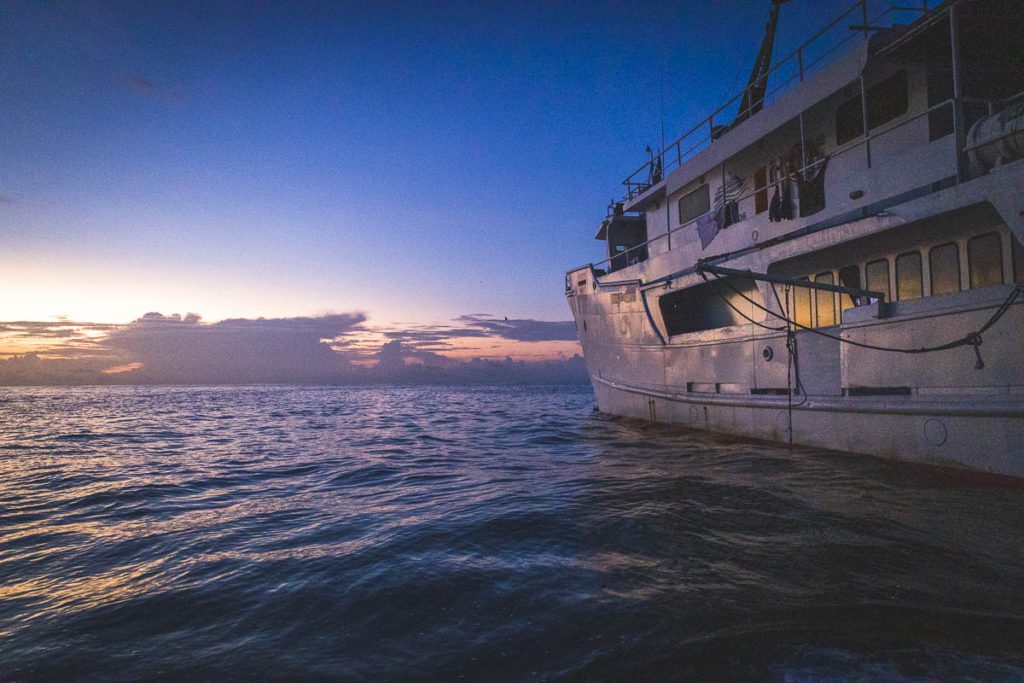
The main deck has an open-air dive deck at the back. The dive deck is spacious and well-organized. They have a whiteboard there to do the dive briefing and a tank to rinse cameras.
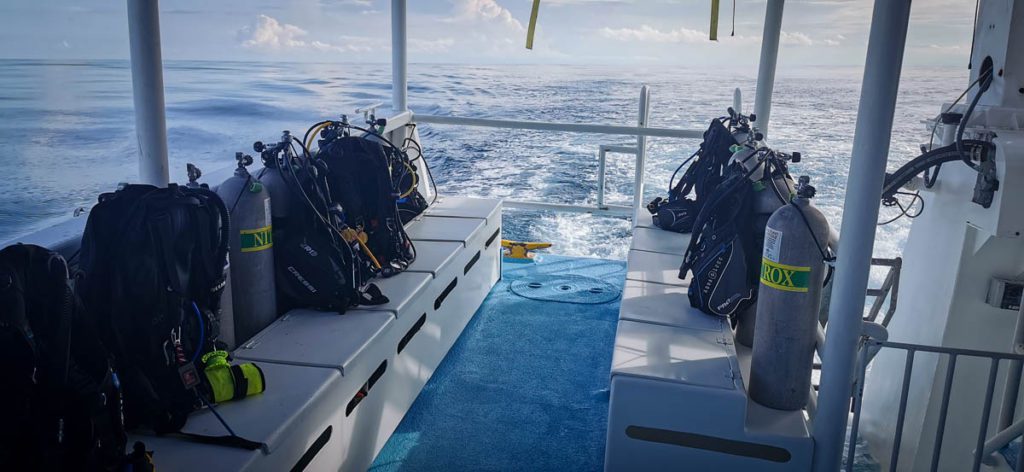
The tenders are right nearby and are easy to board from both sides of the boat.
The restaurant is also located on the main deck. It is a large airconditioned room with four tables, a bar area, and a lounging area with a few sofas. The large panoramic windows overlooking the sea make it a pleasant room, and it was never crowded.
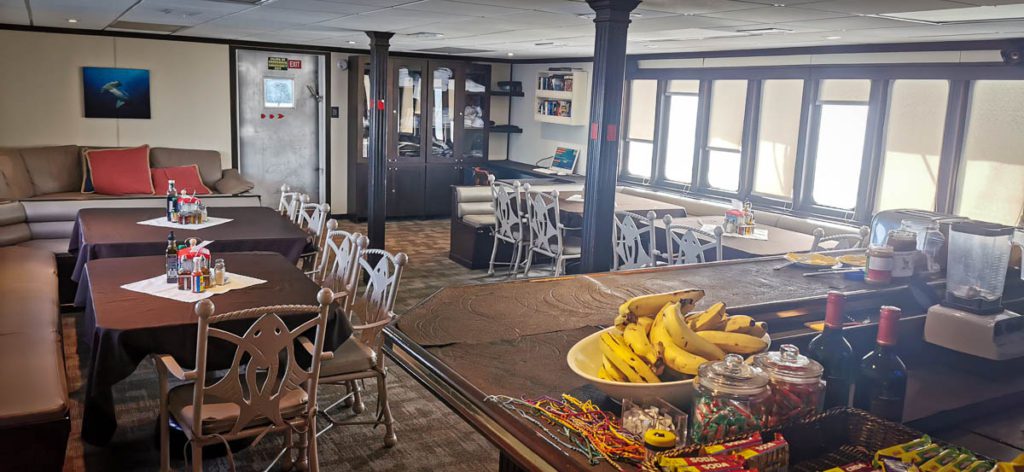
The top deck has an outdoor area with three tables and a few lounge beds to relax. This area is covered and protected from the sun and was my favorite area on the boat to relax in between dives. A fridge with beverages is on this deck, so you don’t need to go down to the main deck to get the sunset beers.
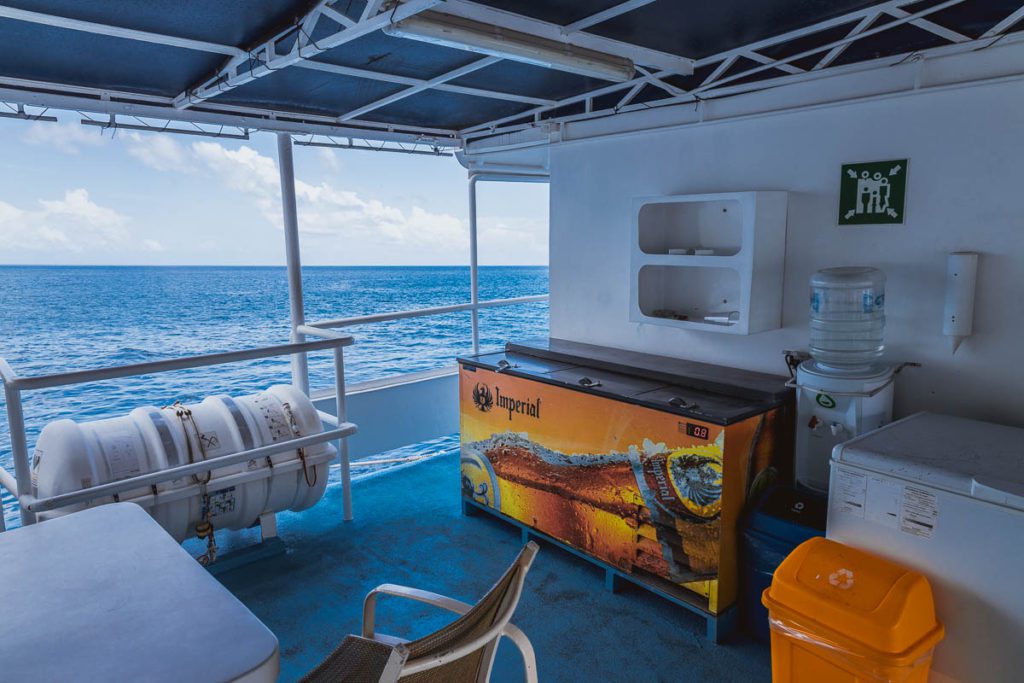
Most passengers would congregate here for sunset drinks, and it was very convivial.
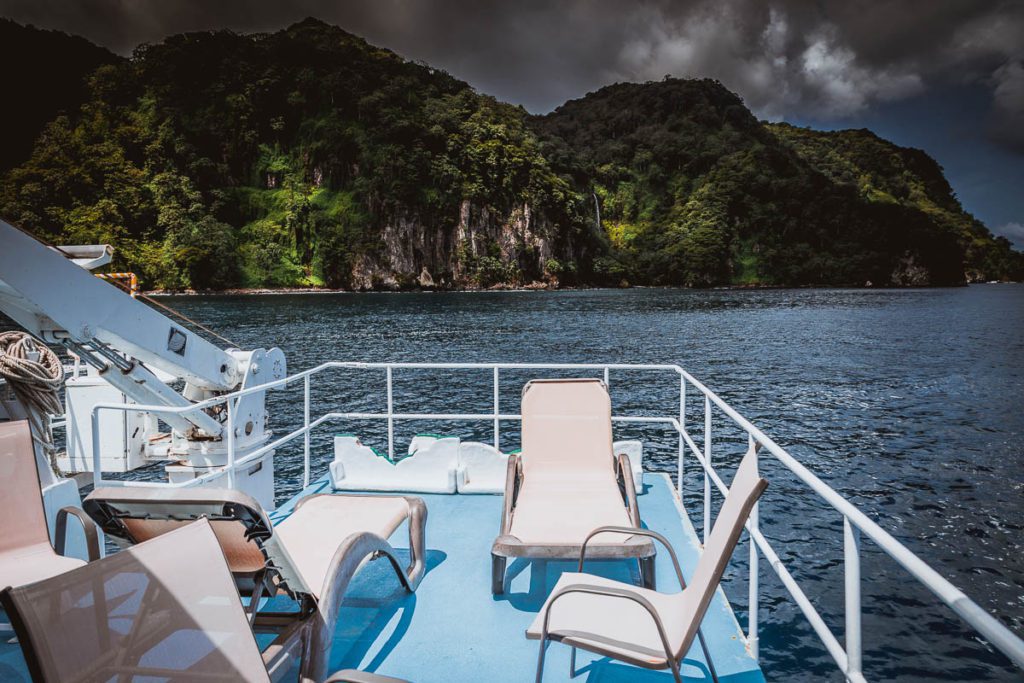
On the top deck are two suites cabins, the captain’s steering room, and a front terrace with more chairs and lounge chairs that were also very pleasant when the sun was coming down.
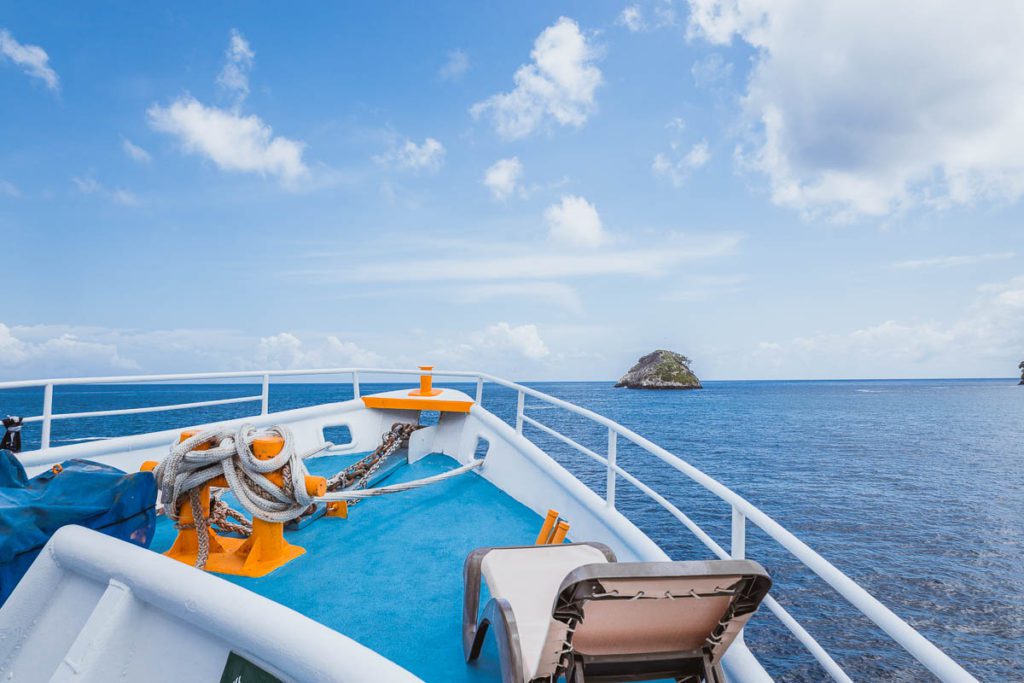
The below deck has eight deluxe cabins.
We were 18 passengers during the cruise, and the boat never felt crowded. It is easy to navigate with easy stairs and lots of handles. You can see that the boat is well-designed.
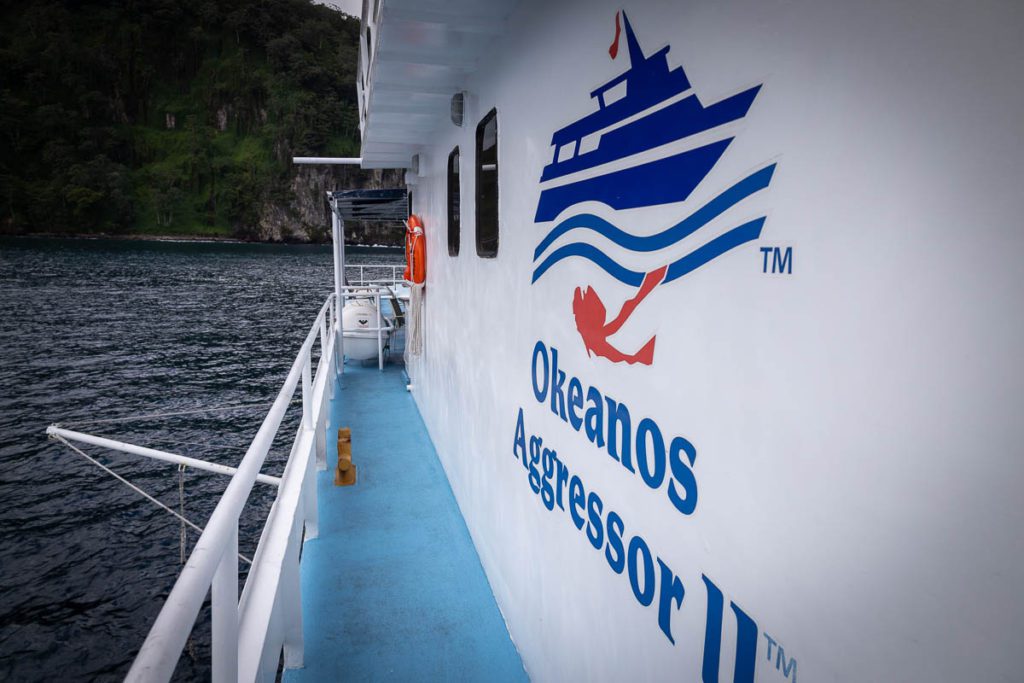
Review of the cabins on the Okeanos 2 liveaboard
The bedroom.
The cabins are not the strong point of the Okeanos 2 Cocos Aggressor. I stayed in a deluxe cabin (which is the lowest level on the Okeanos 2). The cabins are small with a bunk bed. That being said, they felt bigger in real life than in the pictures. They were also more comfortable than I expected.
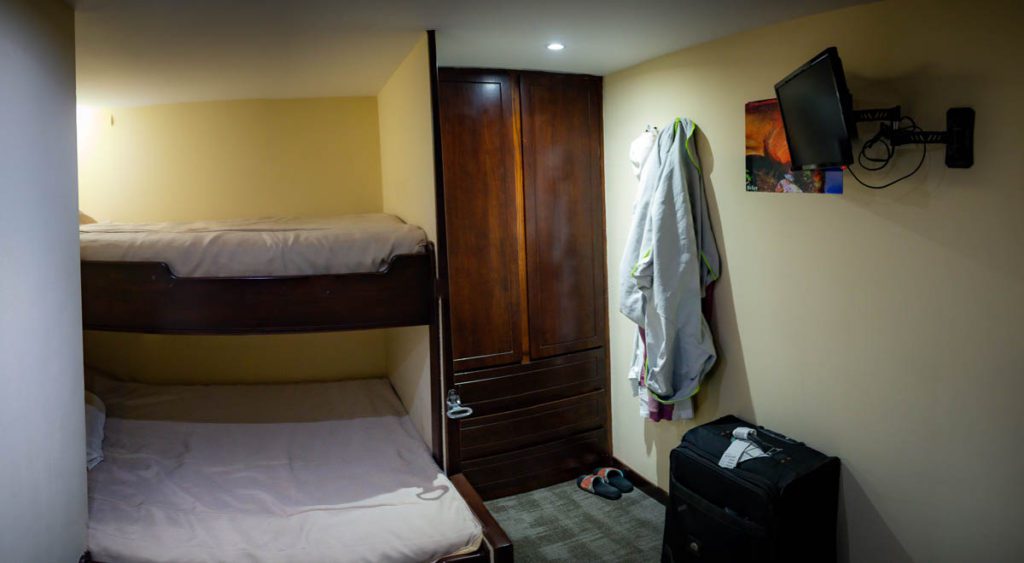
The beds are comfortable, and there is plenty of storage room with a large double cupboard and more storage under and above the sink. There is a TV in the room, and you can download movies to watch from the dining room computer.
Tip: The room air-conditioning is not individually adjustable. Our room was too cold for my taste, so I used my extra sleeping bag. Bring an extra blanket or sleeping bag if you get cold quickly.
Two bathrobes are provided to wear in between dives.

Review of the bathroom
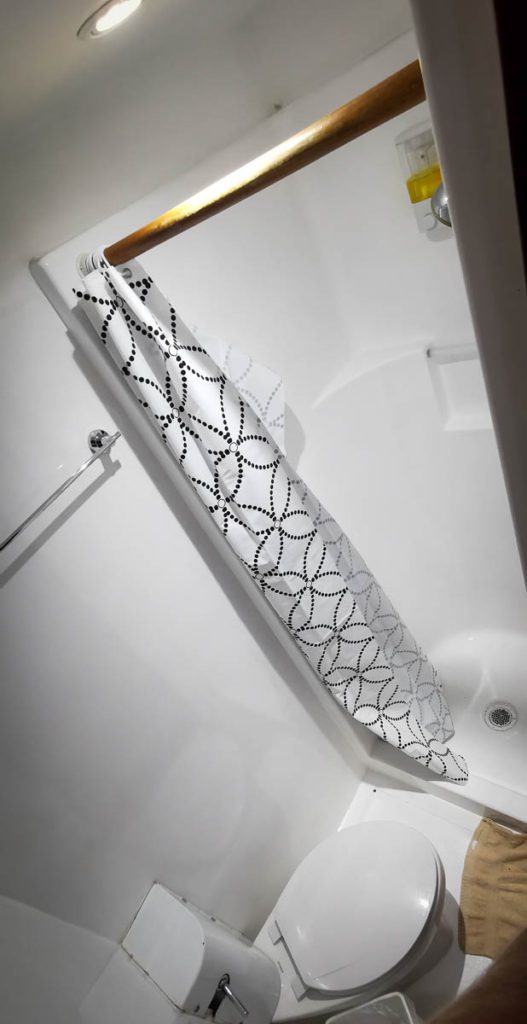
Tip: If you want more space or don’t like bunk beds, book one of the three suites on the boat. They are much better than the cabins below deck, but they get booked up quickly, so make sure you book early.
Review of Crew on the Cocos Okeanos Aggressor.
The crew on board the Okeanos Aggressor is fantastic. Only nine people work for a boat that can host 22 guests, but don’t let that fool you. The service is top-notch.
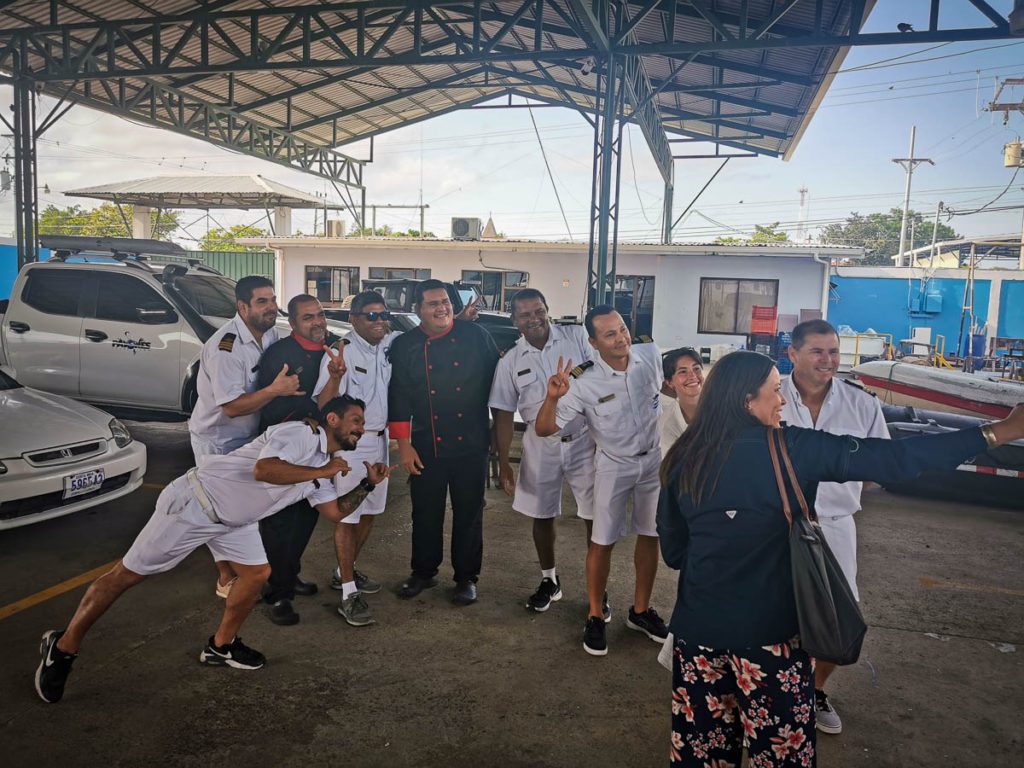
The captain, Carlos, also acts as a divemaster and is a remarkable person. He is always smiling and is full of positive energy. His good spirits reflect on the rest of the team. It is hard to find a harder working team that always has a smile on their faces.
The dive guides, Carlos and Faicundo, are attentive and know the dive sites well.
The panga drivers are conscientious. I had to abort a dive and came back on the panga earlier. The driver followed the diver’s bubbles during the whole dive and was ready to intervene in an emergency at any time.
Service onboard is also excellent. The waiter is proactive and efficient. The boat is kept incredibly clean, and the drink fridges are always full 🙂 The cook prepared delicious meals.
Aggressor liveaboards are well-known for their outstanding service, and the Okeanos 2 team even exceeded expectations.
Review of the food on the Okeanos Aggressor 2.
Aggressor liveaboards pay special attention to their food, and the Okeanos 2 didn’t disappoint. The food was plentiful, varied, and delicious.
Breakfast is served at 8 am. It is a buffet with cereals, toast, cheese, spreads, bacon, fruits, and yogurt. Eggs are also available on demand.
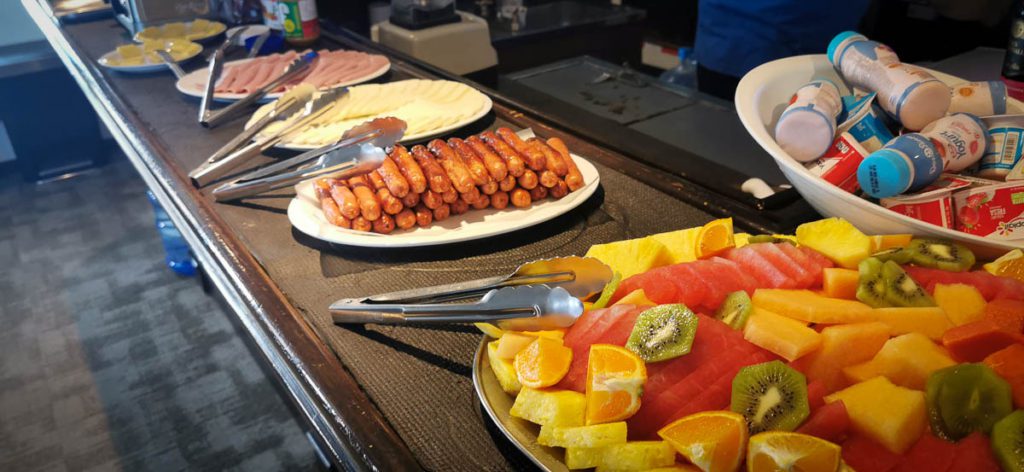
Lunch would be served at 12:30 and was buffet-style. Each day would have a theme. From Italian to Costa Rican or even sandwich day.
Healthy food lovers will appreciate the huge salad and vegetable selection on offer every day. Dessert was also available.
Dinner was a touch more formal with a tablecloth and a four-course menu. It started with a soup. Appetizers ranged from Caprese salad, heart of palm salads, or Ceviche. The main course ranged from roast beef to sweet and sour salmon with asparagus or chicken breast.
The quality of the ingredients was high, and the cook was great.
Food allergies and preferences were also accommodated. One person in the group was gluten-free, and they prepared special food for her every day.
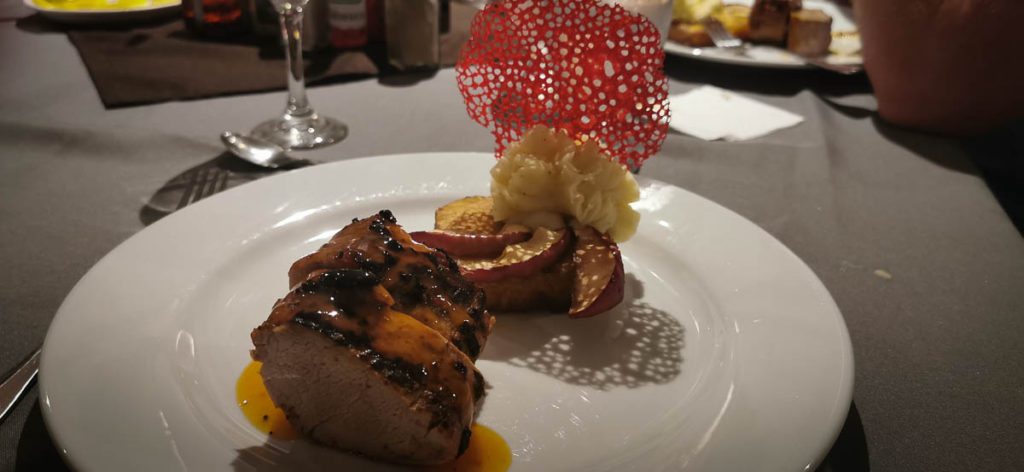
Special mention for the sushi night. The sushi and sashimi were beautifully presented and delicious.
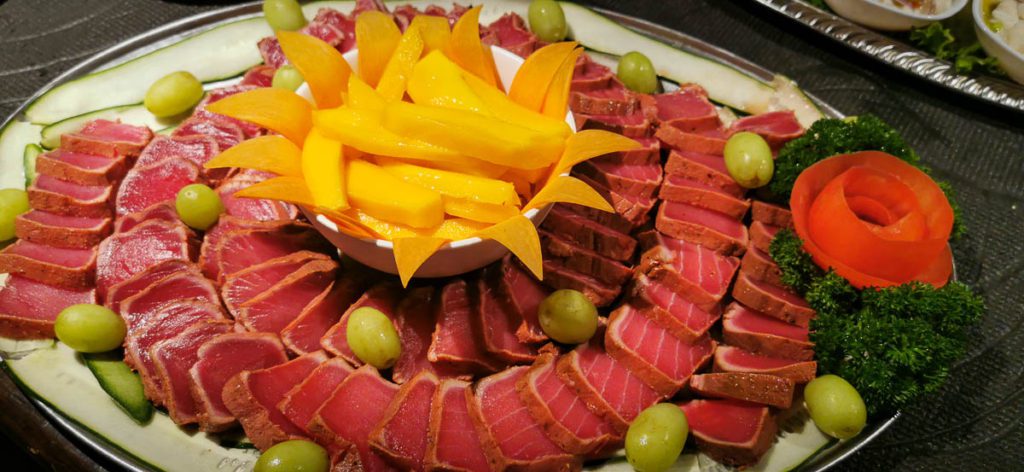
The island barbeque night was also memorable, but unfortunately, it was pouring rain that evening!
As with all Aggressor boats, all soft drinks, juices, beer, and wine are complimentary.
Tea, coffee, and snacks are also available at all times.
I always bring snacks when I travel on liveaboards but ended up not eating anything I had brought. The food was great, and I did put on weight during the 10 days!
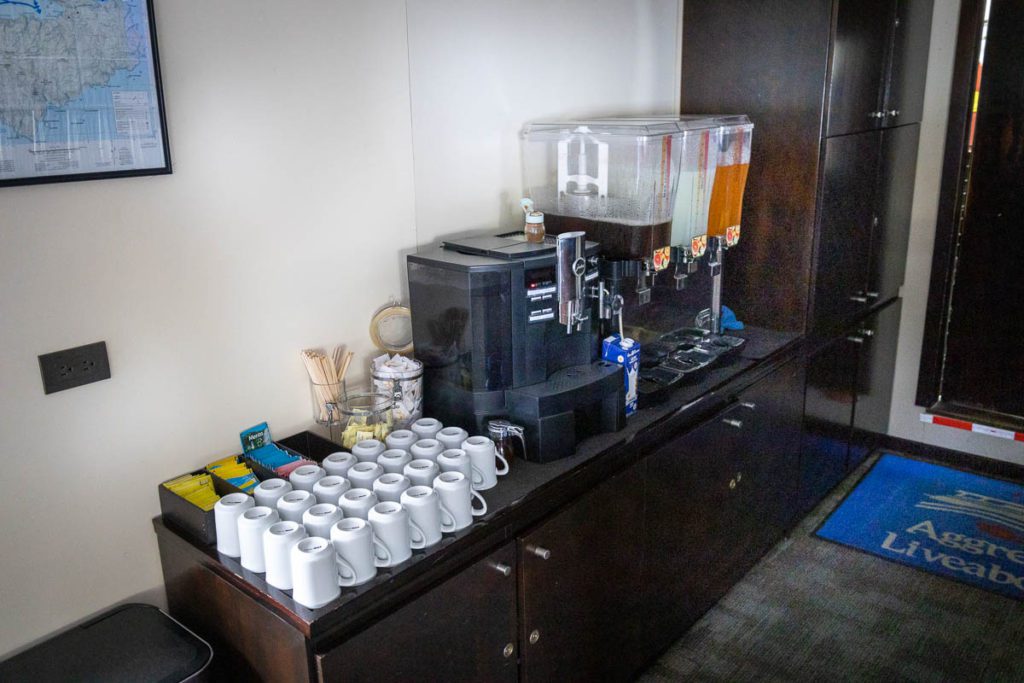
Internet connection during a diving trip to Cocos island
There is no internet on board the Okeanos Aggressor, but it is possible to get a weak connection with your phone.
There is a small antenna near the ranger stations on Cocos Island, so you will get a weak signal while the boat is moored at Wafer Bay during your cruise.
The antenna is from Costa Rican provider Kolbi Ice. My roaming plan didn’t allow me to use it, so I had to buy a Kolbi Ice sim card while on the mainland.
TIP: kolbi Ice is the only network provider that will work in Cocos Island
The signal is very weak. It is suitable for phone calls and SMS. I was able to receive and send WhatsApp messages with patience. And with even more patience, I was able to receive my emails on Gmail. (count about 30 minutes for a message without attachment)
Tip: The connection works best if you are outdoors and high on the boat. It wouldn’t work at all in the cabins.
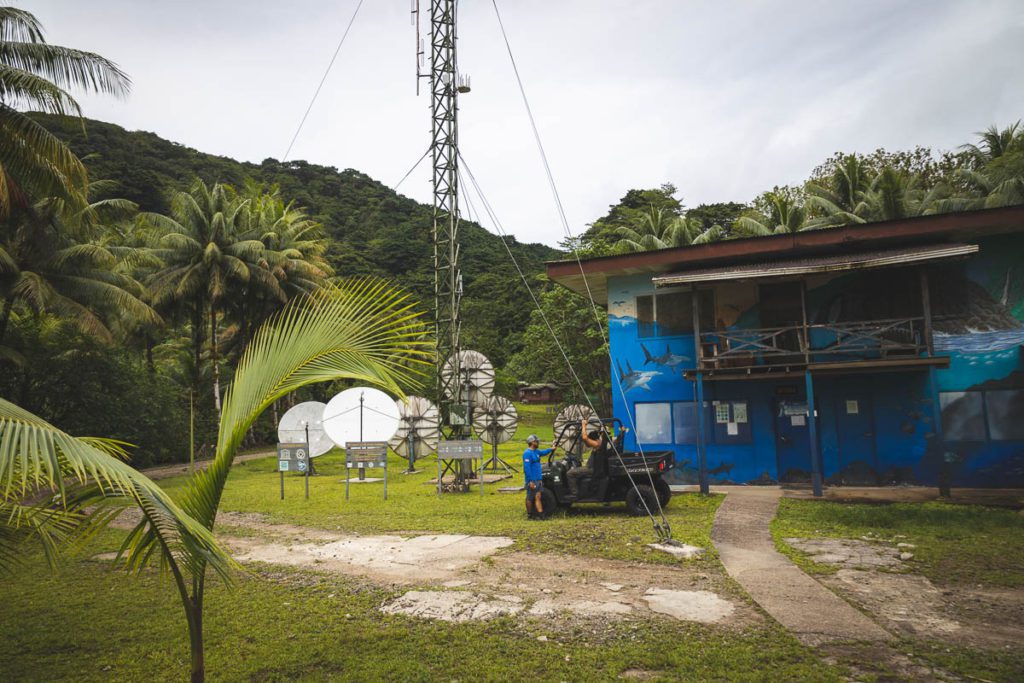
Concluding my review of the Okeanos Aggressor liveaboard to Cocos Island
Cocos is an extraordinary place for diving. It is probably the best place in the world to see hammerheads consistently. The schools of fish and the number of other sharks are also impressive. Don’t go there if you are looking for pretty corals or nudibranchs! It is a hard place to get to, so few people get to visit, but it is really worth the effort. The Aggressor Okeanos 2 is a great boat with an awesome team that will make you want to come back to Cocos. I had a great time and highly recommend that trip.
Make sure you book well in advance as trips to Cocos island are limited and often fully booked. You can book on the Aggressor’s website
For more information about Aggressors liveaboard, read my review of the Aggressor South Egypt and Belize.
If you want to dive with hammerheads, another great place is the Banda islands in Indonesia in October and November. You can read more about my trips with Ilike , Neomi cruises , and Sea Safari 6 liveaboard .
Leave a Comment Cancel Reply
Your email address will not be published. Required fields are marked *
- Stop overpaying for hotels! To find the cheapest price on hotels, I use HotelCombined which you can access here. They allow to compare the price of websites like Agoda, booking or Expedia and the prices are often very different depending on what website to use. So stop overpaying for hotels and book here .
- Never leave without travel insurance . Get affordable coverage from World Nomad by clicking here
- If you need airport transfer or local transfer, check Bookaway . They offer both private cars and public transfer and have lots of options
- I book my activities and tours with GetYourGuide , they have a good tour selection and their tours are refundable up to 24h in advance.
- If you need a visa , get assistance processing it at ¡Visa.
- Find creative flight itinerary. To book flight, Kayak is a great website to find the cheapest options. They usually have more options than google travel as also show flight combinations between airlines.
ThisisLuxurytravel© 2021 - All Rights Reserved
Get up to 50% off your next trip, dreaming of a diving liveaboard cruise.
You might not be thinking of booking a diving cruise right now but if you subscribe to our promo email, you will never miss the next great deals for when you want to take your next trip!

- Destinations
Liveaboards
- Group Trips
- Personalized Dive Vacations
- Dive Travel 101
- Travel Blog
- Reserve Now
- Call 1.888.995.DIVE
- Travel Insurance

Okeanos Aggressor II
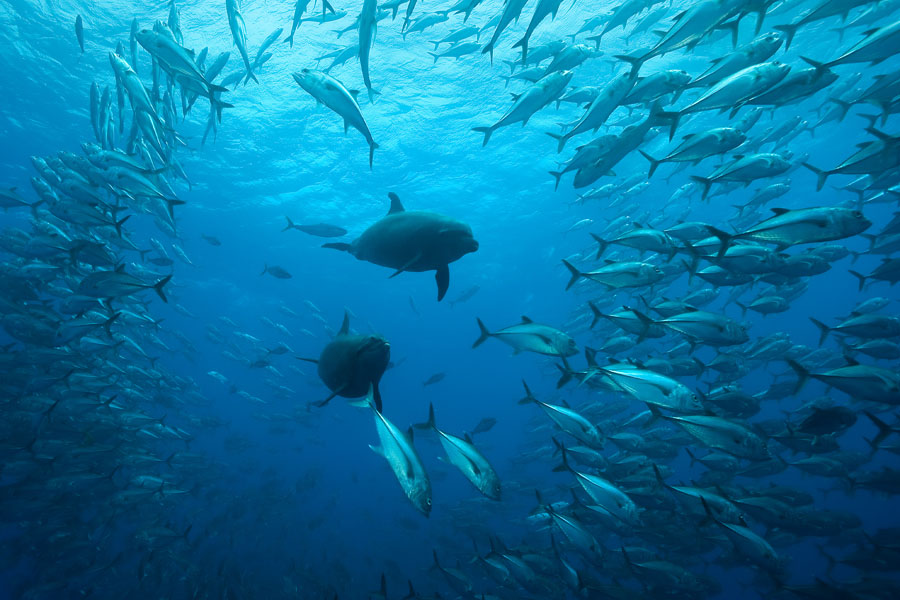
Costa Rica & Cocos Island
An eco-tourism haven, Costa Rica has much to offer for the adventurous traveler: From volcanoes to jungles, river rafting and hiking. Diving is done off the Pacific Coast and reef sharks, manta rays, hammerheads are just a few examples of the unpredictable, big marine life you will see.
While not as well-known as other diving locations, Costa Rica is gaining notoriety as a diving destination worth a visit due to the diversity of this small country. Costa Rica is best known for its beauty, eco-friendly environment, gorgeous waters, tropical weather, and the amazing surroundings. Divers and nature lovers come from all points of the globe to Costa Rica to view the wildlife, lush surroundings, and underwater world. While Costa Rica is a small country, it contains 4% of all species that live on earth.

Best Time of The Year For Diving In Costa Rica
Diving in Costa Rica is enjoyable and warm year-round so you can dive comfortably any time. May to November is the rainy season, but also the warmest time of the year and tends to have better visibility. Diving from December to April will give you more of an opportunity to enjoy the manta rays that call Costa Rica home.
How To Get To Costa Rica
Costa Rica is located between Nicaragua and Panama in the southern part of Central America and is easy to get to whether you fly or drive. From most anywhere in the United States you can get in your car and drive to Costa Rica if you are into road trips. Most people prefer to fly and non-stop flight times to San Jose Costa Rica average: 6 hours from Los Angeles, 3 hours from Miami, and 8 hours from New York as an example. Most liveaboards depart from Puntarenas located 70kms (43 miles) from San Jose airport with bus or shuttle transfers available.
As the number one “green” country in the world, Costa Rica makes saving its natural resources a priority. This, as well as having a diverse and lavish marine life, makes for good diving conditions and nice visibility.
While there are some wrecks that you can dive, and a few caves, Costa Rica is best known for large manta rays, hammerheads, white tip sharks, whale sharks, and fish which vary in size from minute to immense pelagic. You can also expect to see turtles, dolphins and almost 60 different kinds of crustaceans. The only coral reef is in the eastern portion of Costa Rica and while an earthquake caused some damage to it, divers can still find 35 species of coral, 140 species of mollusks and over 120 species of fish, and this is just a small sampling of diving in Costa Rica.
While you can shore dive in certain areas, the best way to scuba dive in Costa Rica is by liveaboard and several liveaboard outfits make weekly trips. A bonus to diving from a liveaboard is that it has easier access to more remote locations with better visibility than shore diving. There are also dive resorts in Costa Rica that offer Costa Rica Scuba diving packages, making it much easier to plan a Costa Rica diving vacation with discounts, itineraries and guided dives on the day diving boats.
Where to Dive in Costa Rica
There are many locations to go diving in Costa Rica. The more well known areas include:
A special treat is a liveaboard trip to remote Cocos Island. A unique sanctuary 500 km off the coast of Costa Rica, Cocos Island is probably the best-known dive site around Costa Rica. Declared by UNESCO to be a World Heritage Site, it teems with a wide variety of marine life, but the main attraction here are the Hammerhead Sharks which are always concentrated together in the area and can number in the hundreds.
Cano Island — second in notoriety only to Cocos Island, Cano Island is a mere 12 km off the shore of Costa Rica. Keep an eye out for the humpback whales and playful dolphins while making your way to the Island. Explore the underwater caves and magnificent corals on the 15-foot reefs, while diving beside moray eels, stingrays, dolphins and even a shark or two. In addition, the Bajo Del Diablo offers a formation of underwater mountains.
Paraiso — located 8 km southeast of the town of Cartago, which is almost in the dead center of Costa Rica, Paraiso is the place to see Blue Stripe Snappers, parrotfish and puffers. While it is always a good idea to keep your eyes on the barracuda, take comfort in the fact that they are more interested in the horse-eyed jacks in residence.
Gulf of Papagayo — located near the Liberia International Airport, and home to a number of resorts, there are approximately twenty different sites to dive. Colonies of Rocky Coral provide the backdrop for the white tip shark, southern rays, eagle rays, eagle tiger moray, sea urchins, and octopus, which call the area home.
While Costa Rica offers diving as one of its main attractions, there are other things to do as well. There are areas that offer kayaking, canoeing, white water rafting, parasailing, and whale and dolphin watching. In addition, land friendly activities include mountain biking, bungee jumping, zip lines, horseback riding, hot air ballooning and golf.
Don’t Miss
True nature lovers cannot miss a canopy tour. Costa Rica is world renowned for its Ecotourism and the Canopy tour highlights Costa Rica’s unique ecosystem. It is best viewed and enjoyed from above the canopy of the trees, which holds the richest diversity of life in Costa Rica. With a panoramic view from above, visitors can enjoy views of volcanoes, the ocean, mountain ranges, and the incredible wildlife nestled in the trees such as toucans and monkeys. The tours can be taken on a zip line or you can choose to traverse by using the suspension bridges.
Cocos Island
Uninhabited, lush, wild, beautiful and untouched this island paradise is located 275 miles southeast of Costa Rica. Accessible only by liveaboard dive boat, the rocky pinnacles surrounding Cocos Island are beacons for big animals and big action. Divers visiting the region are treated to a hike through the pristine jungle and a swim under one of the slands many waterfalls.
Cocos Island presents the same diving challenges as any other Pacific, Indian or Red Sea diving location. Cocos, however, is not recommended for inexperienced divers because it is an open ocean destination that requires advanced open water diving skills. Most dives are at depths deeper than 60 feet/18 meters. At Cocos, currents and visibility can be entirely different in just a few hours.
A world Heritage Site, the island has only two bays with safe anchorages and sandy beaches: Chatham is located on the northeast side and Wafer Bay is on the northwest. Just off Cocos are a series of smaller basaltic rocks and islets.
Among Cocos Island’s many attributes is a startling degree of biodiversity. This Island’s world-renowned waters explode with life, including innumerable white tip reef sharks, schooling hammerhead sharks, dolphins, mantas and marbled rays, giant moray eels, sailfish, and of course the occasional whale shark. Other common encounters are large schools of jacks and tuna, silky sharks, silver tip sharks, marlin, Creole fish, green turtles and octopus.Cocos Island is also home to at least 27 endemic fish species including the exotic rosy-lipped batfish. The island is also home to some 25 species of moss, and 85 species of fungus. There are upwards of 87 bird species, including the famous Cocos Island cuckoo, finch and flycatcher. There are 362 species of insects, of which 64 are endemic. Two native reptiles are found only on the Island.
Beneath the waterfalls and in the rivers, are freshwater fish that mystify scientists by their very existence. Because of its remote location and abundance of fresh water, Cocos has, throughout history, been a favorite re-supply station for pirates, whalers and sailors.
Early visitors left pigs on the island as a self-perpetuating source of fresh meat. To this day feral pigs and deer abound.
Group Adventures
None Found...
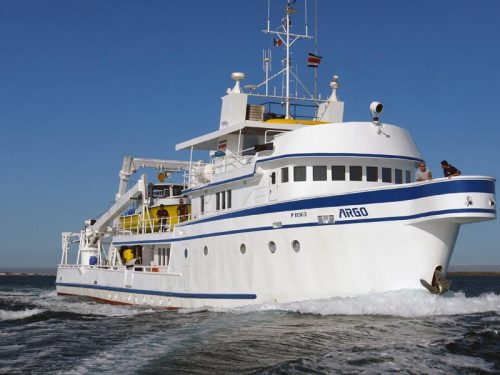
We currently do not feature any resorts in this destination. Please contact us at [email protected] to discuss your options.
View All Resorts
Information Request Form
* Indicates required fields.
Trip Type & Name *
First Name *
Last Name *
Phone Number
Local Dive Shop (if applicable)
Preferred Departing City
How Many In Party?
Additional Comments
Sign me up for your newsletter while I'm here
PRIVACY POLICY | TERMS & CONDITIONS
- Komodo Islands
- Raja Ampat Liveaboard
- Bunaken, Manado
- Gili Islands, Lombok
- Lembeh Strait
- Papua New Guinea
- Best Diving Centers in Jakarta
- Kapalai, Sabah
- Langkawi Island
- Layang Layang
- Mabul Island
- Mataking Island
- Perhentian Islands
- Tioman island
- Best Diving Centers in Singapore
- Koh Phi Phi
- Similan Islands
- Similan Islands Liveaboard Reviews
- Surin Islands
- Anilao, Batangas
- Bohol Island
- Boracay Island
- Coron, Palawan
- Malapascua Island
- Puerto Galera
- Maldives Liveaboard
- South Korea
- Cayman Islands
- U.S. Virgin Islands
- St. Kitts and Nevis
- Turks & Caicos
- Saint Martin
- Dominican Republic
Cocos Island Costa Rica
- Bay Islands Honduras
- British-Columbia
- Eastern Canada
- West Coast USA
- Yucatán, Mexico
- Baja California, Mexico
- Red Sea Liveaboard Reviews
- Sharm El Sheikh
- South Africa
- Great Barrier Reef
- Great Barrier Reef Liveaboard Reviews
- Ningaloo Reef
- Port Douglas
- Whitsunday Islands
- New-Zealand
- Solomon Islands
- French Polynesia
- Yap & Chuuk (Truk)
- Liveaboard Deals
- All Liveaboards
- Diving Jobs

- › Maldives
- › Indonesia
- › Thailand
- › Malaysia
- › Philippines
- › Australia
- › Red Sea
- › Liveaboards
- › Liveaboard Special Offers
- › Maldives Liveaboard
- › Raja Ampat
- › Cocos Island
- › Similan Islands
- › Komodo Islands
- › Great Barrier Reef
- › Mexico
- › Red Sea, Egypt
- › Burma
- › Palau, Micronesia
- › Fiji
- › Belize
- › Cuba
- › All Liveaboards
Cocos Island Costa Rica Travel Tips
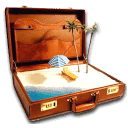
Cocos Island North Shore by Clifton Beard
Costa Rica’s Cocos Island National Park is located 340 miles (550 km) off the Pacific coast of Costa Rica. This remote location’s only tourist activity is by liveaboard boats, primarily Cocos scuba diving liveaboards . Entry to the island is by permit only and there is no accommodations on the island except for the quarters of the dozen park rangers.
Table of contents
- Cocos Island Costa Rica travel
Where to stay?
- Activies and Excursions
Health and Safety
- Where is Cocos Island Costa Rica?
- Getting there
- Getting around
- Photos Cocos Island Costa Rica
- Best dive spots
Scuba diving
I usually use this website to book in advance my hotels in Cocos Island Costa Rica as they usually have the lowest rates I find. I like it because it's free to cancel and change the dates.
Liveaboard vessels are the only option to visit the island. Some of the trips are done in cooperation with scientific research programs.
Activities and excursions in Cocos Island Costa Rica
Scuba diving is the primary focus of the liveaboards that visit the national park. Most try to provide a land excursion that includes a hike to one of the great waterfalls and swimming in the pool at the base. The hikes are guided by the park rangers and the visitors can also learn about the unique wildlife and fauna.
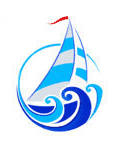
There are no health facility on the island so it is critical that health insurance include evacuation coverage. Dive insurance is required for all the liveaboards. Additional, some of the liveaboards require a special evacuation policy. These policies are around $30, and the dive operator can contact directly.
If you are planning an upcoming dive trip or travelling to Cocos Island Costa Rica, it is a really good idea to invest in travel insurance for scuba diving, because you never know what could happen and when you might need it (because accidents do happen!). I recommend this diving insurance as they offer worldwide coverage and focus on providing scuba divers a quality insurance and medical assistance service.
Where is Cocos Island Costa Rica located in the world?
Cocos Island (Spanish: Isla del Coco) is approximately 550 km (342 mi) from the Pacific shore of Costa Rica . The island is designated as a National Park. It is a district of Puntarenas Canton of the province of Puntarenas, where the dive boats depart from. Scuba Diving is the Cocos Islands, Costa Rica , is considered as some of the best in the World!
How to get to Cocos Island Costa Rica?

San Jose Airport By Alonso Jiménez Quesada (Own work) [CC BY-SA 3.0], via Wikimedia Commons
Do I need a visa for Cocos Island Costa Rica?
Citizens of the United States of America, Canada, Japon, Schengen Visa and/ or any country of the European Union do not need a visa to enter Costa Rica. They require just a valid passport and an outbound ticket. Citizens of other nations will need a visa, however, if they have a valid visa for any of the countries above, then they do not require a visa.

Getting Around
Transportation from San Jose to the liveaboard is generally arranged by the liveaboard company. Pick up times will vary as they depend on the liveaboard departure which is based on tide tables.
Cocos Island is a destination for the scuba diver who wants something that they can not get anywhere else in the world.
Cocos Island Costa Rica Photos
You will find all information about sea life, best time to visit, top dive spots, etc. in our review: Cocos Island Costa Rica Diving

Diving Reviews for this region

Costa Rica offers experienced divers some of the best diving in the world.
Costa Rica Diving Review
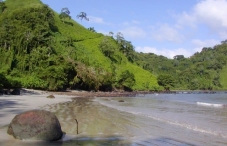
"The most beautiful island in the world." and The world's most remote diving destination with regular liveaboard service.
Cocos Island Costa Rica Diving Review
Liveaboard Reviews in Cocos & Costa Rica
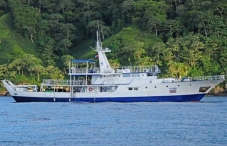
MV Okeanos Aggressor
The 33 meters liveaboard Okeanos Aggress
MV Okeanos Aggressor Liveaboard Review
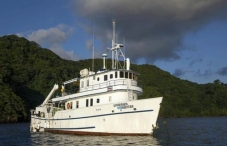
MV Undersea Hunter
Undersea Hunter Fleet are one of the pre
MV Undersea Hunter Liveaboard Review

With world-class facilities, world-class
MV Argo Liveaboard Review

The 35 meters MV Yemaya is a liveaboard
Yemaya Liveaboard Review

Cocos Island Aggressor
Journey aboard the Cocos Island Aggresso
Cocos Island Aggressor Liveaboard Review

MV Sea Hunter
Undersea Hunter fleet bought MV Sea Hunt
MV Sea Hunter Liveaboard Review

MV Okeanos Aggressor II
MV Okeanos Aggressor II is one of the ve
MV Okeanos Aggressor II Liveaboard Review
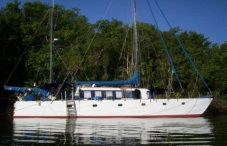
The Catamaran Inula is a unique, intimat
Inula Liveaboard Review
Cruise ship Reviews in Cocos & Costa Rica
One dive log in “cocos island costa rica”.
I would like to take a trip to Cocos Island. I am a resident of Costa Rica and A US citizen. Please send me information about a trip. I am a scuba diver also. I need to know how often you leave, I have an open schedual
Have you travelled in Cocos Island Costa Rica? Cancel reply
Have you been travelling or backpacking in Cocos Island Costa Rica? Please consider sharing your experience by leaving a comment below!
Some inspiration for your Travel Comment: How did you get there, How did you travel around, Which Hotels did you use, Did you have a good time? Your email address will not be published.
Travel Feedback
Save my name, email, and website in this browser for the next time I comment.
Diving Cocos Island Costa Rica
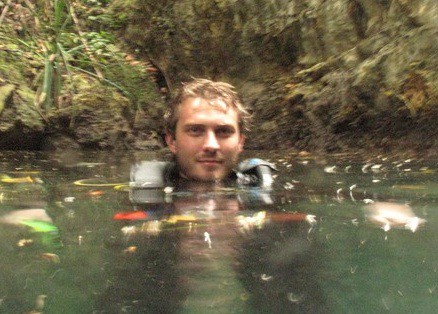
Diving in Cocos Island Costa Rica
Divezone has complete information about scuba diving and snorkelling in Cocos Island Costa Rica. For information about the best time to dive, list of fishes spotted in these waters, please check our Cocos Island Costa Rica Diving Review.


IMAGES
VIDEO
COMMENTS
Hike and Swim. Coco's Island National Park boasts one of the impressive waterfalls in Costa Rica with a swimming pool at the bottom. Don't worry about getting there because the park rangers will guide you while giving a story about the park's extraordinary wildlife. 4. Boating and Fishing.
Boat tours: yes. Average temperature range in Fahrenheit: 70 - 90. Average yearly precipitation in millimeters: 7,000. Habitat: coral reef, rainforest, beach. From the port of Puntarenas, it is a 32-36 hour boat ride to Cocos Island. Live-aboard boat tours often incude transport to Puntarenas from your hotel in San Jose.
Cocos Island Costa Rica - Island of the Sharks. Cocos—just the name elicits a knowing smile from experienced divers. Known as the 'Island of the Sharks,' it's not just about the famous schooling hammerheads where the sharks come to you, but a tiny tropical rainforest oasis in the eastern Pacific. Here, you'll encounter loads of ...
Telephone. +506 2291-1215. Directions. From San José, take the route towards Caldera to Puntarenas. From the Port of Puntarenas you can reach Isla del Coco National Park by boat. The trip takes about 36 hours. The park is open all year, every day of the week. There are two sectors: Bahía Wafer and Bahía Chatham. Universal Path.
Tortuga Island Full Day Tour from San José with Lunch. 141. Full-day Tours. from . $115.00. per adult (price varies by group size) ... This is my trip report for the Aggressor Okeanos liveaboard to Cocos Island, Costa Rica for the period of Sept 6 - Sept 16, 2015. It was our first liveaboard.
Costa Rica acquired Cocos Island in 1869. Between 1872 and 1874, the Costa Rican government ran a prison on the island; it also funded its own treasure-hunting expedition, but no golden doubloons were uncovered. ... Ten-day scuba safaris with private tour companies are available for experienced divers. Divers live on cruise ships that anchor ...
Cocos Island, Costa Rica is a remote island destination on the Pacific Ocean. This is a protected area and part of the Costa Rica national park system. The island is located 300 miles off of mainland Costa Rica and the only way to visit is with a multi-day liveaboard scuba diving tour. The real draw to this remote destination is the abundance ...
Visiting Cocos Island. Coco Island was declared a National Park and conservation area in 1978 and became a UNESCO World Heritage Site in 1997. It is located about 550 km from the Pacific Coast and takes roughly 36 hours to reach. The fantastical atmosphere made Isla del Coco the island double for Isla Nublar in the Jurassic Park movies.
Cocos Island was a significant base for sailors, explorers, pirates and adventurists since the early 1500's, and notorious pirate kings like William Davis (1684) and Benito Bonito (1819) are believed to have stashed their treasure here. The Costa Rican administration acquired the Cocos Island in 1869. During the period of 1872 and 1874, the ...
Cocos Island is hands down the best diving in Costa Rica, and one of the best locations in the world. For diving fanatics, there is no comparing Coco Island to anything else. It is one of the largest uninhabited islands in the world, but its waters are teeming with wildlife. Huge schools of hammerhead sharks and white-tipped reef sharks, whales ...
Friday - overnight in San Jose, Costa Rica at host hotel. Saturday - Meet in front of host hotel prior to pick up time (go to the last page for this information) and transfer to the Okeanos aggressor for boarding and departure for Cocos Island. Monday - Arrival to Cocos Island, diving begins. Tuesday - Sunday; Eat, Sleep & Dive.
Cocos Island National Park. Cocos Island National Park rises from the Pacific 300 miles from Costa Rica's mainland. This isolation has aided the island's preservation. In recognition of its unique forest and marine ecosystems, Cocos was designated a World Heritage Site by UNESCO in 1997. The island's heavy rains—more than 275 inches ...
Cocos Island. Isla del Coco is located in the Costa Rican Pacific Ocean, at an approximate distance of 532 km / 330 miles southwest of Cabo Blanco, Nicoya Peninsula. The Cocos Marine Conservation Area (ACMC) is one of the eleven Conservation Areas that make up the National System of Conservation Areas (SINAC) of the Republic of Costa Rica.
Cocos Island National Park is located in the Eastern Tropical Pacific, covering an area of 202,100 hectares some 530 kilometers off the Costa Rica mainland. The island itself, "Isla del Coco", also known as "Treasure Island", is the only landmark of the vast submarine Cocos Range. With a surface area of 2,400 hectares it supports the ...
Around 500km southwest of the Costa Rica mainland, Isla del Coco is a natural wonder that teems with wildlife, including the largest schools of hammerhead sharks on the planet. For that reason, divers descend from all corners, often venturing out on liveaboard trips with companies like Aggressor and Undersea Hunter. There's also some ...
Average Temperature: 76º-85º F (24º-29º C) Costa Rica, a country known for its popularity, holds a hidden treasure that remains undiscovered by many: Cocos Island (Isla del Coco). Tucked away in the vast Pacific Ocean, approximately 340 miles off the coast, this island is a true gem. Despite being a part of Costa Rica's national parks, it ...
Cocos Island (Spanish: Isla del Coco) is an island in the Pacific Ocean administered by Costa Rica, approximately 550 km (342 mi; 297 nmi) southwest of the Costa Rican mainland. It constitutes the 11th of the 15 districts of Puntarenas Canton of the Province of Puntarenas. With an area of approximately 23.85 km 2 (9.21 sq mi), the island is more or less rectangular in shape.
Liveaboards depart from Puntarenas, Costa Rica, a two hour bus transfer from San Jose, Costa Rica. Travel time is approximately 40 hours to Cocos Island, 43 hours to Malpelo, and 40 hours from Cocos to Malpelo. At certain times of the year the crossing can be very rough with big swells and seasick passengers. How to scuba Dive Cocos Island
The Okeanos Aggressor II® and Cocos Island Aggressor ® depart from Puntarenas, Costa Rica. Boarding and departure depends on the tide schedule. Immediately after boarding for our Costa Rica liveaboard scuba diving adventure, the yacht departs for its 36 hour crossing to Cocos Island. Average dives per charter: 15 on 8 night; 21 on 10 night ...
Transfer to Puntarenas & begin your Cocos liveaboard. Cocos Island lies over 500 kilometres offshore and the journey takes over 30 hours to reach from Costa Rica. Your ten day liveaboard will typically include six and a half days' diving at Cocos, making three or four dives a day from a spacious tender. Divers can expect a superb array of shark ...
I spent 10 days diving Cocos island on the Okeanos Aggressor 2, and this is my review of the boat and the trip. ... Liveaboard review: Okeanos Aggressor diving trip to Cocos Island in Costa Rica. Leave a Comment / Cruises, costa Rica, ... they have a good tour selection and their tours are refundable up to 24h in advance.
Cano Island — second in notoriety only to Cocos Island, Cano Island is a mere 12 km off the shore of Costa Rica. Keep an eye out for the humpback whales and playful dolphins while making your way to the Island. Explore the underwater caves and magnificent corals on the 15-foot reefs, while diving beside moray eels, stingrays, dolphins and ...
Costa Rica's Cocos Island National Park is located 340 miles (550 km) off the Pacific coast of Costa Rica. This remote location's only tourist activity is by liveaboard boats, primarily Cocos scuba diving liveaboards.Entry to the island is by permit only and there is no accommodations on the island except for the quarters of the dozen park rangers.